
- 2 Weeks for Couple
- 2 Weeks for Family
- Thailand Lantern Festival
- Indonesia(Bali)
- South Korea
- China (HK, Taiwan)
- Itinerary Ideas
- Asia Highlights Travel Reviews
- Thailand Travel Reviews
- Vietnam Travel Reviews
- Cambodia Travel Reviews
- Japan Travel Reviews
- Myanmar Travel Reviews
- China Travel Reviews


How to Plan a Trip to Nepal
- Nepal Visas and Entry Policy
- Best Time to Visit Nepal
Best Places to Visit in Nepal
- How Long to Stay in Nepal
- How to Get Around Nepal
- Travel Cost in Nepal
Traveling to Nepal is an adventure that never fails to showcase the natural and cultural beauty of this world. Travelers are attracted by the country's immense Himalayan mountain views, jungles full of wildlife, beautiful golden temples, charming hill villages, ancient cities, and friendly people.
Nepal is a landlocked country in the Himalayas between China and India. The most popular things to do in Nepal include trekking, mountaineering, mountain appreciation/photography, and visiting temples. Nepal has a very vibrant culture that is a mixture of Buddhist and Hindu values, which can be seen in the abundance of temples and in the everyday life of the local people.
Nepal Travel Visas and Travel Restrictions
Entry policy: From March 14, 2022, Nepal has eased its entry requirements. All international visitors can go to Nepal whether vaccinated or not.
Visa policy: Most foreigners need a tourist visa to enter Nepal. However, Nepal makes getting a tourist visa quite simple by offering a visa on arrival option for Kathmandu's airport as well as all land crossings. The visa on arrival process is very quick and simple. It requires travelers to fill out a short form, which can also be filled out online 15 days before arrival to make the process even faster.
Best Times to Visit Nepal
Nepal's climate is divided into two seasons: the rainy season (May to August) and the dry season (September to April).
The best time to visit Nepal is during the "autumn" post-monsoon months (September to November) as the skies are generally clear and the views are spectacular, the visibility in the mountains is at its best and trekking conditions are great around Everest and Annapurna. Hotel prices and travel costs during this time are higher than average, and the tourist sites are a bit more crowded than usual. With Asia Highlights , you enjoy 100% refund of any payments made to China Highlights prior to 3 weeks before departure ( detail⇒ ).
Another good time to visit Nepal is in the "spring" pre-monsoon months (February to April) when the weather at high elevation is cool and good for trekking. Conditions are often less clear this time of year due to crop burning in the Kathmandu Valley.
"Summer" in Nepal is the monsoon season (April to September). The monsoon rains make for super blooms of beautiful Himalayan flowers, but also cause landslides and dangerous/unpleasant travel conditions (mud, leeches) throughout the country. Low prices match inconvenient travel opportunities.
Temperatures of the "winter" mid-dry-season (December to February) in Nepal often get below freezing in high elevation areas of the country, which can make for difficult trekking conditions.
Conversely, lowland areas such as Kathmandu Valley can be as warm as 20°C (68°F) in the winter months.
Discover real reviews of Highlights Travel Family 's best-rated service across trusted platforms.
Regarded as a trekkers' paradise, the two most popular places to go in Nepal are Mount Everest and Kathmandu, there is much more of this beautiful country to explore on foot outside these two destinations.
1. Kathmandu — Capital, Temples and Shrines
Kathmandu is the capital city of Nepal and the place where most travelers begin their journey. This is a city with chaotic narrow streets that are packed full of gorgeous temples and shrines. Explore the timeless cultural and artistic heritage to learn more about Kathmandu. Include the maze of shrines in the city center, and then wander around the shopping street (Thamel), which is full of handicrafts and great food.
From Thamel Street, you can walk to Durbar Square (an ancient palace), where the city's king was crowned. Spend a half day to observe the grand architecture there, and then have a cup of coffee and rest in the nearby restaurants or shops.
2. Pokhara — Natural Beauty and Adventure
Pokhara is a lakeside city near the Annapurna region. This city has long been famous for its spectacular scenery and abundance of adventure activities. There you can relax while taking in the views of mountains over bobbing boats on Fewa Lake, or participate in mountain biking, paragliding, and trekking.
Pohkara is the starting point for many famous treks, including the challenging Annapurna Base Camp Trek. The two-day Poon Hill Trek offers visitors incredible views of Annapurna in the distance, and the Annapurna Circuit Trek is a less demanding hike that can be taken at your own pace.
Pokhara is also home to the famous World Peace Pagoda, where you can have a panoramic view of the Annapurna range, Pokhara city, and Fewa Lake.
3. Patan — Ancient City, UNESCO World Heritage Sites
Patan, also known as Lalitpur — 'The City of Beauty', has a history dating back to the year 250 BC. Although Patan is only around 5 kilometers (3 miles) from Kathmandu, the city was a fiercely independent kingdom for most of its history and has managed to retain its unique culture.
The architecture of this entire city is based on the principles of the Buddhist Wheel of Righteousness and Patan has long been a melting pot of Hindu and Buddhist beliefs.
While you are in this ancient city make sure to explore the gorgeous temples, royal palaces, and statues of Durbar Square, and check out Patan Museum. This city is definitely worth a visit.
4. Nagarkot — Panoramic Himalayan Views
Nagarkot is located close to Bhaktapur and is well-known for its stunning views of the surrounding Himalayas. There are eight ranges that can be seen from this small mountainous town: Everest, Annapurna, Manaslu, Ganesh Himal, Lantang, Jugal, Rolwaling, and Numbur. You can also have a panoramic view of the Kathmandu Valley from this small town.
The town itself is surrounded by dense pine forests and is a quiet and peaceful place full of boutique and luxury hotels with mountain views.
Try to catch the dreamy views of sunrise and sunset on a clear day, the town also offers some short treks and mountain biking trails.
5. Chitwan National Park — Nature, Wildlife
If you want to enjoy the natural beauty and wildlife of Nepal, then Chitwan National Park should be on your list. As one of the most popular national parks in Asia, Chitwan National Park is the best place to observe Asia's rare and endangered species, such as the Bengal tiger and one-horned rhinoceros.
Besides Bengal tigers and rhinoceroses, there are elephants, leopards, Indian bison, and sloth bears to discover in the park. If you want to spend more than a day in the park, you can live in luxury lodging at the edge of the park, or in the affordable accommodation in a nearby village.
How Long to Stay in Nepal — Sample Itineraries
Nepal is a popular destination for trekking lovers. Your traveling days requirement will depend on your interests and where you want to go. Most of our clients spend 8–9 days to cover the essential highlights of Nepal.
See our 9-day Classic Nepal tour sample itinerary: Kathmandu (3 days), Pokhara (2 days), Chitwan (2 days), Nagarkot (2 days).
Top South Asia Tour Itineraries Including Nepal
Most of our clients prefer to include Nepal in a 2-to-3-week South Asia trip. The most popular tour itineraries usually include India, Nepal, and Bhutan. Get some inspiration to explore Asia from our 14-Day India, Nepal, and Bhutan Tour .
See more on our How to Plan an India and Nepal Trip 2024
The above sample itineraries are just for your information. You are welcomed to contact your own experienced 1:1 tour consultant for a tailor-made itinerary .
How to Get To and Around Nepal
Getting to nepal.
The best way to get to Nepal is by flight. There are direct flights available to Kathmandu from New York, Dallas, San Francisco, and Los Angeles in the US and from London, Paris, Munich, Frankfurt, and Istanbul in Europe. To make the trip to Nepal more affordable, travelers can head to India first and then fly to Kathmandu from New Delhi.
Getting Around in Nepal
The main transport from one city to another in Nepal includes planes, buses, and private vehicle. Trains are not available in Nepal.
Because of Nepal's mountainous terrain and poor infrastructure, traveling by bus around Nepal is often draining, and the bus may stop to pick up passengers everywhere too.
The best way to travel from one Nepali city to another is often by private car or jeep, which is more comfortable and faster than traveling by bus. It allows passengers the option of being picked up directly from their hotel and dropped off directly at their next hotel without the hassle of booking taxis and buying bus tickets.
By plane: Flying is another good option for traveling across Nepal. Most internal flights start or end in Kathmandu. The cities of Pokhara, Bharatpur, and Siddharthanagar all have airports. One problem with traveling by plane in Nepal is that delays and flight cancellations are very common due to adverse weather conditions like heavy rain, thick fog, strong winds, etc. (Airports in Nepal don't have the latest technology and so planes rely on instrumental landing systems.)
Connecting with Other South Asian Countries
There are flights from Kathmandu to other main cities in South Asian countries, including India, Bhutan, and Thailand. Most of our clients visit India before their trip to Nepal. They can fly to Kathmandu from Delhi, Varanasi, Mumbai, and Kolkata. Delhi offers the most flight options at the best prices.
From India, it is also possible to cross into Nepal overland. This journey requires taking a bus or train to the India-Nepal border. Trains from Delhi to the Sonauli border crossing often take around 14 hours.
Travel Costs for Nepal
For travelers from Europe and America, Nepal is the most affordable destination in South Asia. General speaking, if you are looking for a comfortable trip (mid-range hotels) in the top destinations in Nepal, it will cost between 10,000 and 12,500 Nepal rupees (US$80–100) per day per person.
The following are some cost estimates for different travel styles:
- For backpackers, the budget needed is around 30–50 USD/day per person (hostels, street food, tuk-tuks, rickshaws).
- For a medium budget, Nepal costs around 80–100 USD per day per person (3/4-star hotels, sit-down restaurants, taxies).
- For a higher standard and a more refined experience, US$100–150 per day per person is needed (4/5-star hotels, nice meals, private guide, and transfers).
Traveling Nepal with Asia Highlights
Want to experience the rich culture and stunning peaks of Nepal? We at Asia Highlights can help you plan your dream trip, tailor-made to suit your travel wants and goals. Leave the planning and stress to us; just relax and enjoy your journey.
Why Asia Highlights (10,000+ reviews & 98.8% 5-star rating)
- Save Your Time:
- Less research, more enjoyment!
- Real-time 1V1 expert planning
- Maximize Your Flexibility:
- Personal local guide and ride
- Explore at your own pace
- Celebrate Your Journeys:
- Specially-crafted family adventures
- Celebrate milestones with style!
Get Inspired with Some Popular Itineraries
At Asia Highlights, we create your kind of journey — your dates, your destinations, at your pace. You can have any trip tailor made for your travel.
More Travel Ideas and Inspiration
Sign up to our newsletter.
Be the first to receive exciting updates, exclusive promotions, and valuable travel tips from our team of experts.
Why Asia Highlights
Where can we take you today.
- Middle East
- African Safari
- Travel Agents
- Loyalty Program
- Our Differences
- Privacy Policy
Address: Building 6, Chuangyi Business Park, 70 Qilidian Road, Guilin, Guangxi, 541004, China
Cost of a Trip to Nepal & the Cheapest Time to Visit Nepal
The average price of a 7-day trip to Nepal is $1,135 for a solo traveler, $2,024 for a couple, and $688 for a family of 4 . Nepal hotels range from $25 to $146 per night with an average of $41, while most vacation rentals will cost $30 to $280 per night for the entire home. Average worldwide flight costs to Nepal (from all airports) are between $851 and $1,699 per person for economy flights and $2,672 to $5,335 for first class. Depending on activities, we recommend budgeting $22 to $45 per person per day for transportation and enjoying local restaurants.
See below for average , budget , and luxury trip costs. You can also look up flight costs from your airport for more tailored flight pricing.
The Cheapest Times to Visit Nepal
On average, these will be the cheapest dates to fly to Nepal and stay in a Nepal hotel:
- January 8th to March 25th
- May 7th to May 27th
- August 6th to October 21st
The absolute cheapest time to take a vacation in Nepal is usually mid to late September .
Average Nepal Trip Costs
Average solo traveler.
The average cost for one person to visit Nepal for a week is $788-$2,183 ($113-$312 per day)
Food, Travel, and Sightseeing : $22 to $45 per day for one person’s daily expenses
Flights : $448 to $1,574 for economy
Lodging : $35 to $49 per night for one 2 or 3-star hotel room
or $31 to $38 per night for a 1-bed vacation rental
Average Couple’s Trip
The average cost for a couple to visit Nepal for a week is $1,389-$4,079 ($198-$583 per day)
Food, Travel, and Sightseeing : $44 to $91 per day for two people’s daily expenses
Flights : $895 to $3,148 for economy
Average Family Vacation
The average cost for 4 people to visit Nepal for a week is $2,690-$8,159 ($384-$1,166 per day)
Food, Travel, and Sightseeing : $89 to $182 per day for four people’s daily expenses
Flights : $1,791 to $6,297 for economy
Lodging : $69 to $98 per night for two 2 or 3-star hotel rooms
or $46 to $56 per night for a 2-bed vacation rental
Traveling Cheap to Nepal
How cheap can you make a vacation to Nepal? The cheapest trip to Nepal is about $93 per person per day for travelers willing to take standby flights, deal with inconvenience, and otherwise limit travel expenses. About 43% of rentals are available in the $0 to $100 range for an entire place, and vacation rentals can be booked for as low as $16 per night. These inexpensive rentals must be booked as early as possible and may not be in the most desirable areas. 1-star hotels are more likely to be available, with rooms starting at around $21.
Even cheaper trips are possible depending on where you live and whether you can drive. Check the cheapest times to fly for more saving ideas.
Budget Solo Traveler
The lowest cost for one person to visit Nepal for a week is $651-$2,082 ($93-$297 per day)
Food, Travel, and Sightseeing : $11 to $22 per day for one person’s daily expenses
Lodging : $21 to $25 per night for one 1-star hotel room
or $29 to $59 per night for a 1-bed vacation rental
Budget Couple’s Trip
The lowest cost for a couple to visit Nepal for a week is $1,175-$3,810 ($168-$544 per day)
Food, Travel, and Sightseeing : $22 to $44 per day for two people’s daily expenses
Budget Family Vacation
The lowest cost for 4 people to visit Nepal for a week is $2,351-$7,448 ($336-$1,064 per day)
Food, Travel, and Sightseeing : $44 to $89 per day for four people’s daily expenses
Lodging : $42 to $49 per night for two 1-star hotel rooms
or $44 to $88 per night for a 2-bed vacation rental
Overall it is very easy to travel to Nepal cheaply.
The Cost of a Luxury Nepal Trip
There is no true ceiling on the cost of a luxury trip, so our estimates are based on what most people do in Nepal.
Luxury Solo Traveler
The high-end price for one person to visit Nepal for a week is $1,877-$7,704 ($268-$1,101 per day)
Food, Travel, and Sightseeing : $45 to $91 per day for one person’s daily expenses
Flights : $1,130 to $3,851 for first class
Lodging : $72 to $146 per night for one 4 or 5-star hotel room
or $268 to $536 per night for a preferred vacation rental
Luxury Couple’s Trip
The high-end price for a couple to visit Nepal for a week is $3,322-$12,200 ($475-$1,743 per day)
Food, Travel, and Sightseeing : $90 to $183 per day for two people’s daily expenses
Flights : $2,260 to $7,703 for first class
Luxury Family Vacation
The high-end price for 4 people to visit Nepal for a week is $6,644-$22,869 ($949-$3,267 per day)
Food, Travel, and Sightseeing : $180 to $366 per day for four people’s daily expenses
Flights : $4,520 to $15,405 for first class
Lodging : $144 to $293 per night for two 4 or 5-star hotel rooms
or $396 to $817 per night for a preferred vacation rental
Nepal Hotel Prices
The cost of staying in Nepal is much lower than the average city. On average hotels are less expensive than vacation rentals. Luxury vacation rentals are more expensive in Nepal due to very high property costs. The graphs below show how much cost can vary depending on the type of experience you’re looking for.
Nepal Lodging Cost by Star Status
The average price for the class of hotel is on the (y) axis. The hotel class (out of 5 stars) is on the (x) axis.
Prices are based on Nepal hotel averages and may not reflect current prices. In some cases, we extrapolate prices to estimate costs, and hotels with your desired star rating may not be available.
Vacation Rental Prices
The percent of vacation rentals in the price range is on the left (y) axis. Price range is on the bottom (x) axis.
There are a healthy amount of vacation rentals serving all budgets in Nepal.
Flight Costs to Nepal
Averaging flights around the world, prices go from a high of $1,699 average in late July to a low of $851 in mid to late September. Median flight price is $888. These prices are based on millions of flights. For Nepal our data includes thousands of originating airports, and hundreds of airlines. The area has much more variance in price compared with other locations.
Average Flight Cost by Season
Average flight cost by day of week.
The cheapest day to fly in is typically Monday, and the cheapest day to fly back is usually Monday. Click here to see data for the cost of flights from your airport. In Nepal, the difference between the cheapest and the most expensive week is about $848, so you can easily save about 100% simply by using our free flight guides and booking in advance.
Daily Expenses Budget
Daily vacation expenses vary more based on what you’re interested in doing. A fine dining restaurant with drinks around Nepal can easily cost $166 per person or more, while a standard nice meal might be about $11 per person. Private tours can cost $333 per day, but self-guided tours to see the outdoor sights can be free. Costs vary wildly, so recommendations are made based on the cost of living and averages we see for this type of vacation.
Other Nepal Guides
Travel costs nearby.
- Tansen, Nepal
- Pokhara, Nepal
- Gandaki Zone, Nepal
- Lekhnath, Nepal
- Butwal, Nepal
- Kawasoti, Nepal
- Tilottama, Nepal
- Ghachok, Nepal
- Devachuli, Nepal
- Meghauli, Nepal
Travel Costs in Popular Places
- Ko Lanta, Thailand
- Beijing, China
- Mt. Hood National Forest, the United States
- Travel Planning Guide
How much does a trip to Nepal Cost?

How much money should you budget for your trip to Nepal?
- How much does a one-week trip to Nepal cost?
- How much does a two-week trip to Nepal cost?
- How much does a one-month trip to Nepal cost?
- Hostel Prices
- Hotel Prices
The Cost of a Trip to Nepal
For a trip to Nepal, you should plan for daily costs anywhere between $14 to $126. If there's two of you traveling, your daily expenses could range from $28 to $253. These price ranges are based on the average daily spending of $40 (NP₨5,296) per person which comes from the travel expenses of other visitors. These costs include food, accommodation, sightseeing activities, and getting around locally. Keep in mind, though, these figures can vary somewhat based on your individual travel style, level of luxury, and chosen activities. Destinations across the country, such as Kathmandu and Pokhara, might might vary somewhat from the overall average price, but they usually stick close to this range. Read on for a breakdown of travel typical expenses as well as a comparison of tour prices versus Independent travel.
If you're planning an Independent trip to Nepal, budget travelers should plan to spend around $14 (NP₨1,857) per day for their trip. This average includes hostels and budget hotels, affordable meal options, local transportation, and activities. If you're on a mid-range budget, plan for around $40 (NP₨5,296) a day which covers the cost of typical hotels, normal restaurants, and a variety of popular attractions. Luxury travelers should allow for $126 (NP₨16,826) a day, which would cover higher-end hotels, nicer restaurants, and more private tour options. All of these price ranges are based on our extensive travel cost data for Nepal from other travelers, along with hotel and tour data from travel companies.
How much does a one week trip to Nepal cost?
On average, visitors to Nepal spend between $98 and $885 for their week-long adventure, with the average being $279. This covers sightseeing, local transportation, food, and accommodations. With a duration of one week, you'll have the opportunity to explore one, two, or even three locations within Nepal, depending on the level of depth you desire for your visit. Some of the most popular places to consider exploring are Kathmandu and Pokhara . It's important to note that these figures are averages and can vary based on personal preferences and choices. Ultimately, the goal is to create a memorable and enjoyable experience tailored to your specific interests.

How much does a two week trip to Nepal cost?
With two weeks, you should budget between $195 and $1,770 for your trip to Nepal. The average price for a two week trip is $557. Two weeks will allow you enough time to visit between three and five places. If you're on a budget, you might want to consider some of the more affordable places such as Pokhara.
How much does a one month trip to Nepal cost?
When embarking on a month-long trip to Nepal, expenses can range from $419 to $3,792, with an average cost falling around $1,194. For those fortunate enough to have a full month, considering a vacation rental with a kitchen for at least a portion of your stay can help save money with meals. Backpackers often opt for hostels due to their affordability and the added benefit of a social vibe.
Hostel Prices in Nepal
With more than 80 hostels in Nepal, the average price is $5 per night for a dorm bed. Hostels are a terrific option for younger independent travelers looking to save money while staying social during their trip. With many types of hostels, it can be overwhelming to sort out the best places, though. Our analysis of the hostels in Nepal not only found the average price, but also uncovered some surprises about the overall quality, amenities, and atmosphere of hostels in the region. You can see more details from our analysis about typical hostel prices in Nepal here .
Here are a few sample prices from popular hostels in Nepal.
- $6 for a dorm bed at Elbrus Home in Kathmandu more details
- $6 for a dorm bed at Kiwi Backpackers Hostel Pokhara in Pokhara more details
- $6 for a dorm bed at The Glasshouse Hotel in Chitwan more details
Hotel Prices in Nepal
You'll find a wide range of hotel options across Nepal. Below are prices for some of the destinations, and for more details see our analysis of hotel costs in Nepal .
Shambaling Boutique Hotel
Temple tree resort & spa pokhara.

Should you do an organized tour or travel independently in Nepal?
Organized tours and independent travel are essentially the two main ways to plan a trip to Nepal. Organized tours offer a convenient and hassle-free experience, with travel experts handling all the logistical details and the added benefit of an expert guide imparting valuable insights. This option is favored by those who appreciate the convenience and ease provided by tours that often include transportation and expert guides.
On the other hand, independent travel provides a different set of advantages, allowing for greater freedom and flexibility in customizing itineraries and exploring at one's own pace. This option appeals to individuals who value spontaneity and control, enabling them to immerse themselves in local culture on a deeper level.
Ultimately, the choice between organized tours and independent travel depends on personal preferences and travel style, considering factors such as convenience, guidance, and flexibility.
Comparing Trip Costs in Nepal
When we compare the prices of organized tours to the average costs of independent travelers, we can see that sometimes the prices are fairly even.
Tours vs. independent Travel: Pros & Cons
Organized tours.
- An expert guide familiar with the culture
- Convenient transportation
- Fellow travelers to socialize with
- Well researched activities
- Efficient and thought out itinerary
- The security of have a trip leader if something goes wrong
- Limited options
- Usually not customizable
- The fast pace often means you can’t visit one place in depth
- Usually more expensive than independent travel
- There may be limited time to interact with the local culture and community
Independent Travel
- Completely customizable
- Opportunity to visit off-the-beaten-path destinations
- Can fully immerse yourself in the local culture
- Freedom to move at your own pace
- Flexibility to change your itinerary at any time
- More affordable
- Challenging to plan an efficient itinerary
- Transportation may be challenging or inefficient
- Booking and trip planning can be a hassle
- Popular sights may sell out well in advance
- If something goes wrong, you're on your own
Are organized tours more expensive than independent travel in Nepal?
Organized tours typically average around $158 per day and provide the convenience of an all-inclusive package with one comprehensive payment. On the other hand, independent trips usually average around $40 (NP₨5,296) per day and involve individual payments for accommodations, local transportation, meals, and sightseeing. Both organized tours and independent trips have their own unique challenges and benefits, so it's crucial to thoroughly understand the aspects of each to make a fair comparison. For a detailed analysis of tour prices in Nepal, check out our comprehensive guide on tour prices in Nepal here .
Here are a few sample tours in Nepal:
- Classic Annapurna Circuit Trek ($1,350) 18 days, 22 destinations more details
- Upper Mustang Trek ($3,000) 14 days, 15 destinations more details
- Sleeping at Everest Base Camp Trek ($4,590) 17 days, 13 destinations more details
- Nepal Helicopter Tour - 7 Days ($30,000) 7 days, 11 destinations more details
- Everest Base Camp Trek 7 Days ($2,999) 7 days, 9 destinations more details
More for Nepal
If you're planning a trip to Nepal, check out these other informative travel guides.
We've been gathering travel costs from tens of thousands of actual travelers since 2010, and we use the data to calculate average daily travel costs for destinations around the world. We also systematically analyze the prices of hotels, hostels, and tours from travel providers such as Kayak, HostelWorld, TourRadar, Viator, and others. This combination of expenses from actual travelers, combined with pricing data from major travel companies, gives us a uniqe insight into the overall cost of travel for thousands of cities in countries around the world. You can see more here: How it Works .
Subscribe to our Newsletter
Coupons and discounts! Travel tips!
1 Categories averaged on a per-item basis. 2 Categories averaged on a per-day basis. For example, the Food 2 daily average is for all meals for an entire day, while Entertainment 1 is for each individual purchase. Thus, the overall daily average cost is not a summation of the individual categories.
- You are welcome to reference or display our travel costs on your website as long as you provide a link back to this page .
- For a basic link, you can copy and paste the HTML link code, or this page's address. Address Link HTML Nepal Travel Costs " disabled />

Some of the links on this website are sponsored or affiliate links which help to financially support this site. By clicking the link and making a purchase, we may receive a small commission, but this does not affect the price of your purchase.
- Privacy / Terms of Use
- Activities, Day Trips, Things To Do, and Excursions
Update April 12, 2024
Information for u.s. citizens in the middle east.
- Travel Advisories |
- Contact Us |
- MyTravelGov |
Find U.S. Embassies & Consulates
Travel.state.gov, congressional liaison, special issuance agency, u.s. passports, international travel, intercountry adoption, international parental child abduction, records and authentications, popular links, travel advisories, mytravelgov, stay connected, legal resources, legal information, info for u.s. law enforcement, replace or certify documents.
Before You Go
Learn About Your Destination
While Abroad
Emergencies
Share this page:
Travel Advisory December 18, 2023
Nepal - level 2: exercise increased caution.
Reissued after periodic review with updates to risk indicators and "if you decide to travel" section.
Exercise increased caution in Nepal due to the potential for isolated political violence .
Country Summary: Political demonstrations intended to be peaceful can sometimes escalate into violence and may be met with force by Nepali authorities.
Read the country information page for additional information on travel to Nepal.
If you decide to travel to Nepal:
- Avoid demonstrations and crowds.
- Do not trek or climb alone. The Government of Nepal requires solo or foreign independent trekkers (FITs) to use a local guide or porter while trekking in Nepal's official national parks and protected areas.
- Review the Adventure Travel Page before your trip.
- Enroll in the Smart Traveler Enrollment Program ( STEP ) to receive Alerts and make it easier to locate you in an emergency.
- Follow the Department of State on Facebook and Twitter .
- Review the Country Security Report for Nepal.
- Visit the CDC page for the latest Travel Health Information related to your travel.
- U.S. citizens who travel abroad should always have a contingency plan for emergency situations. Review the Traveler’s Checklist .
Embassy Messages
View Alerts and Messages Archive
Quick Facts
Must have six months remaining validity or more at time of entry.
At least one blank visa page (not endorsements page) required for entry visa.
COVID-19 vaccination/negative PCR test report is not required (Effective May 26, 2023)
US $5,000; Pure/raw/unworked gold and silver are strictly prohibited; Worked gold/jewelry up to 50 grams and worked silver/jewelry up to 100 grams are allowed. Indian currency in denominations greater than 100 rupees notes.
US $5,000; Pure/raw/unworked gold and silver are strictly prohibited; Worked gold/jewelry up to 50 grams and worked silver/jewelry up to 100 grams are allowed; Indian currency in denominations greater than 100 rupees notes. Nepalese currency no more than Rs. 5000.
Embassies and Consulates
U.s. embassy kathmandu.
Maharajgunj Kathmandu, Nepal Telephone: +(977)(1) 423-4000 or 423-4500 Emergency After-Hours Telephone: +(977)(1) 400-7266 Email: [email protected]
Destination Description
Learn about the U.S. relationship to countries around the world.
Entry, Exit and Visa Requirements
STRONGLY RECOMMEND: No Solo Trekking; Follow Medical Advice regarding High Altitude Mountain Sickness; Review customs policies prior to travel
The Department of Immigration rescinded all previously issued orders regarding country-specific travel limitations. All travelers regardless of vaccine status can receive on-arrival visas at the port of entry. Amendments to existing orders and new orders may be promulgated with little notice. Please continue to monitor this space and local media for additional information.
Effective May 26, 2023, travelers entering Nepal from abroad by air or land are no longer needed to submit certificate of full vaccination against COVID-19. A negative PCR test report for COVID-19 is not required.
Quarantine is currently not required for travelers regardless of their vaccine status, nationality, or recently visited locations.
Travelers departing Nepal by air are subject to health protocols of their destination country only. The airlines are responsible for ensuring passengers meet requirements of destination countries. Please consult with your airlines prior to your arrival and departure from Nepal. Please check with your airline regarding future flight availability and any necessary flight re-bookings. Operation of cargo flights, rescue flights, and evacuation flights will be carried out subject to special permission.
Requirements for Entry:
- Passport must have six months or more validity remaining at the time of entry
- One blank visa page available in passport for visa (not endorsements page)
- Nepali authorities generally allow entrance on an emergency passport printed overseas
- Visa appropriate for purpose of travel
Customs: International travelers arriving and departing Nepal via international airport(s) are permitted to no more than one of the following personal items:
- Electronic tablet/laptop, video camera, and camera
- Portable music system
- Perambulator or tricycle
- Cellular mobile phone
- Pure/raw/unworked gold and silver are strictly prohibited to carry through ports of entry. Worked gold / jewelry up to 50 grams and worked silver/ jewelry up to 100 grams
- Items for professional use, including drones (check in advance with the Nepal Department of Customs)
Regular Tourist Visas:
- If you will arrive by air, either apply for a tourist visa at a Nepalese embassy or consulate before traveling or purchase a tourist visa upon arrival at Tribhuvan International Airport in Kathmandu. NB: Pre-arrival visas are subject to availability. Check with the nearest Nepalese embassy or consulate for current availability.
- For an online visa application form , see https://online.nepalimmigration.gov.np/tourist-visa . Note that obtaining a visa on arrival may take several hours.
- If you will arrive by land , you are responsible both for obtaining a visa and going through the necessary immigration formalities. U.S. citizens may not be stopped by border officials in either direction to process immigration and visa documentation. Consequences for non-compliance are severe and have included lengthy prison sentences and large fines.
- When crossing by land into Nepal, U.S. citizens should carry U.S dollar bills to pay their Nepali visa fee. U.S. citizens travelling by land from India to Nepal should be aware that Nepali visa fees must be paid in cash in U.S. dollars. Credit cards or other currencies will not be accepted. All U.S. bills must be new (no older than 2003) and in good condition (no tears, excessive wear, creases, visible repairs, etc.) Individuals crossing the border by foot are provided 24 hours service.
- If you do not have a visa and do not receive an entry stamp from an immigration officer, you will not be allowed to depart Nepal and may face additional consequences.
- U.S. citizens can purchase an on-arrival tourist visa at the following land border points of entry:
- Pashupati Nagar, Jhapa District (Eastern Nepal, currently closed)
- Kakarvitta, Jhapa District (Eastern Nepal, currently closed)
- Biratnagar, Morang District (Southeastern Nepal, only arrival; No Departure)
- Birgunj, Parsa District (Central Nepal, arrival and departure)
- Belahiya, Bhairahawa, Rupandehi District (Southern Nepal, arrival and departure)
- Jamunaha, Nepalgunj, Banke District (Mid-West Nepal, currently closed)
- Mohana, Dhangadi, Kailali District (Southwest Nepal, currently closed)
- Gadda Chauki, Mahendranagar Kanchanpur District (Western Nepal, only arrival; No Departure )
- Hilsa, Humla District (Far Western Nepal, for group tourists only; arrival and departure)
- Korala, Mustang District (North-west Border, currently closed)
- Timure, Rasuwa District (Northern Border; arrival and departure)
- Kodari, Sindhupalchowk District (NortheastBorder– for group tourists only; arrival and departure)
Tourists obtaining visas provided on-arrival by the Nepali Department of Immigration may stay no more than 150 days in any given calendar year. Visas will only be given in 15, 30, or 90 day increments, but may be extended at the Department of Immigration office in Kathmandu.
Tourists may request the following visa at the time of arrival at TIA and checkpoints:
- 15 days multiple-entry tourist visa (approx. $30 USD)
- 30 days multiple-entry tourist visa (approx. $50 USD)
- 90 days multiple-entry tourist visa (approx. $125 USD)
Visa fees are payable in U.S. dollars. While money-changing and ATM services are available at the airport, credit card payment is not a reliable option, and ATM machines occasionally malfunction.
Other Visa Categories:
As of January 2023, all foreign travelers must arrive in Nepal on a tourist visa and can only convert their visa to a different category after arrival. Check with the Department of Immigration for visa details and the online application for various types of visas, including student and work visas. Your purpose of travel will dictate what category of visa you will need to obtain. If you intend to apply for a study or work visa from Nepal, it is strongly advised to start the visa conversion process with the institution/employer and the concerned government authorities at least two months prior to expiration of your tourist visa. Non-tourist visa issuance has been known to take months to process and stays beyond 150 days on a tourist visa will lead to deportation with overstay fines and penalties.
Extending Your Visa:
- The Department of Immigration headquarters in the Kalikasthan neighborhood of Kathmandu is the only office that can extend all category visas.
- The Immigration Offices in Pokhara, Kakarvitta, Birgunj and Belahiya can extend tourist, relationship (marriage) and Non-Residential Nepali (NRN) visas.
- Visitors should apply to extend their visas before the expiration date; failure to do so will result in penalty and late fees.
- Long overstays beyond the expiration date can result in heavy fines, arrest, and detention pending formal deportation proceedings, followed by a ban on re-entry.
- Payment at the Department of Immigration can be made only in cash via Nepali rupees or U.S. dollars.
Requirements for Exit:
- You must have a valid visa in a valid passport before you will be allowed to depart Nepal. If your visa has expired, you must extend your visa before you will be allowed to depart.
- The Immigration Office at Tribhuvan International Airport is not authorized to extend visas. Travelers who have tried to extend their visa at the airport will be sent to the Immigration Office in Kathmandu to pay the extension fee and, as a result, many travelers have missed their flights.
- If you renew or replace your passport at the Embassy in Kathmandu, you must go to the Department of Immigration to transfer your Nepali visa by pasting a new visa into the new passport. Transferring a visa from one passport into another on one’s own is a serious crime in Nepal, with punishments of up to 9 years in prison and significant fines.
- See the Government of Nepal’s Department of Immigration website for additional immigration information.
Travel across the Nepal-China Border:
You may encounter immigration difficulties with Chinese authorities when traveling across the Nepal-China border on land in either direction. Chinese authorities often require U.S. citizens and other foreign tourists to organize "group" tours through established travel agencies as a prerequisite for obtaining visas and entry permits into Tibet. Chinese authorities have occasionally closed the border, especially around the anniversary of significant events in Tibet. For current information on border crossing status, check with the Embassy of the People’s Republic of China in Nepal . Please read the Department of State’s travel information for China and check for current regulations on entry into Tibet.
HIV Restrictions:
The Department of State is unaware of any HIV/AIDS entry restrictions for visitors or foreign residents of Nepal.
Surrogate Births:
Surrogacy was halted by the Nepal Supreme Court on August 25, 2015 and the practice was formally banned by a Cabinet decision on September 18, 2015, using the Supreme Court decision date as a cut-off. The Supreme Court’s final verdict was announced on December 12, 2016, and holds that surrogacy is legal for infertile Nepali married couples, but illegal for single men or women, transgender couples, and foreign nationals. Surrogacy services are not permitted in Nepal. This includes ancillary services such as birth documentation and the issuance of a visa/exit permission in cases where the child was born in Nepal, even where IVF/surrogacy services were provided outside of Nepal. Without a visa/exit permission a newborn child will not be able to leave Nepal.
U.S. Military Personnel and DOD Contractors:
DOD personnel must review the Foreign Clearance Guide (FCG) for travel to Nepal. All official travel and active duty personal travel must be submitted through an APACS request . Contact information for the Defense Attaché Office can be found in the FCG if you have additional questions.
Dual Citizenship
Nepali law does not permit dual citizenship. Any citizen of Nepal who by naturalization or registration acquires the citizenship of another country shall cease to be a citizen of Nepal.
Find information here on dual nationality , prevention of international child abduction , and customs .
Safety and Security
All U.S. Citizen travelers are encouraged to enroll into Smart Traveler Enrollment Program while traveling abroad. This is a free service that allows U.S. citizens traveling or living abroad to receive the latest security updates from the U.S. Embassy. Enrolling in STEP will help the U.S. embassy contact them and provide assistance during an emergency overseas.
U.S. government employees on official travel to Nepal must seek approval before traveling outside of Kathmandu Valley.
Political-Related Violence: The potential for isolated political-related violence remains a real risk in Nepal. There are occasionally small-scale improvised explosive device (IED) incidents in various parts of Nepal, particularly during periods of heightened political tension. Reported incidents have not been directed toward Westerners or Western interests but have caused injury and damage to nearby individuals and property. The Embassy is also aware of extortion attempts and threats of violence by a local group against private businesses and aid organizations, including local and international schools within the Kathmandu Valley. Historically, violent political activity has been more prevalent in the Terai – the southern plains region of Nepal bordering India – than elsewhere in Nepal. Demonstrations have on occasion turned violent, although these activities generally have not been directed at U.S. citizens.
Bandhs: Bandhs (general strikes) were formerly a common form of political agitation in Nepal but have occurred only infrequently in recent years. Bandhs are unpredictable, may include violent incidents, and can occur with little notice. They can cause schools and businesses to close and can stop traffic. Individuals not complying with bandhs may be harassed, and in extreme cases assaulted, by supporters. If you plan air travel to or from Nepal during a scheduled bandh, please note that transportation may be affected. Usually, bandh organizers allow specially marked buses operated by the Nepal Tourism Board to travel between the airport and major tourist hotels. Do not attend or approach political demonstrations or checkpoints established during bandhs.
Avoid all unnecessary travel where bandhs are occurring.
Actions to Take:
- Avoid all large gatherings, protests, and demonstrations.
- Report any difficulties or security concerns to police.
- Monitor local media for updates.
- Do not engage in argumentative or combative behavior if challenged or told that you cannot go to access a certain area.
- Keep a low profile.
- Be aware of your surroundings.
Crime: Although relatively low, crime in Kathmandu and throughout the country has risen in some categories, including:
Financial Crimes and Theft:
- Pickpocketing and bag-snatching may occur at major tourist sites, including the Thamel area of Kathmandu. Store valuables, including passports and cash, in the hotel safety deposit box; do not carry them. The Nepal Tourist Police recommend that you carry a photocopy of your passport when going out.
- Exchange money only at banks, hotels and government authorized money exchanger. Criminals use sophisticated scams, such as ATM skimming, particularly in Kathmandu.
- Avoid walking alone after dark, carrying large sums of cash, and wearing expensive jewelry.
- See the Department of State and the FBI pages for information on scams.
Violent Crimes:
- Travel in groups, especially at night.
- While not common, sexual assaults against foreigners have been reported, including in popular tourist areas of Kathmandu and Pokhara, and in remote mountainous areas.
- Be aware of your surroundings. Foreigners have occasionally had sedative drugs added to their food or drink by individuals who seek to rob or otherwise take advantage of them. Solo travelers should take extra precautions to ensure their personal safety. We strongly recommend no solo trekking. Local guide service is available in trekking regions.
- Nepali police forces may have limited resources to deter and investigate crimes. Many criminal cases reported to the police remain unresolved.
- U.S. citizen victims of domestic violence may contact the Embassy for information on available resources and assistance.
Victims of Crime: Report crimes to the local police by dialing “100" as soon as incident occurs. This number is equivalent to “911” in the United States, and it is staffed 24/7 by the local police. When calling the emergency number, speak slowly and clearly so that your message gets across to the official without misunderstanding. Tourist Police , who can be reached by dialing “1144, +977-01-4247041 or +977-9851289444” have good English language capabilities and also stand ready to assist in popular tourism areas. Remember that local authorities are responsible for investigating and prosecuting crimes. For additional information, visit the State Department’s webpage on help for U.S. victims of crime overseas .
U.S. citizen victims of crime in Nepal may always contact the U.S. Embassy in Kathmandu for assistance. Sexual assault victims might be more comfortable contacting the Embassy before reporting the crime to local authorities. In the event of a crime, the Embassy can:
- Help you find appropriate medical care
- Assist you in reporting a crime to the police
- Contact relatives or friends with your written consent
- Provide a list of local attorneys
- Provide information on victim’s compensation programs in the United States
- Provide an emergency loan for repatriation to the United States and/or limited medical support in cases of destitution
- Help you find accommodation and arrange flights home
- Replace a stolen or lost passport
Tourism: No formal tourism industry infrastructure is in place. Tourists are considered to be participating in activities at their own risk. Emergency response and subsequent appropriate medical treatment is not available in-country. U.S. citizens are encouraged to purchase medical evacuation insurance and be aware of potential insurance fraud. See our webpage for more information on insurance providers for overseas coverage .
Local authorities are generally the best first responder in emergency situations. Many local resources are available by phone, although it may become necessary to flag down an officer or visit a local police or government office.
In the event of an emergency, dial 100 to contact the police in Nepal. This number is equivalent to “911” in the United States, and it is staffed 24/7 by the local police. Their toll free number is 16600141916 .
Tourist Police have good English language skills and are often a better point of contact for foreigners than the regular police. They generally stand ready to assist in popular tourism areas. Dial 1144 for the tourist police hotline. They can be reached at +977-01-4247041 or +977-9851289444. The Tourist Police Office is located at Bhrikuti Mandap, Kathmandu, Tourist Service Center Building.
Nepal Police telephone directory is available for quick reference.
Dial 101 for fire. Dial 102 for ambulance service. Dial 103 for traffic control. Dial 197 for telephone inquiry.
U.S. citizens requiring emergency assistance may contact the U.S. Embassy at any time. For an emergency involving death, arrest, serious illness or injury, or anything that threatens the life or safety of a U.S. citizen in Nepal during the weekends and holidays, call +977-01-423-7266. During normal business hours, call the operator at 01-423-4000 and tell that you have a U.S. citizen emergency and ask to be transferred to the American Citizen Services Unit. After normal business hours, describe your U.S. citizen emergency to the operator and ask to be connected with the Duty Officer, who is on-call at all times for emergency situations involving the life and safety of U.S. citizens, but cannot assist in any way with visa inquiries or routine services. If the primary number does not work, you can also call the analog back-up number, +977-01-423-4500.
The State Department’s Office of Overseas Citizens Services also stands ready to assist. From the United States and Canada, dial +1-888-407-4747 and from overseas dial +1-202-501-4444. General information on the range of emergency services that the office of Overseas Citizen Service makes available to U.S. citizens overseas is available at http://travel.state.gov .
(The “+” sign indicates your international dialing prefix, which is 011 in the United States and 00 in most other countries. For example, if dialed from the United States, the normal business hours number is 011-977-1-423-4000.)
Local Laws & Special Circumstances
Arrests and Consequences: You are subject to local laws. If you break local laws in Nepal, your U.S. passport will not help you avoid arrest or prosecution. If you violate local laws, even unknowingly, you may be expelled, arrested, or imprisoned. If you are arrested in Nepal, the authorities may keep you in detention for weeks or even longer during the investigation stage. Punishment for violations of criminal laws in Nepal range from fines to imprisonment, depending on the crime. Furthermore, some laws are also prosecutable in the United States, regardless of local law. For examples, see crimes against minors abroad and the Department of Justice website.
Arrest Notification: If you are arrested or detained, ask police or prison officials to notify the U.S. Embassy immediately. See our webpage for further information.
Driving Under the Influence: Driving in Nepal after consuming any amount of alcohol could result in arrest.
Illicit Drugs: A variety of illegal drugs are available in Nepal. Purchasing, possessing or consuming illegal drugs, including marijuana and hashish, could result in both fines and jail time.
Firearms and Ammunition: You may not bring any kind of firearm or ammunition into Nepal. Violators who bring in firearms or ammunition – even imitations or in jewelry form – may be prosecuted.
SPECIAL CIRCUMSTANCES
TREKKING IN NEPAL
Solo Trekking: DO NOT TREK ALONE. The U.S. Embassy in Kathmandu strongly discourages U.S. citizens from hiking alone or even separating from larger traveling parties while on a trail. In recent years, U.S. citizens and other foreigners have disappeared, been seriously injured, or been victims of violent crime while trekking alone. In some cases, even after extensive search efforts, missing solo trekkers have not been found. The safest option for trekkers is to join an organized group and/or use a reputable trekking company that provides an experienced guide and porters who communicate in both Nepali and English. Effective April 1, 2023, new requirements established by the Nepal Tourism Board (NTB) and more than a dozen trekking organizations, with the support of Nepal’s Ministry of Culture, Tourism, and Civil Aviation, will require solo or foreign independent trekkers (FITs) to use a local guide from licensed trekking guide and obtain Trekking.
Information Management System (TIMS) card through authorized trekking agencies registered with the Government of Nepal while trekking in Nepal’s official national parks and protected areas. Failure to comply with this requirement may result in considerable fines. Please review travel related information on the official websites of the Nepal Tourism Board and the U.S. Embassy-Kathmandu prior to travel.
Natural Disaster Risks: Trekking in Nepal comes with the risk of natural disaster. DO NOT TREK ALONE. Trekkers should be alert to the possibility of avalanches, landslides, and falling rocks, even when trails are clear. Although these risks existed prior to the April 2015 earthquake and its aftershocks, earthquakes have further destabilized some mountainous areas, causing severe landslides in some affected areas. Monsoon rains, which generally begin in June and largely end in September, may destabilize steep slopes and mountainsides. During the monsoon season, floods and landslides regularly damage travel infrastructure and telephone services, complicating efforts to locate U.S. citizens and arrange medical evacuations. Consult carefully with trekking agencies for current, location-specific information, and heed warnings of potential danger. Provide family or friends with a detailed itinerary prior to trekking and check in at all police checkpoints where trekking permits are logged. Register your itinerary through the STEP enrollment process. Before leaving Kathmandu, trekkers can check with the Himalayan Rescue Association (phone: +977-1-444-0292/444-0293) for reliable information about trail conditions and potential hazards of traveling in the Himalayas. We strongly recommend supplemental travel and evacuation insurance.
Altitude Risks: Everyone, regardless of age, experience, or fitness level, should exercise caution when trekking at high altitudes. Many popular trekking routes in Nepal cross passes as high as 18,000 feet. Only experienced mountain climbers should tackle the Himalayas. DO NOT TREK ALONE. Acclimatization is best achieved by walking slowly, rather than hurrying, to cover the distance at high altitudes. Without acclimatization, trekkers of all ages, experience, and fitness levels can experience acute mountain sickness (AMS), which can be deadly. Speak with your doctor or medical professionals in Kathmandu for specific recommendations. We strongly recommend supplemental travel and evacuation insurance.
Evacuation by Helicopter: Obtain emergency medical evacuation insurance before visiting Nepal. Many foreigners require or request evacuation by helicopter from Nepal’s rugged mountain terrain. Most hospitality employees along trekking routes can connect you with a helicopter evacuation service provider. Helicopter companies will generally require either specific evacuation insurance, pre-approval from your health insurance, or payment upfront by credit card in order to assist. Carry appropriate insurance and travel with credit card information. If you hope to have health insurance pay large bills without pre-approval, please note that the service provider may ask to hold onto your passport pending receipt of payment.
Lodging and Travel: During peak trekking seasons, generally spring and autumn, hotel rooms may become scarce. Make advance booking for hotel rooms and plan for possible flight/airport delays. Domestic air flight cancellations and delays occur frequently because of bad weather, including to and from Lukla (gateway to the Everest Base Camp trek) and Jomsom (gateway to the Mustang region). Leave ample time to catch outbound international flights when connecting from domestic flights. Be aware that many hotels in Nepal do not meet international fire or earthquake safety standards.
TIMS Card and Trekking Permits: The Government of Nepal has authorized the Trekking Agency Association of Nepal (TAAN) and the Nepal Tourism Board (NTB) to implement a system for foreign hikers called the Trekkers’ Information Management System (TIMS). Foreign visitors on hiking trips in Nepal, including those not with organized hiking groups, are required to have a valid TIMS card through authorized trekking agencies registered with the Government of Nepal. In case of an emergency, this system helps authorities find trekkers.
Special Permits for Restricted Areas: Trekking in certain remote areas of Nepal and in national parks may require additional permits or fees. Travelers may consult with an experienced tour agency, or review the website of the Nepali Department of Immigration for more information. Please be aware that restricted areas have special requirements for helicopter rescue flights, which may delay assistance even in the event of a medical emergency.
Other Outdoor Activities: Nepal offers many exciting outdoor activities that come with a variety of risks. Several tourists have drowned while swimming in Phewa Lake near Pokhara and other lakes in Nepal because of flash floods triggered by monsoon rains, or after becoming entangled in submerged tree branches or roots. Incidents of boats capsizing on choppy water have also occurred. Wear life jackets. Paragliding and ultralight aircraft tourism have become popular in Pokhara, and many new companies offer such services. Weigh the risks involved with paragliding and ultralight aircraft travel; safety standards may or may not follow international best practices. When engaging in adventure activities, Embassy personnel are strongly encouraged to use professional guide services and to carry a Personnel Tracker Locator device. There are also a number of deep and dangerous ravines not clearly visible to pedestrians in Pokhara city, mainly in the outlying areas. Some local residents and foreigners have fallen into these ravines and sustained serious injuries or died. Medical care is limited and often does not meet Western standards.
Volunteering: Nepal’s Department of Immigration considers volunteering as work, and thus requires volunteers to obtain a work visa. Volunteering on a tourist visa is illegal, and can result in detention by immigration authorities, fines, expulsion from Nepal, and lengthy bans on returning to Nepal.
Some visitors to Nepal wish to volunteer at orphanages or other organizations in an effort to help disadvantaged persons – especially children. Others try to help by donating cash or goods. While we applaud this generous spirit, we are aware of reports that many such opportunities – especially those involving volunteering at orphanages or “children’s homes” – are not in fact charities. Instead, they are for-profit enterprises set up to attract donations from abroad and financial support from volunteers. Many of the children are reportedly not orphans, and volunteering at such an organization may indirectly contribute to child exploitation by creating a demand for children who may be trafficked to such locations. Prospective volunteers in Nepal should read a recent report prepared by a U.S.-based NGO in Nepal regarding ethical volunteering , with a focus on issues relating to “voluntourism.” It can be difficult even for those with significant experience in Nepal to determine which organizations provide authentic and valuable opportunities for well-meaning volunteers, and which manipulate goodwill for profit. With respect to orphanages or children’s homes, the Nepali National Child Rights Council can help confirm an organization’s legitimacy. You can direct inquiries to Ms. Namuna Bhusal, [email protected] , +977-9851139474. The NCRC also handles complaints against children’s homes. U.S. citizens should be aware that the Government of Nepal has limited resources to monitor and regulate non-profit organizations. If you are not certain about an organization, you may want to consider routing contributions through a reputable national or international charity to avoid the possibility that your time and money could unknowingly support the exploitation of children. Learn more about best practices for volunteering abroad .
Currency and Money Issues: The Government of Nepal requires travelers to declare either the import or export of currency that exceeds US$5,000 USD in value by filling out a customs declaration form. The Embassy is not aware of any banks or money exchange offices in Nepal that accept U.S.-issued travelers checks or cash U.S. checks. Accordingly, travelers should consider alternative methods of accessing local currency (e.g., exchanging cash U.S. dollars for Nepali rupees at a bank or money exchange office, or withdrawing rupees from an ATM). Travelers should ensure that they keep a copy of the declaration form after customs officials have put the official endorsement and appropriate stamps on the form to prevent any problems upon departure. Please note that this requirement is subject to change and travelers should contact the Embassy of Nepal in Washington, D.C. to obtain the latest information. Carrying Indian currency in denominations greater than 100 rupees notes is illegal/restricted in Nepal. Consequences for violating this requirement generally include seizure of all cash, gold, or jewelry carried, as well as fines and imprisonment. travelers coming to Nepal from India who hope to change Indian currency into Nepali Rupees are advised to bring 100 Indian Rupee notes or lower denominations only. Please note that Nepali Rupees cannot be exchanged outside of Nepal. See the section below on Customs regarding prohibitions on the importation of gold and silver.
Customs: Do not carry any amount of pure gold, more than 50 grams of gold jewelry, or more than 100 grams of silver into Nepal. You will be detained, the valuables will be seized, and you will need to pay a fine equivalent to the full value of the items seized in order to be released.
Nepal customs regulations are complex. Customs authorities enforce strict regulations concerning importation (even temporarily) and exportation of certain items. Do not carry other valuable metals, articles of archaeological or religious significance, wildlife or related items, drugs, or weapons and ammunition. Do extensive research before importing household pets (including cats and dogs), communications equipment, and other items that might be perceived as sensitive. Drones are strictly regulated throughout Nepal and require special permission from the Home Ministry and other government authorities.
Items purported to be for donation to schools, hospitals, and other social organizations have sometimes been confiscated or cleared only after payment of a significant fine for failure to obtain prior approval from the Ministry of Finance . Those wishing to donate items to a charity or any organization in Nepal must obtain prior approval for waiver of the custom fees from the Ministry of Finance by sending a formal request letter (not via email) to the following address:
Spokesperson: Mr. Ananda Kafle Ministry of Finance Singha Durbar Kathmandu, Nepal Tel: +977-1- 4200537 Email: [email protected] The request should include detailed information about the items to be imported, as well as the organizations receiving the donations. The Secretary will review the request and refer it to the Ministerial level for final decision and approval. Note that all requests are processed on a case-by-case basis. It is highly recommended that intended recipient(s) coordinate with the Ministry to get requests processed. Please see additional information about Customs and Import Restrictions.
Dual Nationality: Nepal does not recognize dual nationality. Accordingly, when a Nepali citizen naturalizes as a U.S. citizen, he/she loses his/her Nepali citizenship. Some travelers who have tried to maintain both U.S. and Nepali passports have faced difficulties entering or exiting Nepal. U.S. citizens of Nepali descent may be eligible for a special visa called a “Non-Resident Nepali” or “NRN” Identity Card. The NRN Identity Card allows a holder to open a local bank account, invest, and own certain types of property, subject to certain restrictions. For more information, contact the Nepali Ministry of Foreign Affairs or the Embassy of Nepal in the United States.
Natural Disasters: Nepal lies on an active fault zone and is considered at high-risk for major earthquakes, as demonstrated by the April and May 2015 earthquakes that caused extensive damage in the Kathmandu Valley and other districts. Lack of adequate emergency response vehicles, equipment, and medical facilities, combined with building codes that are not strictly enforced, may multiply the extent of possible catastrophic damage from a major earthquake, especially in the Kathmandu Valley. Nepal is also prone to flooding and landslides. The Government of Nepal’s ability to respond in the event of a natural disaster may be limited. General information about natural disaster preparedness is available from the U.S. Federal Emergency Management Agency (FEMA) .
In Case of Emergency or Natural Disaster:
- Monitor us on Twitter and Facebook for updates.
- Call us in Washington at 1-888-407-4747 toll-free in the United States and Canada or 1-202-501-4444 from other countries from 8:00 a.m. to 8:00 p.m. Eastern Time, Monday through Friday (except U.S. federal holidays).
- Enroll in the Smart Traveler Enrollment Program ( STEP ) to receive security messages and make it easier to locate you in an emergency.
Faith-Based Travelers: As of August 2018, religious conversion and proselytization are illegal in Nepal.
See the following webpages for details:
- Faith-Based Travel Information
- International Religious Freedom Report – see country reports
- Human Rights Report – see country reports
- Best Practices for Volunteering Abroad
LGBTI Rights: Same-sex sexual activity is not criminalized, and lesbian, gay, bisexual, transgender and intersex (LGBTI) persons in Nepal actively and openly advocate for their rights. Nepal, however, remains a conservative and traditional society. Discrimination exists, and reports of non-violent harassment of LGBTI persons have been received. Accordingly, LGBTI travelers may wish to be discreet and avoid public displays of affection. See our LGBTI Travel Information page and section 6 of our Human Rights report for additional details.
Travelers Who Require Accessibility Assistance: Individuals with disabilities may find accessibility and accommodation difficult throughout Nepal. Nepali law prohibits discrimination against persons who have physical and mental disabilities, including discrimination in employment, education, access to health care, and in the provision of other state services. The law mandates access to buildings, transportation, employment, education, and other state services, but these provisions generally are not enforced. Nepal’s poor infrastructure makes it impracticable in many cases for a mobility-impaired traveler to move around the country, including within the Kathmandu Valley. The government is largely ineffective in implementing or enforcing laws regarding persons with disabilities. Except for a few clinics and hospitals, Nepal mostly lacks accessible and appropriate accommodation for individuals with disabilities.
Students: See the Students Abroad page and FBI travel tips .
Women Travelers: See the travel tips for Women Travelers .
General: Although availability of medical care has improved within the Kathmandu valley, outside the valley, it is limited and generally not up to Western standards. Medical facilities are often overwhelmed because of insufficient resources. Emergency medical services, especially in public hospitals, are of poor quality compared to that available in the United States. Routine medical issues and basic emergency surgeries can be performed by clinics and hospitals in Kathmandu. Serious illnesses, however, often require evacuation to the nearest adequate medical facility in a neighboring country. There is minimal mental health care available in Nepal. U.S. citizens with mental health problems are generally stabilized and transported to the United States or to another regional center for care. The U.S. Embassy in Kathmandu maintains a list of local medical facilities and practitioners .
Intestinal tract diseases, including cholera, are present. Food hygiene and sanitary food handling practices are uncommon in Nepal, and precautions should be taken to prevent water and food-borne illnesses. Prudent travelers should avoid raw, green, leafy vegetables during the monsoon season. Malaria is present in the Terai region.
For emergency services in Nepal, dial 102.
Ambulance services are widely available in major cities, but training and availability of emergency responders may be below U.S. standards and is dependent on the quality of hospital from which the ambulance is dispatched.
COVID-19 Testing: Local medical facilities, including outpatient labs, offer PCR COVID-19 tests on a cash basis, paid by the test recipient. Some facilities may offer in-home testing when arranged in advance. Average PCR test costs are $10-15, with expedited results offered for an additional fee. Most results are available within 48 hours. Expedited results may be available in as little as 6 hours. Results are typically sent via email and/or text message with a link to a .pdf file with scannable barcode. Local pharmacies generally stock rapid COVID-19 antigen tests, which typically cost $5-8.
COVID-19 Vaccines: The COVID-19 vaccine is available for U.S. citizens to receive in Nepal on an as-available basis through Nepal government. Those interested in receiving a COVID-19 vaccine should contact local ward authority. Medical providers in Nepal have been trained in English and most reception staff will be able to communicate in English. Visit the FDA's website to learn more about FDA-approved vaccines in the United States.
Assisted Reproductive Technology and Surrogacy: Assisted Reproductive Technology services are widely available in Nepal and are generally safe. Surrogacy is illegal for foreigners and LGBTQI+ citizens in Nepal, and is subject to complex local regulations. Be aware that individuals who attempt to circumvent local law risk criminal prosecution.
Stray Animals: Stray animals are common on the streets of Kathmandu and at popular tourist sites. Visitors should be aware that stray animals may be infected with rabies. The CDC’s Preventing Dog Bites webpage recommends that if you are bitten by an animal, get to a safe place, immediately wash wounds with soap and water, and seek medical attention.
The U.S. Embassy does not pay medical bills. Be aware that U.S. Medicare does not apply overseas.
Medical Insurance: Obtain emergency medical evacuation insurance before visiting Nepal. Serious medical issues and injuries suffered while hiking in remote areas may require evacuation by helicopter to Kathmandu. Those trekking in remote areas of Nepal should factor the high cost of a potential helicopter rescue into their financial considerations. We strongly recommend supplemental insurance to cover medical evacuation, as medical evacuations can cost tens of thousands of dollars. Payment will be expected in cash before the medevac can take place, if there is no insurance coverage. Neither the U.S. Embassy nor the U.S. government pays private medical bills overseas.
Make sure your health insurance plan provides coverage overseas. Most care providers overseas only accept cash payments. See our webpage for more information on insurance providers for overseas coverage .
BEWARE OF MEDEVAC SCAMS: Medevac scams are common in Nepal, particularly for those traveling in the popular trekking regions of Solukhumbu (Everest region) and Annapurna (Pokhara region). Unscrupulous trekking companies and medical providers may pressure trekkers experiencing mild altitude sickness effects to take medevac helicopter flights back to Kathmandu and be transported by ambulance to a hospital, then charged inflated costs to bill insurance companies, with the excess fees split between involved parties. Trekkers themselves are often knowingly involved in these scams. Such activities are illegal in Nepal, but rarely prosecuted and often difficult to discern in advance. Trekkers should use only TAAN-registered trekking agencies and seek information on costs for medical treatment in advance. Travelers should, however, be aware of the life-threatening risks involved with altitude sickness and err on the side of caution when receiving treatment.
Prescription Medication: To avoid problems at port of entry, always carry prescribed medication in the original packaging, along with your doctor’s prescription If traveling with prescription medication, check with the Embassy of Nepal to ensure that the medication is legal in Nepal. Local authorities irregularly enforce restrictions on certain drugs regularly prescribed by doctors in the United States or other foreign countries. To avoid problems, always carry prescription medication in the original packaging, along with your doctor’s prescription.
Vaccinations: Stay up-to-date on all vaccinations recommended by the U.S. Centers for Disease Control and Prevention.
For further health information :
- World Health Organization
- WHO’s Nepal Profile
- U.S. Centers for Disease Control and Prevention (CDC)
- CDC’s Health Information for Travelers to Nepal
Travel and Transportation
Road Conditions and Safety: In Nepal, vehicles are driven on the left-hand side of the road. In general, roads in Nepal are in poor condition and lack basic safety features, resulting in significant numbers of accidents and fatalities. Traffic is poorly regulated and traffic jams are common on major streets. The volume of vehicles on the roads is increasing faster than improvements in infrastructure. Many drivers are neither properly licensed nor trained, vehicles are poorly maintained, and public vehicles are often overloaded.
Nepali law requires that any driver – including U.S. citizens – have a valid Nepali license in order to legally operate a motor vehicle in Nepal. If you drive without a valid local license, you will expose yourself to greater legal liability. The Nepal Department of Transportation does not convert U.S. driver’s license into a Nepali license. Foreign nationals must either pass the driving test in Nepal or obtain an online International Driving Permit.
Nighttime Travel: Avoid nighttime road travel outside the Kathmandu Valley and minimize nighttime travel within Kathmandu because of insufficient street lighting and hazardous road conditions. Embassy personnel are prohibited from traveling at night outside urban areas in Nepal.
Motorcycle Travel: Deaths from motorcycle accidents have risen dramatically in recent years, including urban areas within Kathmandu. Avoid riding motorcycles in Nepal, particularly on highways; and always wear a helmet.
Buses: Long-distance buses often drive recklessly, and bus accidents involving multiple fatalities are not uncommon. It is dangerous to travel on the roofs of buses as live electrical and other communications wires hang low in many places. Traffic police also impose fines and detain individuals for riding on the roofs of buses.
Taxis: Taxis are a safer and more convenient alternative to buses. Almost all taxi drivers in Nepal insist on negotiating the price of the trip in advance, even if the taxi has a meter installed. Online apps for taxis, such as Pathao, are widely used.
Pedestrian Travel: Sidewalks are nonexistent in many areas, and drivers generally do not yield the right-of-way to pedestrians. Pedestrians account for a considerable portion of traffic fatalities in Nepal.
See our Road Safety page for more information.
Aviation Safety and Oversight: As there is no direct commercial air service to the United States by carriers registered in Nepal, the U.S. Federal Aviation Administration (FAA) has not assessed the government of Nepal’s Civil Aviation Authority for compliance with International Civil Aviation Organization (ICAO) aviation safety standards. Further information may be found on the FAA’s safety assessment page .
Domestic air safety is a concern. In recent years, there have been a number of fatal plane crashes on domestic routes in Nepal, including some crashes in which U.S. citizens have been killed. Nepal’s mountain airports, including Lukla and Jomsom, are notoriously dangerous due to challenging weather and terrain. As a result of Nepal’s poor aviation safety record, since 2013 the European Union (EU) has banned all Nepali airlines from flying into or within EU countries. Although Nepali domestic flights are insured, payments to the families of victims of a plane crash are minimal. Domestic air travelers may want to consider flight insurance that will cover domestic flights in Nepal before leaving home. Check Nepal’s air safety profile with the Aviation Safety Network.
For additional travel information
- Enroll in the Smart Traveler Enrollment Program (STEP) to receive security messages and make it easier to locate you in an emergency.
- Call us in Washington, D.C. at 1-888-407-4747 (toll-free in the United States and Canada) or 1-202-501-4444 (from all other countries) from 8:00 a.m. to 8:00 p.m., Eastern Standard Time, Monday through Friday (except U.S. federal holidays).
- See the State Department’s travel website for the Worldwide Caution and Travel Advisories .
- Follow us on Twitter and Facebook .
- See traveling safely abroad for useful travel tips.
Review information about International Parental Child Abduction in Nepal . For additional IPCA-related information, please see the International Child Abduction Prevention and Return Act ( ICAPRA ) report.
Travel Advisory Levels
Assistance for u.s. citizens, learn about your destination, enroll in step.

Subscribe to get up-to-date safety and security information and help us reach you in an emergency abroad.
Recommended Web Browsers: Microsoft Edge or Google Chrome.
Make two copies of all of your travel documents in case of emergency, and leave one with a trusted friend or relative.
Afghanistan
Antigua and Barbuda
Bonaire, Sint Eustatius, and Saba
Bosnia and Herzegovina
British Virgin Islands
Burkina Faso
Burma (Myanmar)
Cayman Islands
Central African Republic
Cote d Ivoire
Curaçao
Czech Republic
Democratic Republic of the Congo
Dominican Republic
El Salvador
Equatorial Guinea
Eswatini (Swaziland)
Falkland Islands
France (includes Monaco)
French Guiana
French Polynesia
French West Indies
Guadeloupe, Martinique, Saint Martin, and Saint Barthélemy (French West Indies)
Guinea-Bissau
Isle of Man
Israel, The West Bank and Gaza
Liechtenstein
Marshall Islands
Netherlands
New Caledonia
New Zealand
North Korea (Democratic People's Republic of Korea)
Papua New Guinea
Philippines
Republic of North Macedonia
Republic of the Congo
Saint Kitts and Nevis
Saint Lucia
Saint Vincent and the Grenadines
Sao Tome and Principe
Saudi Arabia
Sierra Leone
Sint Maarten
Solomon Islands
South Africa
South Korea
South Sudan
Switzerland
The Bahamas
Timor-Leste
Trinidad and Tobago
Turkmenistan
Turks and Caicos Islands
United Arab Emirates
United Kingdom
Vatican City (Holy See)
External Link
You are about to leave travel.state.gov for an external website that is not maintained by the U.S. Department of State.
Links to external websites are provided as a convenience and should not be construed as an endorsement by the U.S. Department of State of the views or products contained therein. If you wish to remain on travel.state.gov, click the "cancel" message.
You are about to visit:
Nepal Travel Cost: Breakdown & Useful Budget Tips
How much does a trip to Nepal cost? The average travel expenditure in Nepal ranges from approximately $60 - 100 per person per day , based on statistics from tourists in Nepal received by Asia Odyssey in recent years. This expense includes accommodation, meals, transportation and others Miscellaneous charges.
Here is the average Nepal trip cost breakdown for one day:
- $ 20 on meals
- $ 10 on local transportation
- $ 30 on hotels
Here is the approximate travel cost of popular tourist routes in Nepal (including the day of arrival and departure)
- 4 days and 3 nights in Kathmandu (1 city): $200 - 300 per person
- 7 days and 6 nights in Kathmandu and Pokhara/Chitwan/Lumbini (2 cities): $450 - 650 per person
- 8 days and 7 nights in Kathmandu, Pokhara, and Chitwan (3 cities): $600 - 800 per person
- 10 days and 9 nights in Kathmandu, Pokhara, Lumbini, and Chitwan (4 cities): $800 - 1000 per person
It's important to note that these cost ranges are approximate and can vary based on the factors mentioned earlier. Additionally, the prices may fluctuate depending on the season, group size, and the specific inclusions and exclusions of the tour package.
Content Preview
Is Nepal Expensive to Travel?
No, Nepal is a budget-friendly destination .
Compared to many other countries, the cost of traveling in Nepal is relatively low. Accommodation, food, and transportation options are generally affordable, making it an attractive choice for budget-conscious travelers.
As a paradise for backpackers, it is very suitable for independent travel . With careful planning and smart choices, you can explore the stunning landscapes, cultural heritage, and adventure activities in Nepal without breaking the bank.
On the other hand, joining a Nepal group tour can also be a cost-effective option . Group tours often include accommodation, transportation, and guided activities, providing a convenient and budget-friendly way to explore Nepal's highlights without the hassle of intricate planning, particularly during peak seasons.
Check the price of Classic Nepal Tours >>
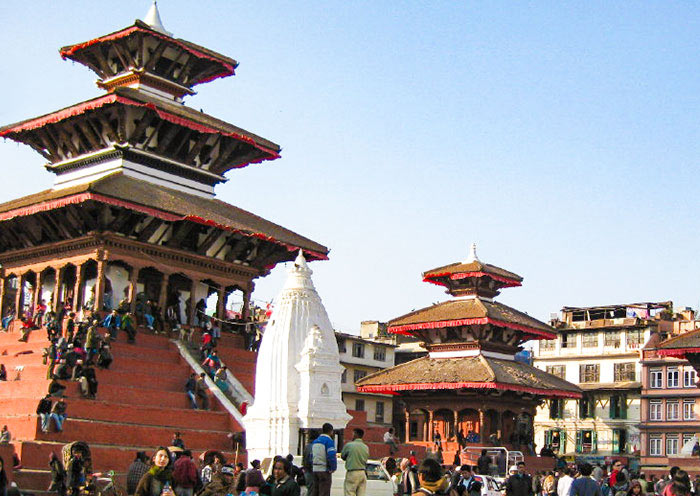
8 Days Nepal Golden Triangle Tour: Kathmandu Pokhara Chitwan (Most Classic)
Nepal Trip Cost Breakdown:
Visa and entry fees in nepal.
Visa and entry fees in Nepal for most foreign nationals are as follows:
- Tourist Visa:
15-day multiple-entry visa: USD 30
30-day multiple-entry visa: USD 50
90-day multiple-entry visa: USD 125
- Visa Extension:
- USD 3 per day for extension of the valid visa period
- Visa for SAARC Countries:
30-day multiple-entry visa: USD 25
Note: Indian nationals do not require a visa to enter Nepal .
Children under the age of 10 years are exempt from visa fees.
Visas can be obtained upon arrival at Tribhuvan International Airport in Kathmandu , as well as at land border crossings and certain entry points in Nepal . It is advisable to carry the exact amount in USD for visa fees, as the immigration office may not provide change for larger denominations.
Check more details about Nepal Visa >>
Accommodation Expenses in Nepal
Nepal offers a range of accommodation options to suit different budgets and preferences.
Here's a breakdown of the approximate costs per night:
- Budget Guesthouses or Hostels:
Dormitory beds in hostels: $10-20 per night
Basic private rooms in guesthouses: $20-30 per night
- Mid-Range Hotels or Guesthouses:
Standard rooms with en-suite bathrooms: $50-70 per night
Guesthouses with additional amenities and services: $60-90 per night
- Luxury Hotels or Resorts:
- High-end hotels with luxurious facilities and services: $100 and above per night
Prices may be higher in popular tourist areas like Kathmandu , Pokhara, and trekking regions. Additionally, during peak tourist seasons (spring and autumn), prices may increase due to high demand. It's advisable to book accommodation in advance, especially for popular destinations and trekking routes.
Check more details about Nepal Hotels >>
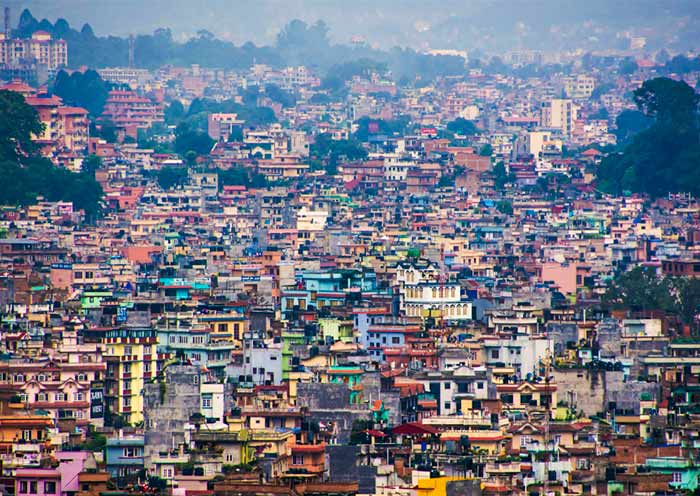
Food Cost in Nepal
Nepal offers a variety of dining options, from local street food to international cuisines. Here's a breakdown of the approximate costs for food and dining in Nepal :
- Local Restaurants and Street Food:
Street food and snacks: $1-3 per item
Local Nepali meal (Dal Bhat - lentil soup, rice, and curry): $2-5 per meal
Momos (steamed or fried dumplings): $2-5 per plate
- Mid-Range Restaurants:
Nepali, Indian, or Chinese cuisine: $5-10 per meal
Western-style meals or international cuisines: $8-15 per meal
- Fine Dining or Upscale Restaurants:
- High-end restaurants or upscale eateries: $15 and above per meal
In tourist areas and upscale restaurants, prices may be slightly higher compared to local establishments. Additionally, bottled water and beverages like tea, coffee, and soft drinks will have additional costs, typically ranging from $0.50 to $2 per item .
Check more details about Nepal Food >>
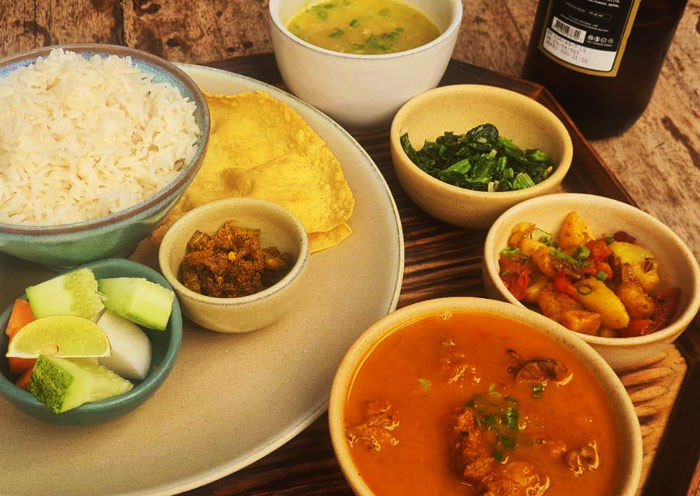
Transportation Costs in Nepal
Nepal offers various transportation options to get around the country. Here's a breakdown of the approximate costs for different modes of transportation:
- Domestic Flights:
- Tourist Buses:
Intercity tourist buses are a common and affordable mode of transportation.
Prices vary based on the distance and type of bus.
Approximate fares: $5-20 for popular routes like Kathmandu to Pokhara or Chitwan.
Taxis in Kathmandu and Pokhara typically operate on a meter, while in other areas, you may need to negotiate a fare.
Short rides within the city may cost around $2-5, while longer distances or airport transfers can cost $10 and above.
When planning your transportation, consider factors such as comfort, safety, travel time, and the specific requirements of your itinerary. It's advisable to book domestic flights and long-distance buses in advance , especially during peak travel periods.
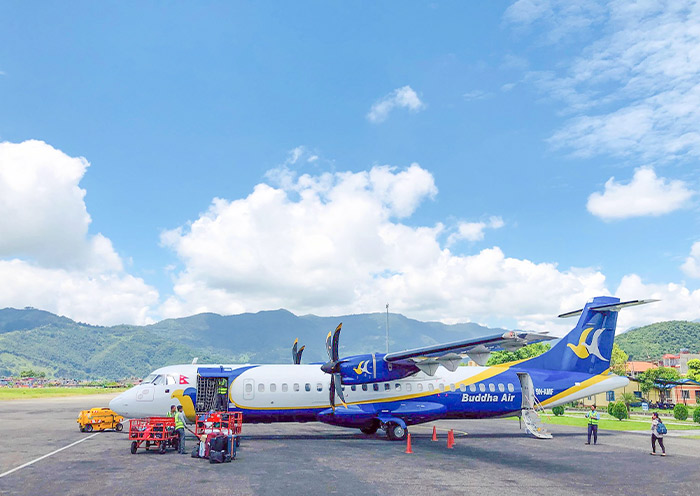
Activities and Attraction entrance fees in Nepal
Nepal offers a wide range of activities and attractions for visitors. Here are some popular activities and their approximate entrance fees:
Miscellaneous Expenses:
- Souvenirs and shopping: Varies depending on personal preferences
- Travel insurance: $20-50 for a short trip (varies based on coverage)
- Health emergencies or travel disruptions: Costs may vary significantly
It's important to note that these prices are approximate and can vary based on factors such as location, season, and personal preferences. Additionally, budgeting for miscellaneous expenses and contingency funds is advisable to account for unforeseen costs.
Remember to research and plan ahead, compare prices, and negotiate where possible to get the best value for your money. How to Plan a Trip to Nepal can match your needs.
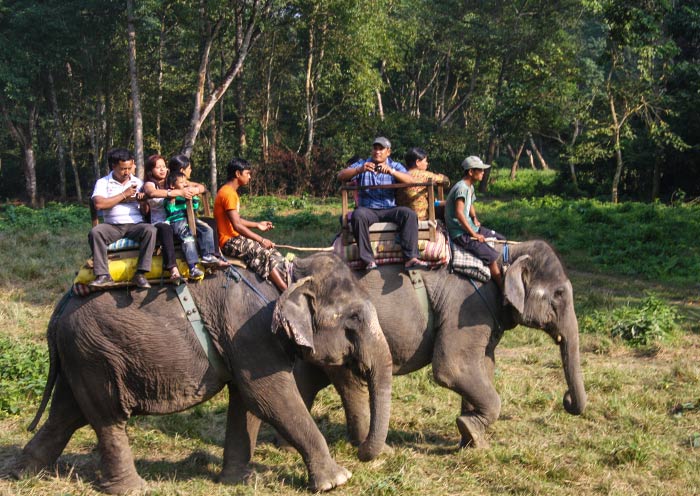
Nepal Trekking Cost
Trekking in Nepal is a popular activity , and the expenses can vary depending on various factors such as the duration of the trek, the region you are trekking in, the type of trekking permit required, the level of accommodation and facilities chosen, and additional services or equipment you might need.
Here are some approximate expenses to consider for trekking in Nepal :
Trekking Permits:
Annapurna Conservation Area Permit (ACAP): NPR 3,000 (approximately USD 25)
Everest Region Sagarmatha National Park Permit: NPR 3,000 (approximately USD 25)
Langtang National Park Permit: NPR 3,000 (approximately USD 25)
Restricted Area Permits (e.g., Upper Mustang, Manaslu): USD 500 and above
TIMS Card (Trekkers' Information Management System):
- For most treks, a TIMS card is required, which costs around NPR 2,000 (approximately USD 17) for individual trekkers and NPR 1,000 (approximately USD 8) for organized trekkers .
Guide and Porter Fees:
Hiring a licensed trekking guide can cost approximately USD 20-30 per day .
Hiring a porter to carry your backpack can cost approximately USD 15-25 per day .
Accommodation:
Tea houses or lodges along popular trekking routes offer basic accommodation facilities.
The cost of a room in a tea house can range from USD 5-20 per night, depending on the location and altitude.
Meals in tea houses or lodges generally cost around USD 5-10 per meal , depending on the food items and location.
Prices may be higher at higher altitudes due to the difficulty of transportation.
Equipment Rental:
- If you need to rent trekking equipment such as sleeping bags, down jackets, or trekking poles, the rental cost can range from USD 1-10 per item per day , depending on the quality and location.
This includes expenses such as bottled water, snacks, hot showers, Wi-Fi, charging electronic devices, and tips for guides and porters.
It is advisable to carry some extra cash for these expenses, as they can vary depending on personal preferences and trekking conditions.
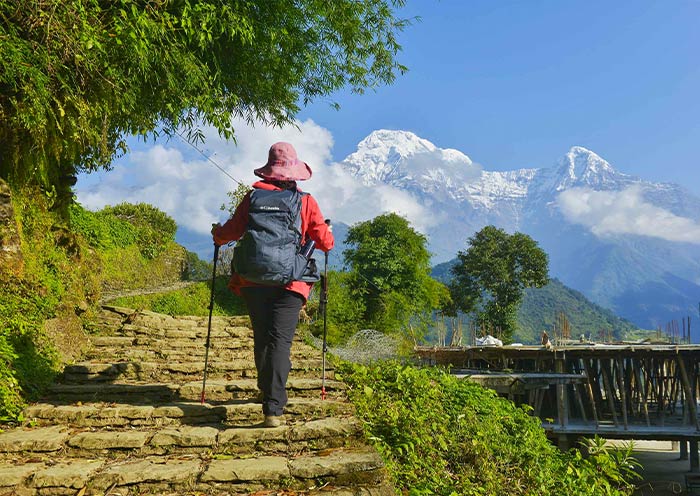
Useful Tips for Reduce the Cost of Nepal Travel
- Travel during the Off-Season
Consider traveling to Nepal during the off-peak seasons, which are typically the monsoon season (June to August) and the winter season (December to February) . During these times, you can often find discounted rates on accommodations, flights, and tour packages.
- Stay in Budget Accommodations
Opt for budget accommodations such as guesthouses, hostels, or homestays instead of luxury hotels. These options are often more affordable and can provide a local and authentic experience.
- Eat Local Food
Explore local eateries and street food stalls to experience authentic Nepali cuisine at a lower cost. Eating at local restaurants or trying street food can be both delicious and budget-friendly.
- Choose Intercity Buses Instead of Flights
Consider opting for intercity buses for your travel within Nepal instead of taking domestic flights. This can help you save a considerable amount of money on transportation costs. Additionally, bus journeys allow you to enjoy the scenic landscapes, interact with locals, and experience the country's culture up close.
- Bargain and Negotiate
Don't be afraid to negotiate prices, especially when shopping for souvenirs or hiring services like taxis or guides. Bargaining is a common practice in Nepal , and you may be able to get a better deal by negotiating.
- Use Public Transportation
Utilize public transportation options such as buses or shared jeeps, which are more affordable than private taxis or rental cars. Public buses are the most economical mode of transportation for long-distance travel within Nepal .
- Pack Essentials
Pack essential items such as reusable water bottles, snacks, sunscreen, and insect repellent to avoid unnecessary expenses while traveling.
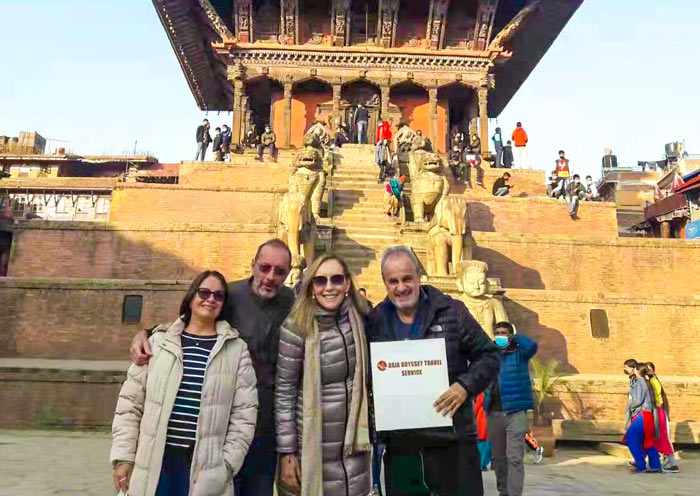
Nepal Budget Trip Itinerary in Off-Season
An 8-day Nepal Golden Triangle itinerary allows you to explore the three major cities of Kathmandu , Pokhara, and Chitwan during winter and summer seasons.
Travel with AOT, Reach Nepal with Ease
Discover the magic of Nepal with Asia Odyssey Travel. With over a decade of expertise and deep-rooted local connections , we craft journeys that unveil the true essence of Nepal .
A long international flight, especially with stopovers, can be stressful with all the booking, planning and rushing between flights. That's where we come in!
We handle visas , connecting flights, and activities , so you can explore new destinations seamlessly. Plus, our expertise unlocks hidden stopover deals you might miss, maximizing your travel experience without the hassle. After all, it's a vacation-why stress yourself?
Let us be your guide, experience Nepal like never before with our exceptional service:
- Personalized Planning: Skip the research, let our experts craft your dream Nepal adventure
- Peace of Mind: Flights, hotels, visa? We handle it all!
- Hiccups? We're your 24/7 travel guardian.
- Time-saving: One-stop shop, say goodbye to endless booking hassles
- Journey with Awareness: AOT's local team ensures experiences that are culturally sensitive
- Travel like a Local: Insider tips, secret savings, and authentic experiences await with our local guides
Asia Odyssey Travel, Your Best Travel Mate. Turn Travel Dreams into Reality!
Contact us today. Your dream Nepal trip awaits!
If you have any questions about this article, please contact us by submitting the following form and we'll immediately get back to you.
Ask Us for More Information
Related Travel Articles
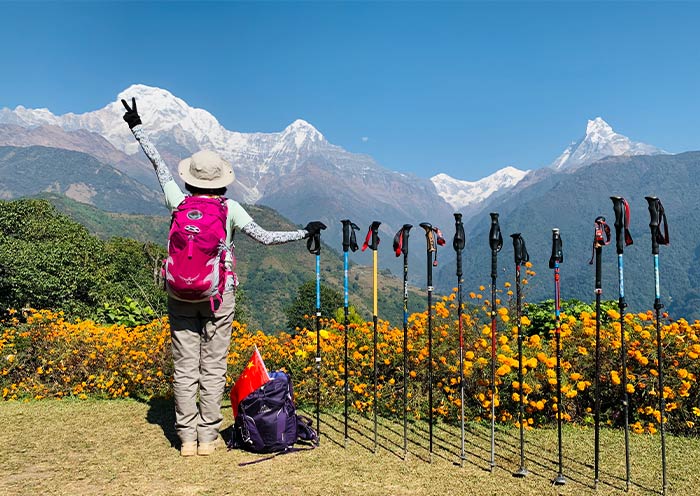
Recommended Related Trips
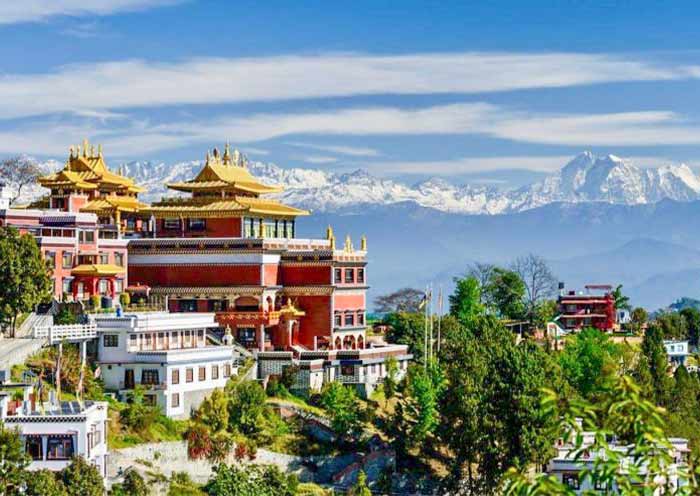
Nepal Travel Guide
Nepal is an absolute gold mine for hikers, and you don't have to be a pro mountaineer to take on some of these epic trails.
Sure, the big cities like Kathmandu are dusty, noisy, and crowded, but once you escape into the mountains you're in heaven, with wide open trails and stunning scenery.
A lot of international hikers come here to do the 2-week Everest Base Camp trek , a bucket list experience with amazing views. The Himalaya mountains are unmatched in size and beauty!
Read through this complete Nepal travel guide for more info on what to expect!
Quick Facts
Nepali; 'Hello' is 'namaste'
Nepalese Rupee (NPR)
VOA available to most nationalities
Varies by altitude
Power Plugs
Type C / D / M
The main international airport in Nepal is in Kathmandu (KTM), which has lots of direct flights from other countries around the world. The small domestic airports in Lukla and Pokhara are also popular with trekkers. You can shop for flights to Nepal on Skyscanner.
Nepal is a relatively safe place to travel, with a low violent crime rate of 2.1 per 100k inhabitants (69% lower than the global average). Crime is very rare on the popular trekking routes in the Himalayas. The biggest safety risks in Nepal are probably motorbike and auto accidents in big cities like Kathmandu.
The climate of Nepal varies with altitude, but the capital city of Kathmandu has generally mild weather. The best time for trekking in the Himalayas is in the spring (Feb - May) and fall (Sep - Oct), when the weather is stable and skies are clear.
Nepal is right up there with India as one of the cheapest countries to travel, with hostels and private hotels available from 700 Nepalese rupees ($5 USD) . Meals are also cheap, costing about 100 to 700 rupees depending on location.
Transportation in Nepal is generally by taxi, and these are pretty easy to find, although ride hailing apps like Uber have sadly been blocked by the taxi cabals so far.
The best Nepal tours & activities
Everest Base Camp Trek
My latest blog posts about Nepal
How To Do The Everest Base Camp Trek In Nepal
The Mount Everest Base Camp Trek in Nepal is one of the world’s best bucket list hikes. In less than 2 weeks, you can trek to the …
EBC Trek Diary – Day 3: Namche Bazaar To Everest Sherpa Resorts
Starting elevation: 3,440 m (11,300 ft) Ending elevation: 3,820 m (12,530 ft) (temporary) Elevation gain: 380 m (1,250 ft) (temporary) Distance covered: 2.5 km (1.5 mi) (roundtrip) …
EBC Trek Diary – Day 2: Benkar To Namche Bazaar
Starting elevation: 2,800 m (9,200 ft) Ending elevation: 3,440 m (11,300 ft) Elevation gain: 640 m (2,100 ft) Distance covered: 5 km (3 mi) Time hiked: 4h …
EBC Trek Diary – Day 1 (Continued): Lukla To Benkar
Starting elevation: 2,860 m (9,400 ft) Ending elevation: 2,800 m (9,200 ft) Elevation gain: -60 m (-200 ft) Distance covered: 9 km (5.6 mi) Time hiked: 5h …
EBC Trek Diary – Day 1: Kathmandu Flight To Lukla
Starting elevation: 1,400 m (4,600 ft) Ending elevation: 2,860 m (9,400 ft) Elevation gain: 1,460 m (4,800 ft) Distance covered: 140 km (87 mi) Time hiked: 0h …
Get In Touch
Feel free to contact me if you have travel questions, comments, or suggestions! I'll try to get back to you!
Mountains for less moolah: exploring Nepal on a budget

Mar 28, 2022 • 7 min read
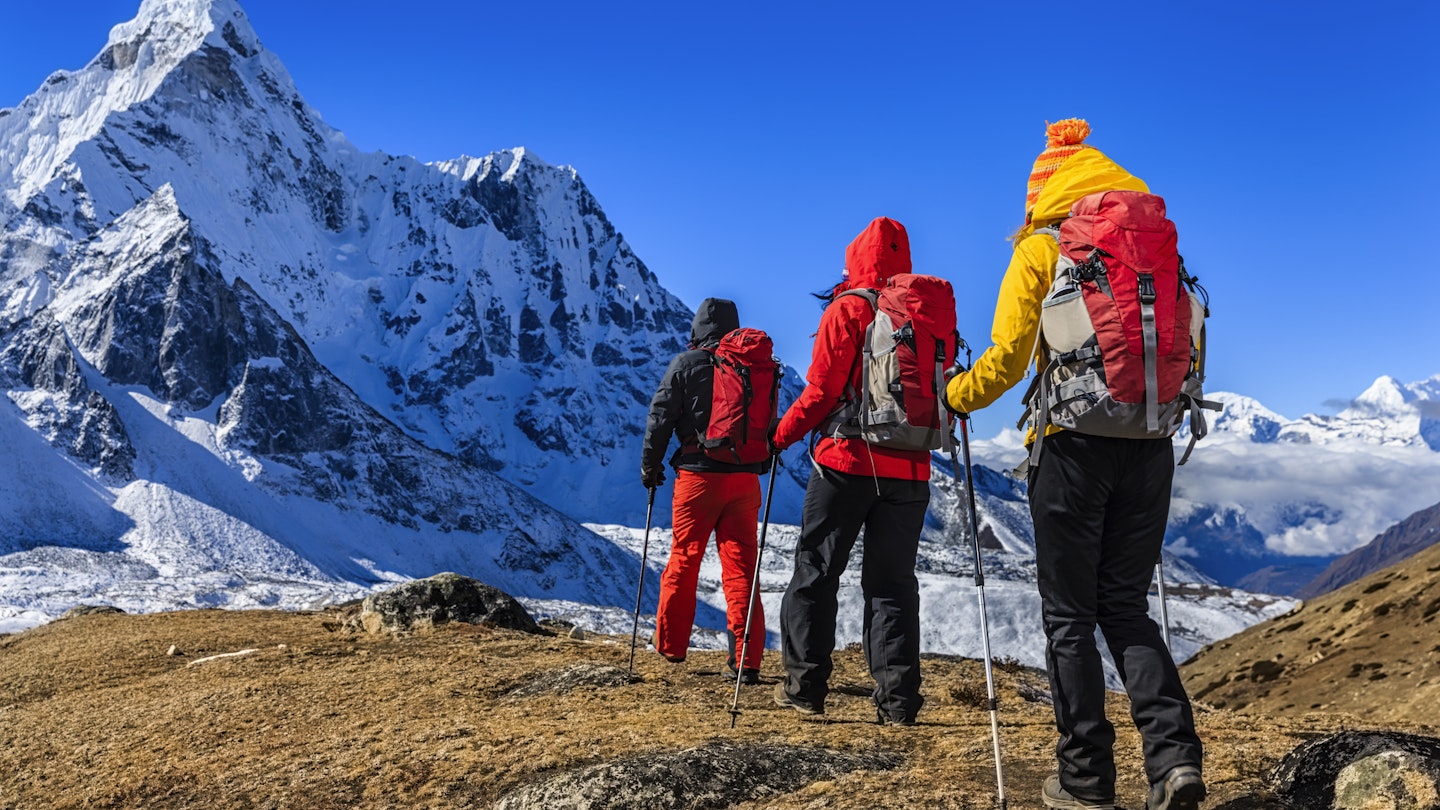
When planning a trip to Nepal, doing activities independently is a great way to save © Bartosz Hadyniak / Getty Images
Nepal is one of the cheapest countries in Asia for travelers and it's easy to explore this beautiful, culturally rich country on a budget. There are plenty of inexpensive places to stay and eat, public transport is extremely good value, entry fees for attractions are low by international standards, and that amazing mountain scenery comes for free.
However, costs are creeping up in the Kathmandu Valley, and you can easily end up spending more than you planned on activities such as trekking, mountain biking and wildlife safaris, as well as on accommodation and tourist-oriented transport.
Here are some tips for cutting your costs when traveling around Nepal on a budget.
Avoid the high season
Flight, accommodation and tour costs peak during Nepal’s October-November high season, which coincides with the best weather for trekking. For slightly lower prices, visit in the March-April shoulder season, which still sees good weather for trekking and wildlife-watching.
You can save even more money by traveling to Nepal in the winter, an excellent time for exploring warmer lowland areas such as the Terai . The cheapest time to visit Nepal is during the monsoon (roughly June-September), though views vanish behind heavy clouds, and getting around can be a challenge due to flooding and landslides.
It’s often cheaper to travel via India
Only a few airlines fly direct to Kathmandu , currently Nepal’s only functioning international airport (though the airports at Pokhara and Bhairawa are due to start receiving international flights in the near future). Getting to Nepal usually involves a change in Asia or the Middle East, and one of the cheapest options is to fly to Delhi and take a connecting flight to Kathmandu from there (though you may need to get an Indian visa to do so).
For even greater savings, you can travel overland from India. The Sunauli border crossing near Bhairawa is easily accessible from Delhi and Varanasi, with express buses running to and from the border in both directions.

Take advantage of a free airport pick-up
Many hotels in Kathmandu and nearby Patan will pick you up from the airport for free if you’ve booked a room in advance. If you haven't, it's not the end of the world – a taxi to town from the fixed-price desk in the arrivals hall at Tribhuvan International Airport costs Rs 750 (US$5.60).
Public buses are an economical way to get around
If you want to save money while traveling around Nepal, inexpensive public buses serve virtually every part of the country, though some services only run early in the morning. Although slower and less comfortable than dedicated tourist buses, domestic flights or private transfers, public buses are easily the cheapest way to get from A to B.
While it can be tempting to take a night bus to save on accommodation costs, be aware that deadly road accidents are common after dark and night buses are best avoided.
Negotiate a discount on your room rate
You'll find an incredible array of budget accommodation options in Nepal, from hostels and homestays to simple lodges and bare-bones budget hotels. It’s always worth haggling for the best price: room rates fluctuate significantly throughout the year and you can often negotiate sizable discounts (sometimes 20-40%) for longer stays or at quiet times, particularly outside of the high and shoulder seasons.
Note that mid-range and top-end places generally don’t include the 23% government and service tax in their quoted rates, so factor this in when drawing up your budget.
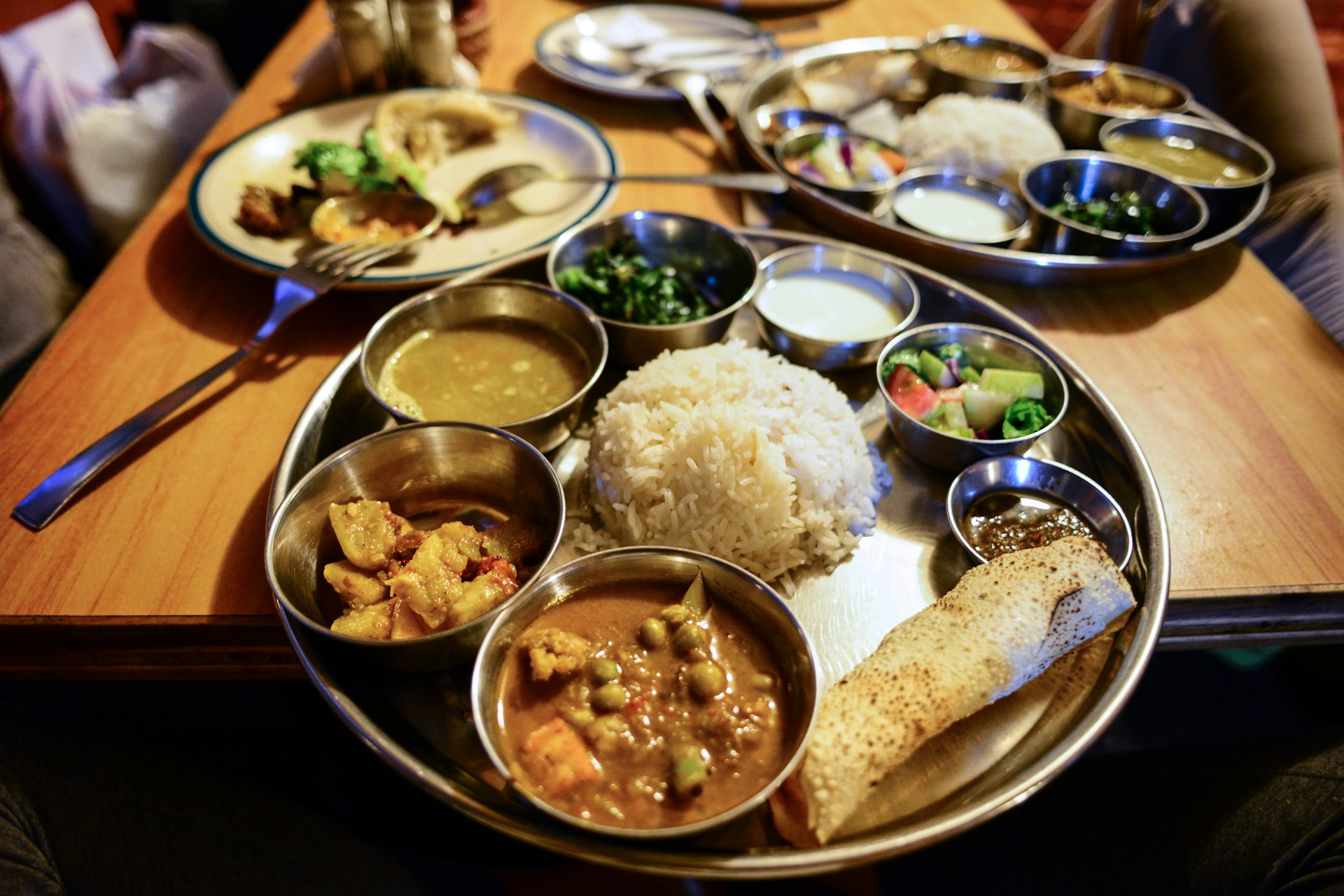
Eat like a local
Tourist hotspots such as Kathmandu and Pokhara are jam-packed with restaurants serving food from across the globe. However, prices – while inexpensive by international standards – are typically higher than in places serving local food to a local crowd. The costs of eating out can quickly add up if you’re on a tight budget.
To save a few rupees, head instead to local bhojanalayas – simple joints aimed at a Nepali clientele, serving inexpensive local staples such as daal bhaat tarkari (dal, rice and vegetable curry). Nepal also has some excellent and economical street food, including samsa (samosas) and momos (meat or vegetable dumplings), which go down a treat with a cup of sweet chiya (tea).
Choose a shorter trek, or trek independently
Nepal is famed for the myriad trekking trails that snake through the spectacular Himalayan scenery, but going on an organized trek with a guide and porters can put a big dent in your budget, particularly if you choose a longer route or have to fly to the trailhead.
To save money, opt for a shorter trek: there are several great options in the Annapurna region, including the memorable three-day Ghandruk Loop. Look for trailheads that you can reach without flying – most treks in the Langtang Valley and Annapurna region can be reached easily and inexpensively by public bus.
Another great way to save is to trek independently, instead of joining an organized trek. Many popular routes are relatively easy to follow without a guide, with plenty of teahouses providing simple accommodation and food (beer, however, can be pricey). Top choices include the Annapurna Circuit and Everest Base Camp treks.
Note that independent trekking does not mean solo trekking – it’s never wise to go hiking completely on your own. If you need companions for an independent trek, ask around at guesthouses in Kathmandu or Pokhara, or put up a note on noticeboards in tourist areas.
Make the most of Kathmandu’s Durbar Square
Most foreigners have to pay a Rs 1000 (US$8.50) fee to access Kathmandu’s famous Durbar Square , a Unesco World Heritage Site lined with magnificent medieval palaces and temples. Although the entry ticket is only valid for the date stamped, you can extend it for the length of your tourist visa for free at the site office, allowing you to visit multiple times during your stay. And you can do the same at the equally impressive Durbar Squares in the neighboring cities of Patan and Bhaktapur .

Skip “budget” Chitwan safaris
Many travel agencies in Kathmandu and Pokhara offer “budget” two-night, three-day safari packages to Chitwan National Park , but while these all-inclusive deals look tempting, they’re a false economy. You only get a day and a half in the park, have little choice over activities, and the accommodation and food are often below par.
It’s far better to travel to Chitwan independently and make the arrangements yourself; you’ll save money and have a far more enjoyable experience. Buses run from Kathmandu to Sauraha on the fringes of the park, where there are dozens of inexpensive lodges.
Slash your phone bill
Buy a local SIM card on arrival at Kathmandu’s airport or from retailers across the country to avoid being stung by a hefty mobile phone bill when you return home. Your phone should be unlocked and you’ll need a passport photo to register. If you need to make landline calls, use local call centers rather than using the phone in your hotel room.
Snag a SAARC discount
Travelers from countries that are members of the South Asian Association for Regional Cooperation (SAARC) – Afghanistan, Bangladesh, Bhutan, India, the Maldives, Pakistan and Sri Lanka, as well as Nepal – pay lower entrance fees than other foreign visitors at most museums, national parks and heritage sites. You may need to show identity documents to quality.
Arrange your own mountain-biking adventure
Nepal is a dream destination for mountain bikers, thanks to its plethora of fast-paced, downhill trails. Although going on an organized guided cycle tour with an operator such as Dawn Till Dusk and Himalayan Single Track is the easiest option, many routes can be followed independently, which significantly reduces the cost.
Bikes can be rented from numerous hire companies in Thamel in Kathmandu, and plenty of routes start just outside the Kathmandu city limits. For a taster, try the three-day Kathmandu Valley Loop via Nagarkot and the Buddhist pilgrimage site of Namobuddha .
Buying an up-to-date map and learning some basic Nepali phrases so you can ask for directions will make life immeasurably easier. If you're feeling less ambitious, consider taking some short out-and-back rides to the small towns and temples dotted around the Kathmandu Valley.
Daily costs in Nepali
- Hostel dorm bed: US$10
- Basic room for two: US$15-25
- Room and half-board in a trekking lodge: US$12-15
- Public bus Kathmandu-Pokhara (125 miles/201km): US$3-5 one-way
- Dinner for two: US$4-10
- Coffee or chiya (tea): US$1-2
- Beer: US$2.50-3.50
You may also like: 7 expert tips to sustainably trek to Everest Base Camp Uncovering Kathmandu’s cosmopolitan culture: why you're going to want to linger longer The best places to visit in Nepal, from mountains to Buddha's birthplace
Explore related stories
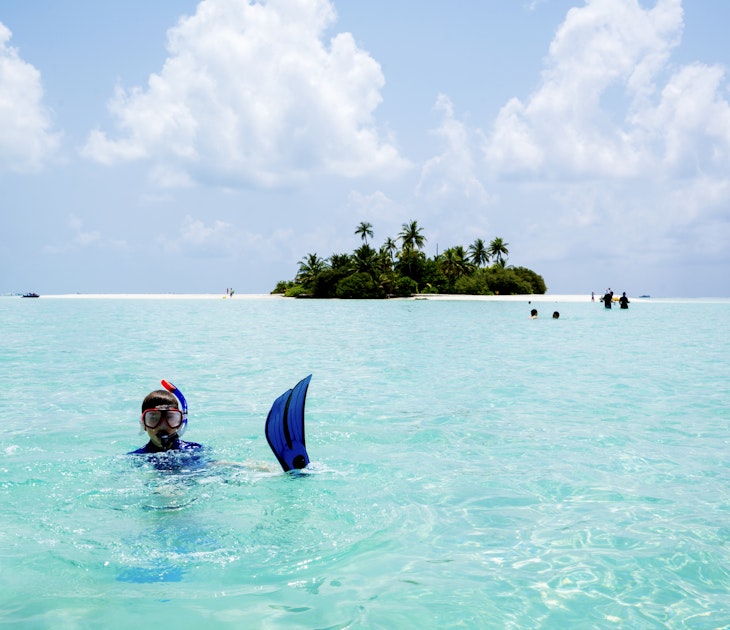
Budget Travel
Feb 22, 2024 • 5 min read
The Maldives is not a cheap place to visit, but there are ways to make your money stretch further. Here are our top budget tips.
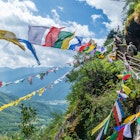
Jan 28, 2024 • 7 min read

Dec 20, 2023 • 11 min read
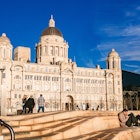
Aug 16, 2022 • 7 min read
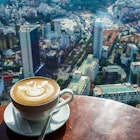
Feb 10, 2020 • 8 min read

Oct 28, 2019 • 19 min read
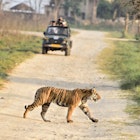
Apr 16, 2024 • 13 min read
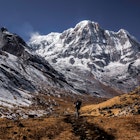
Feb 22, 2024 • 3 min read

Jan 11, 2024 • 4 min read
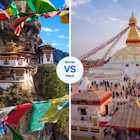
Dec 20, 2023 • 7 min read
Last updated on January 6, 2024 by Shannon
Nepal is sometimes overlooked by travelers because they figure it’s an extension of India; it’s not. Nepal has a beautiful, fascinating, unique history. The Nepali are incredibly friendly and fun—learn a bit of Nepali and they will love you for it. Nepal is a mecca for outdoorsy type travelers because of the Himalayan mountains that offer up some of the best trekking opportunities in Asia. In fact, Nepal boasts eight of the 10 highest peaks in the world.
Traveling in Nepal is generally safe, meaning travelers of all types—solo travelers, backpackers, families, and more—can find things to enjoy without the worry. Nepal also attracts both outdoorsy types and volunteers in equal measure, so although there are a fair few generally tourists there for the culture, most are there on a mission to see some nature, or volunteer their skills locally.

Table of Contents
Why Visit Nepal
For many years, the dicey power situation made working remotely from Nepal tricky— there used to be few as eight hours of power every day, but that changed in 2016 . With that no longer the case, Kathmandu continues to add a number of incredible cafes and guesthouses ideal for travelers and digital nomads. Plus, even when there were major power outages, it couldn’t mask the absolute delight of traveling in Nepal.
I loved visiting Nepal and I loved learning about its culture and language. I highly recommend spending at least two weeks to even scrape the top of the many things to do in Nepal . That being said, post-earthquake Nepal is different than it once was. The April 2015 earthquake devastated the people of Nepal, the country’s transportation infrastructure, and the tourism industry. Now, it’s still a place you can travel and have a wonderful time.
In fact, I am a firm supporter of responsible tourism as a way to help Nepal continue developing. But the impact, death toll, and the level of destruction mean that travelers should be keenly aware that the country will take years to truly rebuild all that was lost. Some posit that it will take decades to recover from this earthquake.
All this to say, be sensitive to the fact that Nepal faces a long road ahead. Tourism and travel is one part of a solution, but only when tourists are committed to a responsible approach to helping the country come out stronger on the other side of this quake. You can skip straight to the responsible volunteering & travel section , or to the city guides.
Things to Know Before Traveling Nepal
Nepal is among the least developed countries in the world according to the U.N. This means travelers will see drastic differences between life in the cities and life in the small villages. The culture and people have a resilient spirit, however, and it’s a beautiful place to visit.
Nepal’s history dates back more than 2,500 years, but much of that ancient history is unknown. Many UNESCO sites worth visiting date back to the 1400s. It’s worth knowing a bit about Nepali politics, as it’s an unstable and ever-changing topic. A monarchy ruled Nepal until 2008, at which time a democratic republic and a constitution were established and adjusted over the next several years.
As Nepal developed, unlike many countries, it remains about 80% rural. It’s also one of the least developed countries in the world according to the U.N. This means travelers see drastic differences between life in the cities and life in the small villages. As a result of this mix, lifting rural areas out of extreme poverty has proven difficult.
The political climate is often tense, and the lack of education in these rural areas has had a direct impact on the preservation of Nepal’s natural resources. As tourists descend on Nepal, the country has struggled to meet tourism demand. This has resulted in poorly maintained transportation infrastructures and the use of natural resources in unsustainable ways. It’s a bit of a tough situation, as the tourists are both the core issue, and yet also the only way to bring money into these areas.
Modern Nepal is a fascinating, diverse place. Neighboring countries have had a marked influence on modern Nepali life. Travelers witness deep influences from India, Tibet, China, and even Mongolia. The country has 30+ ethnic groups, and with these a large variation in the number of religions and dialects.
With all this diversity, the country has a mixed bag of religions as well. Predominantly Hindu, the country integrates Buddhism and animism too. All this to say, the mixing of cultures over the years have given Nepal a history as beautiful as the landscape.
Fast Facts About Nepal Travel
Nepalese Rupee (NPR) ( current exchange rate )
Electricity
220V/60Hz (multiple plugs as they have retrofitted many to fit American and European plugs. Be careful of plugging in some electrical devices as the the U.S. runs at 120V).
Nepal’s Primary Airports
Kathmandu’s Tribhuvan International Airport (KTM)
Can you drink the water?
No, the water in Nepal is not safe to drink. Drink bottled, or consider the merits of a SteriPen or LifeStraw for your trip.
How is the wifi in Nepal?
Kathmandu and Pokhara have extensive access to internet shops filled with computers. There are also restaurants and cafes in both of these primary cities that offer free WiFi. The internet is decent in both of these very tourist-heavy cities. You can do most anything you need to on the internet, uploading information, photos, emails. Video calls likely only in the bigger cities. Outside of Pokhara and Kathmandu, it’s fair to non-existent.
Travelers can easily purchase a SIM card as well as data once they land in Nepal. And it’s quite affordable. Read this SIM card guide for tips on how to get one, how to top up, and what that whole process will look like.
Nepal issues visas on arrival for citizens of most countries. These can be purchased for 15, 30, or 90 days and range from $25 to $100. Check your visa requirements here . You must bring a passport-sized photo, or stand in line and pay for one when you arrive. Volunteers technically require a visa arranged by the place they are working with as volunteering on a tourist visa is expressly forbidden, though harder for them to enforce.
How Much Does Nepal Travel Cost?
Nepal is very budget-friendly and cheap to travel. Hiking and trekking will add some expenses, but even those are reasonable. A solo traveler can anticipate rock-bottom budget of $15 per day if traveling around. If you’re volunteering some daily rates are in the $10-15 per day range to cover food and board.
A little extra budget goes a long way here and you can upgrade to nice digs and eat decent food on just $30 per day per person when you are not trekking. Once you add in trekking fees, that gets a bit more. Baseline though—it’s cheap to travel Nepal. You can scale up and have a very nice couple trip or family.
When to Visit Nepal
You’ll need to plan your visit around your planned activities. If you’re hiking, the trails are closed during monsoon season, which runs from June through August. Trekking season is September through May. Autumn and spring are beautiful; lush and green in the fall and flowering and cool in the spring. Winter can be chilly at altitude, but is pleasant in the Kathmandu Valley.
Food Considerations
Vegetarians will love traveling through Nepal because the national dish, dal bhat, is lentil soup and traditionally served with rice and veggies. Warning though, don’t be fooled into thinking that the food is similar to India—there is much less variety and the Nepalese do eat meat (unlike most of India).
The Tibetan momos (dumplings) are fantastic and a staple of any vegetarian diet in Nepal. Also, many travelers get gastrointestinal issues as there is very poor sanitation. Avoid unpeeled fruits and salads. Please always sterilize your water, and follow these food safety principles .
Accommodation in Nepal
Nepal has a huge range of options. From cheap, basic rooms for backpackers to much nicer hotels. And even some eco-lodges and fun things like treehouses and such. While the links in city guides below go to a hotel booking site, many are also found on VRBO if you are member.
For backpackers, the major hotel sites like Booking.com have eclipsed the need for hostel sites specifically and are perfect for pre-booking hostels; in high season the bigger towns book up fast.
If you buy a local SIM (which you should), you can easily call ahead and directly reserve spots en route. Hotel owners are often on Whatsapp, and you should use that if trying to get a quick response in-country. If none of these will do, check out my detailed guide to finding good places to stay .
Possible Issues
Women should not trek alone in Nepal under any circumstances. Go with a guide, or use one of the buddy trek sites to find a trekking partner. Be particularly cautious as a woman hiking in the Langtang area.
Transportation issues are a serious safety threat. Landslides and road accidents happen with frequency all year round, but particularly during the summer monsoon rains. I highly recommend travel insurance like IMG —health care quality is low when traveling throughout Nepal, and you’ll likely need to be airlifted out of Nepal if something serious happens.
Nepali Festivals of Note
- Phalgun Festivals , Kathmandu (Feb/March)
- Dashain , country-wide (September/October)
- Indra Jatra , Kathmandu (September)
Getting Around Nepal
Transportation between cities is easy to organize and takes the form of buses. If you’re faint of heart, don’t watch as the buses careen around curves and the rusting carcasses of other buses dot the bottom of the hillsides.
The buses are the main form of transportation, but Nepal has serious infrastructure issues so be careful. But, the buses are effective and they’re virtually the only budget option. In more recent years, there has been a rise in micro-buses of 10-12 people—a bit more but likely a bit safer. If you’re in a group, it’s fairly affordable to hire a private driver or taxi for longer distances. Bicycle and taxis are great for navigating around Kathmandu.
Is Nepal Safe for Travelers?
One of the most common issues facing travelers is gastrointestinal issues. There is very poor sanitation in Nepal so you will need to be careful with your food and water consumption. You must carry a medical kit; make sure you have several courses of antibiotics as well as a decent supply of oral rehydration salts . These ORS can save your life in the case of diarrheal illness. Anything can happen on the road. I am a firm advocate of travel insurance like IMG Global (which I’ve used for over a decade).
As far as physical safety—it’s really a rather safe country, though woman should be cautious of being alone at night or on treks. Your valuables may get robbed though, so be aware of what you leave in guesthouses and don’t carry a lot of cash.
World Travel Planning Resources
From the best travel gear to how to pick travel insurance—a detailed list of resources, tips, and advice to help you plan an amazing trip.
Pre-Trip Reading Inspiration: Books About Nepal
Fiction & Nonfiction Books About Nepal
- Arresting God in Kathmandu by Samrat Upadhyay. This is the first Nepali author to find a western publication of his story and it’s worth reading for a much more personal account of Nepal.
- Little Princes: One Man’s Promise to Bring Home the Lost Children of Nepal . A fascinating, harrowing, and humbling account of one man’s plunge into the world of child-trafficking. He gives a unique take on a side of Nepal few tourists are willing or able to see.
- The Snow Leopard . The author hikes deep into Tibetan regions of the Himalayas in search of a rarely spotted type of snow leopard. A beautifully written narrative account of nature and the journey—pick up a copy before you leave because it’s hard to find on the road!
- The Violet Shyness of Their Eyes: Notes from Nepal . Much more than the travel narrative it’s billed as, the author, a Westerner teaching in remote Nepal shares insights on how Western culture is affecting Nepal—and her opinions are far from mainstream, but you’ll find yourself agreeing most of the time.
- From Goddess to Mortal : The Royal Kumari is an absolutely fascinating part of modern Nepal religious beliefs. In this autobiography, the author details her early years as a living Goddess living at a temple in Kathmandu; after six years, however, she went from Goddess back to mortal. Intriguingly innocent as the author first experiences the attention of being Nepal’s one living Goddess contrasted sharply with her life post-Kumari status. Unique cultural insights abound and I found the story of the Kumari one of the most fascinating parts of my visit. Order before you leave as it’s only in paperback.
- Into Thin Air: A Personal Account of the Mt. Everest Disaster . A haunting account of the author’s ascent of Mt. Everest in March 1996 on the day a massive storm hit and took the lives of several of his traveling companions. Not indicative of all treks in the Himalayas by any means but compelling storytelling centered on Nepal nonetheless.
Podcasts and Online Reads About Nepal
- No one else needs to climb Everest—let’s turn it into a memorial : This is a great piece by Jan Morris and a must-read before you cross off that bucket-list trip to Everest Base Camp. Everest is a holy spot and the death toll is climbing as what was once a pursuit reserved for the fiercest of climbers has become a spectacle of tourism.
- The Case for Traveling to Nepal : This is a piece I wrote post-earthquake that looks at the interplay between tourism and recovery as Nepal rebuilds.
- Riding High : Mountain biking is taking off in Nepal in the wake of the earthquake and the subsequent fuel crisis. This piece examines at what a mountain bike trip through the mountains actually looks like.
Read all my Nepal travel blog stories and find more regional fiction and nonfiction books and long-reads .
Recommended Guidebook for Nepal
Lonely Planet Nepal . I like using Lonely Planets mostly because I am super familiar with the layouts, they have a good transportation section—and what they lack in history and insight I can easily find online!
Socially Responsible Travel in Nepal
Nepal is one of the most beautiful countries on earth. The Himalayas are a companion to nearly every moment in the country. And the Nepali people are warm and welcoming.
As a country, Nepal has fully embraced tourism and the money it brings to the country. Alongside that, it’s one of the poorest countries on the planet and the demands of tourism often run roughshod over conventional best tourism practices.
The mingling of a beautiful landscape, a willing culture, and a high demand for tourism has created some very serious issues. But there are benefits too; even tourism done poorly has brought needed money into impoverished rural communities.
Responsible travel is not about abandoning Nepal because it has some issues, but rather identifying areas where tourism can be shifted into a more positive force for good in the country. A responsible traveler should be sensitive to the development issues Nepal faces—even more so in light of the devastating earthquake. Let’s look at a few areas of responsible tourism decisions facing a Nepal-bound traveler.
Trekking in Nepal
As one of the top billed things to do in Nepal , there are a handful of specific ethical issues directly in and related to your trek. A key concern is the impact trekkers have on the remote mountain environments during their trek.
Trekkers should plan on keeping their waste to an absolute minimum. This includes packaging from food or items you’ve packed, as well as plastic water bottles. All trash has to be burned (not ideal) or carried off of the mountain. Do your part and carry a reusable bottle and a SteriPen or LifeStraw for your trip. Women should also use a menstrual cup not only for ease of travel, but it’s the most eco-friendly option, too.
Lighten your load on your trek. Carry the lightest pack possible and leave behind all the nonessentials. Some trekkers will pay their porters to carry a heavier load and this is poor practice. The porters may accept the extra fee, but they are risking their livelihoods by trekking overloaded. General guidelines are 6-7 kilos per person, with a porter carrying max 12.5 kilos. Stick to this limit—you won’t need the extra clothes you’re over-packing anyway.
To that end, ensure you are paying fair wages to all porters and guides. One of the most compelling reasons to support tourism in the Himalayas is the positive impact it has bringing money into rural communities. Don’t haggle too much and ensure you are tipping and spreading money around fairly.
Visiting Religious Sites
The Nepali people are a spiritual people. Visiting the temples, stupas, and religious sites is a clear highlight to any trip to Nepal, but keep in mind a few behavior best-practices.
Show respect by dressing conservatively on any day that you plan to visit temples and religious sites. Although you should generally dress conservatively around the country too, this is doubly important at holy sites. Women should cover their shoulders and knees. Men should wear pants or long shorts and no singlets—also ensure your shirts have sleeves.
Be respectful with your camera; you are not allowed to take photos inside of many temples. If you are unsure, ask first.
Remove your shoes before entering temples, and never point your feet at the altar, nor should you step over people. Feet are considered dirty and people will shift their legs if you need to pass.
Consider these additional general responsible travel tips to lessen your impact on the places you visit, and this page has thorough information on additional considerations for responsible tourism in Nepal. I also suggest that all travelers read this great post on giving to child beggars ; you will face this conundrum, so best to be prepared.
Volunteering in Nepal
Volunteering is another sticky issue for responsible travel in Nepal. Nepal’s aid industry thrives, but the general lack of government control and regulations means that this country has some serious issues in the volunteering and voluntourism arenas.
Generally, don’t plan on volunteering at an orphanage. And if you plan to teach English, ensure you have at least 4-6 weeks minimum to devote to a location.
Beyond these two types of volunteering, there is a lot of other work that is less “sexy,” but also needed. Nepal needs skilled labor of almost any form, so if you have a skill that you can spend time teaching locals, that is a valuable form of volunteering. This could be anything from agriculture to medicine to construction. Think outside the box when you are researching volunteering opportunities, and devote as much time as possible to the cause.
Book a day tour to maximize your time.
GetYourGuide has a phenomenal range of tours, and they’re affordable too. Maximize your time by booking your must-dos as a tour, and then slot in the rest as time permits.
Let’s look at the specifics. For me, I taught English to young Nepali monks at a monastery about an hour outside of Nepal. There are countless opportunities in the realms of medical volunteering and teaching English. There are also a ton of organizations facilitating volunteering opportunities.
The sad fact is, however, that most are not doing good work. Some are outright scams and will never give your fee to the places hosting your volunteering. Nepal has so many volunteer opportunities that you should not pay a fee to volunteer. Most volunteer opportunities charge just for room and board, and occasionally a small fee to cover your training—occasionally.
If your schedule is flexible, then head to Kathmandu and ask around—you will have a ton of choices. By arriving and looking around, you not only save money, but it often cuts out the confusing middle-man and you can better vet the organization for its ethics and efficacy. These pre-vetted volunteer opportunities are another option for finding good placements.
Animal/Elephant Tourism
Elephant tourism is sticky subject . I expressly discourage riding elephants in Thailand , Vietnam , Cambodia , and other areas of Southeast Asia . But in Nepal, there are other considerations.
The elephants are primarily used in Chitwan National Park to allow tourists to see the endangered one-horned rhino. Chitwan is home to an abundance of wildlife, and unique flora and fauna. Even more, beyond the rhino, Chitwan houses the last stronghold of Bengal tigers in the wild, and is home to a critically-endangered vulture species. This park is important, and the elephants shuttling tourists to the rhinos provide invaluable funding that goes toward anti-poaching measures.
This is a rare instance where—if you really insist on riding an elephant somewhere in the world—you could make a reasonable case for it being more sustainable here than in other areas. That said, elephants are not meant to be ridden, so this is for those that plan to do it anyway. And besides the elephant aspect, I highly, highly recommend visit the national park. Chitwan National Park is a cultural stronghold of the Terai people , a UNESCO site, and a stunningly pretty place on this planet.
Don’t forget to book travel insurance for your trip —a great policy provides coverage in case of medical emergencies, lost or stolen gear, adventure sports riders, and more. I’ve used IMG Global for more than a decade highly recommend it !
Best Things to Do in Nepal
My favorite experiences in nepal.
- Walking around all of Kathmandu’s many temples and stupas .
- Taking a Vipassana meditation course outside of Pokhara for 10 days.
- Trekking the Annapurnas for a week with friends.
- Looking at all the wild animals in Chitwan National Park .
- Volunteering Teaching English at a monastery deep in the Kathmandu Valley.
Kathmandu Travel Guide
Kathmandu is huge. It’s bigger than you might assume, but it’s still very navigable. Even better, it’s home to the most fascinating Hindu and Buddhist temples I’ve ever seen.
In the wake of the earthquake, some of these were destroyed. But not all, there is still much that is left and much to learn from the destruction as well.
There is a lot to do in the city. The backpacker and tourist section of Kathmandu, Thamel, is a beehive of activity and amenities built for Westerners. Though Pokhara is the main spot for Annapurna circuit treks, Kathmandu is the starting point for Everest Base Camp, as well as a lot of the volunteer opportunities in the country.
Things To Do in Kathmandu
Temples and holy sites are rampant in Kathmandu and date back to some of the oldest Buddhist and Hindu temples in the world. No matter how “templed-out” you might be when you land in Kathmandu, you simply have to visit each of these four major sites—all different and all intriguing. For a complete guide to the city, however, visit my specific post on Things to Do in Kathmandu .
- Hanuman Dhoka, aka Durbar Square . A UNESCO site, this series of temples and buildings was once used by royalty, the really fascinating part of the square are the elaborately carved doors to where the Kumari Ghar lives. The Kumari Ghar is a living goddess and it’s worth some research to see if you’ll be in Kathmandu during one of her handful of appearances (and check the recommended reads above to learn more about her). I loved visiting this site; bring lunch and sit on the steps like locals and watch the pigeons, people, and sadhus wander.
- Swayambhunath, aka Monkey Temple . There are literally hundreds of monkeys here. The are tons of statues to the various gods, including monkey god Hanuman. Worth a visit on the day you do the other popular stupas and temples.
- Boudhanath . A UNESCO site and most likely the largest Stupa in the world. Consider this the mac-daddy of all Buddhist sites. It’s huge and bustling with activity all day long.
- Pashupatinath Temple . This is a sacred site for the Hindu and as a Westerner you can look at the temple from the other side of the river. Also a UNESCO site, you can watch from above as they regularly perform ritual cremations in the ghats.
- Consider an off-the-beaten-path trek . This great piece looks at the quiet nature awaiting those visiting the trails less taken.
Places to Eat and Sleep
No budget recommendations, they were all pretty lousy cleanliness wise, but cheap. If you cab into Thamel from the airport (walk from bus station) then you can look around. There are tons of options for every budget.
- Helena’s Rooftop Restaurant . Beautiful views over Thamel and the city. The breakfast is pretty tasty (they make the claim it’s the best in Kathmandu which might be a bit much) and the set priced meals and breakfasts make it easy to know what you’re going to pay.
- OR2K . They have wifi and a Middle Eastern/Western menu—pricier than local foods but breezy restaurant area with trendy/hippy vibe. I went for the wifi really, since that can be tricky to find at the guesthouses.
- ZAIKA Nepali Cuisine . The momos are delicious, food is reasonably priced, and the restaurant is never too touristy even though it’s in Thamel (which is a real feat to maintain the relaxing environment!). It can be tricky to find, so follow the directions on the site and enjoy. And know that it’s a relaxed vibe during the day, and pumps music during the evening.
- Stay in a nice spot . Consider Hotel Mums Home on a budget, Hotel Tibet for midrange, and Hotel Yak & Yeti for a nice place from which to organize visit Kathmandu.
Pick out accommodation on Booking.com.
This is the only booking platform I use because it rewards you for loyalty, and I regularly score free breakfasts and 15% off my hotel.
Pokhara is a complete 180 from Kathmandu’s backpacker district, Thamel. Pokhara’s streets are wide and relaxed. Fewer shops are stacked on top of each other. This is the starting point for most treks in Nepal, and is the starting for all of the Annapurna treks. You take the all-day bus from Kathmandu, or book a mini-bus at one of the tourist agencies in Kathmandu. And since Pokhara is built up around the trekking business, you can find everything you need for a trek.
Also, there’s a large Tibetan community in Pokhara operating the tourist shops—dig around and you can find neat and unique souvenirs to ship home!
Things to Do in Pokhara
- Trek the Annapurna Circuit . Most people come to Pokhara to begin their treks around the Annapurna Circuit. Treks can vary in length from several days (like my Poon Hill trek ) to several weeks (Annapurna Base Camp)—and everything in between. I recommend organizing through the Noble Inn guesthouse , they’re wonderful. But there are dozens of reputable companies, just ask questions and outline who’s paying for food, porter costs, accommodation, etc.
- Kayak, rafting, boating . Pokhara is surrounded by lakes and rivers with grade 4 and 5 rapids. For adventure, try the rapids. Try boating for a more relaxing day though, you can rent it for a couple hours, fish, and swim in the lake.
- Take a Vipassana Meditation Course : Perhaps single hardest thing I’ve accomplished is completing this 10-day silent meditation course. There is a Vipassana center near Pokhara in a gorgeous spot overlooking Begnas Lake.
- Paragliding : On a clear day this would be simply stunning. I was too chicken to try, but the views from the ground are stunning, so consider this a more bird’s-eye view of the Himalayas.
- Hotel Noble Inn . Family run and very clean, they were affordable and so very, very friendly. We booked our trek through them, they arranged it all and everything went flawlessly. It’s so much more than staying in a hotel, stay for a while and you’re welcomed to share stories and laughter too. It’s also centrally located and close to internet and great eats.
- Hotel Crystal Palace . Located in the Phewa Lake area, this place has wifi, pretty views, and a bit of everything for a comfortable stay. It’s mid-range pricing and conveniently located.
- New Pokhara Lodge . Just a tiny bit outside of town but still walkable to the tourist spots and restaurants. A lovely vibe at this budget option with wifi and all amenities you could need.
- Punjabi Restaurant . Seriously tasty Indian food. There are surprisingly few Indian eats in Nepal, so this one was a welcomed find – I ate there daily.
- German Bakery. Popular and for a reason, though it’s hardly a hidden spot, the Western-style baked goods can act as some comfort food if you need it.
Nepal Travel Guide: Best Stories From the Blog
Enjoy all of my Nepal travel stories , each blog dispatch written from the road as I traveled this beautiful country.
A Little Story… And the Case for Planning a Trip to Nepal
A Little Musing… On the Art of Cultural Immersion in Travel
A Little Travel Memory… Oh, The Things That Happen Over Chai
A Little Volunteering… Continued Mentoring Years Later
A Little Sweet… Fun Desserts from Around the World
A Little Reflection… Vipassana Meditation: Was it Worth It?
A Little Discovery… 20 Neat Things I Learned By Traveling in Developing Countries
A Little Confession… Tricky Adjustments as I Leave Asia to Travel Europe
A Little Goodbye… These are a Few of My Favorite Memories from Traveling in Nepal
A Little Conservation… Elephant Ethics at Chitwan National Park
A Little Adventure… Exploring Nepal’s Wild Outdoors at Chitwan National Park
A Little Festival… Celebrating Nepali New Year in Pharping, Nepal
A Little Culture… Traditional Nepali Food and Traditions
A Little Routine… Tea Time, Games, and the Rhythm of Teaching
A Little Learning… What is it Like Teaching English in Nepal?
A Little Town… Exploring All that Pharping, Nepal Offers Travelers

A Little Volunteering… Teaching English at a Monastery & VSSN Nepal Review
A Little Culture… Exploring Kathmandu’s Stupas, Temples, and Culture

A Little Introspection… What it’s Like to Take a Vipassana Meditation Course
A Little Adventure… A Trekking Journey into the Himalayas to Poon Hill
Nepal Trip Planner in 2024: Trip Cost, What to See, Know and Do
March 18, 2024
Paula Martinelli
Wondering how to plan a perfect & safe trip to Nepal?
With this Nepal Trip Planner guide, you will find everything you need to know about traveling in Nepal. From the safest ways to get around to the best places to visit. It also covers the cost of traveling to Nepal, the best time to go, and how to find the best accommodations and transportation options. This is your one-stop guide for planning your trip to Nepal!
I spent 30 days in Nepal and I have learned a lot during my trip – and now I bring to you all you need to know for planning your trip to Nepal and how to travel safely. Don’t forget to check this guide about 30 Things to Know Before your Trip to Nepal.
This picturesque country has a lot to explore. Nepal offers treasures such as Everest, the tallest mountain on our planet, the house of the living Goddess Kumari, and Lumbini, the birthplace of Lord Buddha Shakyamuni. If you are looking to explore the outdoors and love to immerse yourself in nature, Nepal is the perfect place to visit.
For more Nepal reading ❤️ :
- Perfect Nepal Itinerary
- Kathmandu Best Things to do
- Best Everest Base Camp Helicopter Tours

Essentials To Plan a Trip to Nepal
LANGUAGE: There are 123 languages spoken in Nepal, and the most spoken in Nepali. You will find that in the touristy areas and the guides speak English.
CURRENCY: The currency in Nepal is the Nepalese Rupees – Click here for the daily conversion rate. You won’t be able to exchange Nepalese rupees outside Nepal.
TIPPING: It is not customary to tip in Nepal. But note that trekking in Nepal has a tipping culture and they expect you to tip the guides and porter. Read more about All you need to know about hiring a porter in Nepal.
CREDIT CARD & ATM: You can find ATMs in major cities – Kathmandu and Pokhara. I found it was easier to withdraw money from the ATM. If you are hiking and visiting rural areas, you won’t have access to ATM. You can pay for hotels, nicer restaurants, and shops in tourist areas with a credit card.
PLUGS: The standard voltage in Nepal is 230 V and the standard frequency is 50 Hz. The plugs in Nepal are plug styles C.D & M. I recommend buying a universal adapter and using a converter for hair dryers.
NOTE: Power Outages are very common around Nepal. You can be prepared with a power bank like this Anker Portable Charger as it holds 7 charges at once.
Wi-Fi IN NEPAL: You will find that in most hotels you will have access to decent Wi-Fi. But don’t expect to have internet access during your hiking in Nepal.
LOCAL SIM CARDS: Getting a local SIM card is the best way to have cell service in Nepal. There are 2 cell providers – NCell and Nepal Telecom

HUAWEI E5577s-321 Mobile WiFi Router
I recommend buying this WiFi router. Doesn’t matter where you are in the world, you can insert any SIM card, and it shares data across all your devices, up to 10, via WiFi and the battery lasts up to 12 hours.


Nepal Trip Planner: Orientation & Map
Let’s dive into this Nepal trip Planner by understating where is Nepal. The Federal Democratic Republic of Nepal is one of the few countries in the world never to have been colonized
Nepal is a landlocked country located in South Asia, sharing borders with China/Tibet to the north, and India to the south, east, and west.
Nepal is a landlocked country, home to the highest mountain range in the world, the Himalayas, including the tallest mountain in the world, Mt. Everest, as well tropical lowland plains in the south. Over 26 million people live in Nepal, most of whom call the chaotic, dusty capital, Kathmandu, their home.
Nepal Trip Planner: Visa Requirements
The first step for your trip to Nepal, you need to understand the Nepal Visa requirements- Click here to check the Visa requirements to Nepal.
There are two ways you can get your visa for Nepal. Direct at the Tribhuwan International Airport upon your arrival in Kathmandu. Or you can get your Nepal visa through iVisa if you don’t want to fill out the forms yourself.
Otherwise, you can get your Visa to Nepal at the immigration entry point The average pricing for the visa are:
- 15 DAYS: $30USD
- 30 DAYS: $50 USD
- 90 DAYS: $125 USD

Nepal Trip Panner: Flights to Nepal
The most important thing about your Nepal Trip Planning is to find the best flight for you. The trip is long, and prices can be steep – so I recommend starting looking for flights as soon as you can, and booking it way in advance to try to get a better deal.
There is a selection of airlines that offer flights to Nepal but the main ones are Virgin, Air India, Jet Airways, and Turkish .
Most people book tickets through to Kathmandu – Tribhuvan International Airport (TIA) , but you can also make your own way to a major regional air hub such as Delhi, and arrange transport from there.
Airfares depend on the time of year, but timings of the high, low, and shoulder seasons are calculated differently by each airline, and may not always coincide with tourist seasons.
Most airlines consider the high season to be summer and the period around Christmas; the low season is winter (excluding Christmas), while spring and autumn may be considered low or shoulder season, depending on your route. High-season prices from both the USA east and west coasts are around US$1500–2000.

Traveling in Nepal: Independent vs. Organized Tours
I mostly travel everywhere independently. But of course, there are some expectations when a guide is required, or the logistics are unfeasible to go by me.
If you are traveling on a budget, the good news is that it is possible to explore Nepal independently – it only requires some research, planning, and physical preparation in case you are planning to go on hiking.
I explored Nepal with a private Travel Guide from Epic Adventures and I had an amazing experience, as they took care of my whole trip in Nepal.
🌟 DISCOUNT CODE: I have great news for you! Paula Pins the Planet readers get a special offer for a Private Tour in Nepal or a Guided Hiking in the Himalayas. Request your special price with Epic Adventures , and mentioned that you are booking through this site (use PPP promo code) .
I got to explore Kathmandu & Pokhara, hike the Annapurna Base Camp, go on the Everest Base Camp helicopter tour , and have a very unique experience at a Rural Homestay in the Himalayas all with my very experienced guide – including transportations, hiking permits and book of my accommodations.
In some cases, you will want to join a group tour or even cases where you are required to hire a guide, such as The Annapurna Base Camp. But the group tours, or even a private guide, are very affordable in Nepal. Make sure you use reliable sources, and verified tours at tour companies such as GetYourGuide or Expedia .

Where Should you Visit Nepal?
Not sure where to start? This Nepal trip planner will help you to figure out what are the best places to visit in Nepal. Keep in mind that Nepal is small – to be the exact U.S. is 67 times larger than Nepal – but it is a country packed with amazing places to visit and some of the best places to hike on the Planet!
Below are the main places that you should consider to visit during our itinerary in Nepal.

The capital of Nepal is a typical busy city, with pollution and traffic. But still, a fascinating place to visit including the Boudha Stupa, Asan Market, and Swayambhunath.
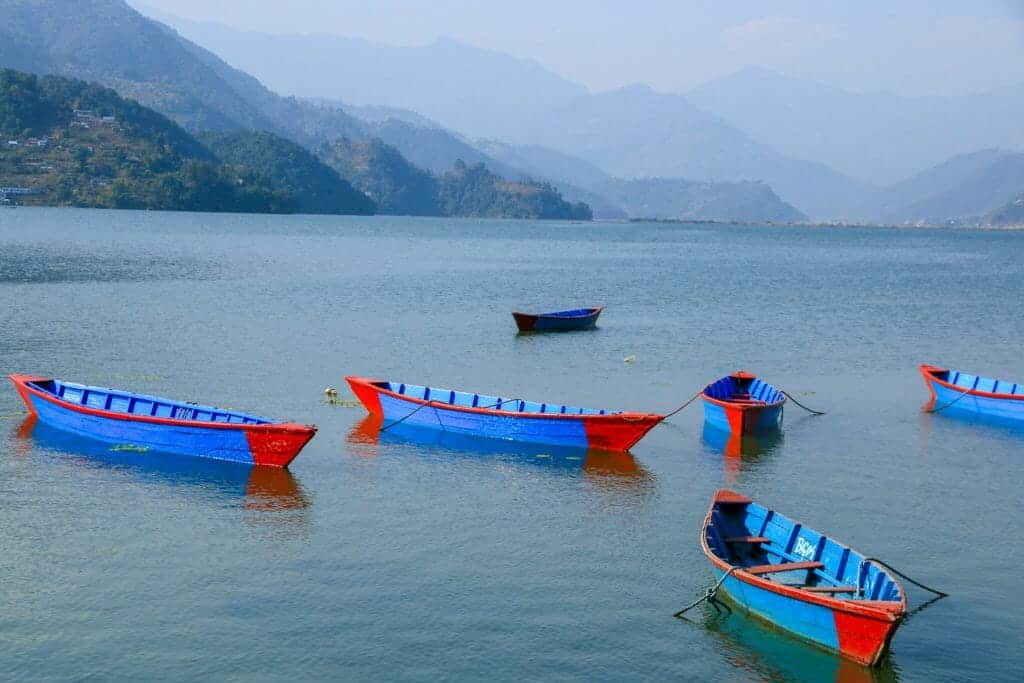
Pokhara is Nepal’s number 1 adventure destination and the gateway to treks in the Annapurna Region, with plenty of entertainment like boating, hiking paragliding, and valleys.

Lumbini is the Buddha’s birthplace, one of the world’s most important spiritual sites, and attracts Buddhist pilgrims from around the world.

CHITWAN NATIONAL PARK
In the southern region of Nepal, the jungles await you with wildlife experiences. Here you can see the Royal Bengal tiger and watch the one-horned rhinos roam free.

EVEREST REGION
Located in the northeastern province of Nepal, this region has vast glaciers, icefalls, the highest mountains, deep valleys, precarious settlements, and hardy people challenging the harshest conditions in the thin air of high altitude.

ANAPURNA REGION
The Annapurna region is the most diverse and popular trekking area in Nepal. Views of lush farmland and natural forests and snow-capped mountains, and encounters with many ethnic communities.
Nepal Trip Cost
Let’s talk about Nepal Trip costs now, as it is one of the most important things during your Nepal trip planner. The good news is that prices in Nepal are quite affordable. But as I always say, it will depend on your travel style.
- You can spend as little as US$20/day per person if you choose to stay at a Hostel and cook your own food.
- If you choose to stay at a 3-star hotel and eat at local restaurants, it can cost you an average of US$100/day per person .
Keep in mind that most likely you will be traveling around the country. Most people go hiking in the Himalayas (far from Kathmandu), and you will pay for transportation to get there. To take an 8-hour bus ride from Kathmandu to Pokhara costs US$25 per person or you can choose a 25 minutes flight for US$120 .
While trekking, you will have expenses with the lodges which can be as cheap as US$5 per day, plus an average of US$7 per meal. Hiring a porter will cost approximately US$10 per day and if you have a guide, prices can vary.
You will also need to pay for everything else: hiking permits, liters of water (no bottles), Wi-Fi service, hot shower, hot tea, etc. Once you reach the summit, you can decide to take a helicopter flight back to the city if you don’t want to hike back, but this will add to your budget.

Nepal Trip Planner: Getting Around & Transportation
🚗 car rental in nepal.
I traveled by airplane and by car during my trip to Nepal and I don’t recommend renting a car in Nepal. The roads can be chaotic and take too long to go from one place to another, so my first option was to fly to save time.
The pavement stops at the city limits, after that the roads are pothole-filled, dusty, dirt paths. The big cities are pretty much walkable, and I walked almost everywhere in Kathmandu and Pokhara.
But you still consider to rent a car in Nepal, I use and recommend to my readers Discover Cars . They have ratings for all companies, so make sure to eliminate any that don’t have a good reputation. You also can buy Finish car insurance right from Discover Cars , so you’re not surprised with an unexpected bill when you pick up the car.
🌟 You can compare and save up to 70% on your rental car when you book through this site . I use and recommend Discover Cars because it is the most reliable rental car source, and it allows you to compare the prices of different places.
🚌 Public Transportation in Nepal
There is no train or reliable public transportation in Nepal (other than buses). But if you are going to rely on buses in Nepal, be prepared to take a long time even for short distances.
Kathamandu is only 125 miles (200 km) apart, but the bus ride takes at least around 5-6 hours. The same journey takes around 35 minutes by plane, and the prices are very affordable.
🚖 Taxis in Nepal
It is easy enough to take a cab in Nepal, but you will need to negotiate before you get in , as they will try to charge you much more. The price can vary during the time of the day and also, depending on where you are going or coming from. Note that there is no Uber in Nepal.

Nepal Trip Planner: Accommodation
One of the most important things to consider during your Nepal trip planner is to choose the right accommodation, at the right area. During my trip to Nepal, I used a mix of hotels in the cities, tea-houses during my trekking, and homestay in the rural areas .
The accommodations in Nepal are generally cheap and you have many options to choose from. It will depend on your preference and budget.
When you are visiting Kathmandu and Pokhara, you will have many options for hotels, hostels, or private rooms. While hiking in the Himalayas, you will stay in tea houses along the way.
Best accommodation options in Kathmandu:
If you are staying in Kathmandu, the best area is around Thamel, but keep in mind that the area can be noisy and very busy. Here you can find hundreds of guest houses, hotels, and hostels. It is the best area to stay in, especially if you are visiting Kathmandu for the first time. Here you can soak in the real Kathmandu, walk the streets while shopping, or just do people’s watching.
MY PERSONAL RECOMMENDATION | Beautiful Kathmandu (⭐️ 8.3) This is where I stayed and I highly recommend it. The service is excellent, they have a continental breakfast included in the price. The rooms are very comfortable, and the location is excellent. I just walked everywhere, including safe to walk at night if you need to go out and grab a drink or dinner. Rates can be as low as $35 per day.
MID RANGE | Nepali Ghar Hotel (⭐️ 9.0) has a restaurant, bar, and terrace area plus a fitness center. It is a modern boutique hotel, with very nice decor and friendly staff. The location is very convenient and a continental breakfast is included in the price. It has very high reviews on Booking.com
LUXURY | Baber Mahal Vilas (⭐️ 9.3) besides being listed as a luxury, the good news is that the price is not steep, the average is $150 per day. This is a very beautiful hotel, with an excellent restaurant that serves dinner and breakfast. The amenities are great and it is a little oasis inside the Thamel area.
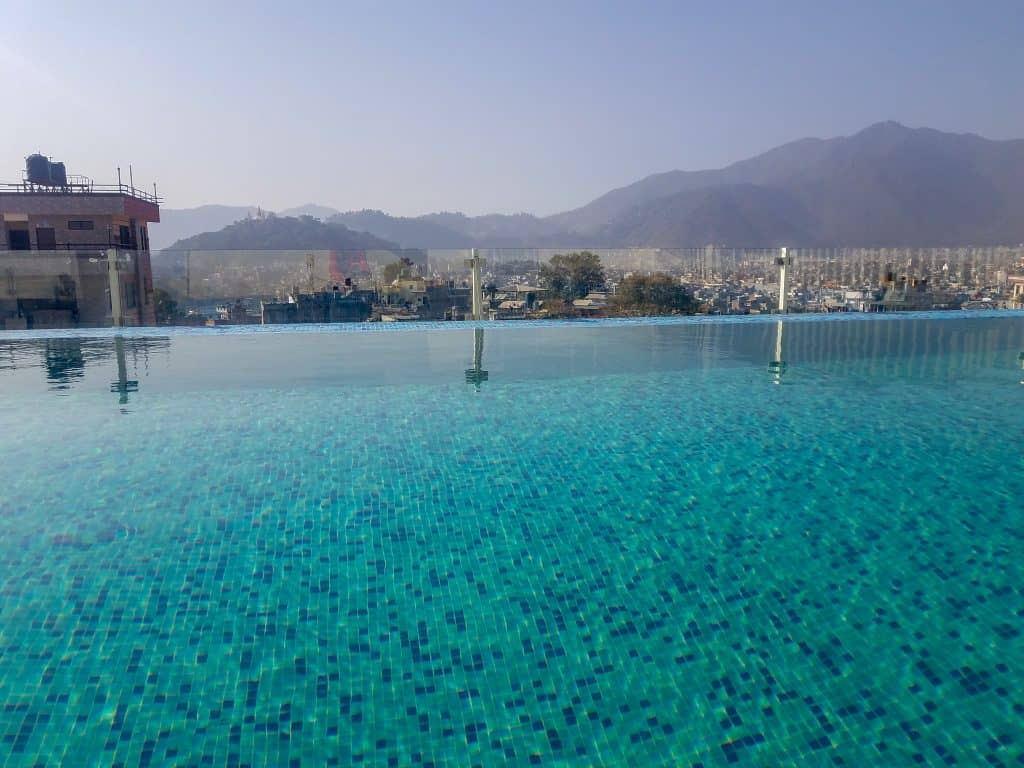
Best accommodation options in Pokhara:
A good area to stay in is around the lake, as it is within walking distance from the city center, shops, restaurants, bars, etc. There are so many options for hotels in Pokhara, as it seems that each year dozens of new hotels open.
MY PERSONAL RECOMMENDATION | White Pearl Hotel (⭐️ 8.8) : I stayed at the White Pearl and I highly recommend it. It is only a 6-minutes walk to the lakeside, the views from my room were phenomenal, and the breakfast was really great with lots of options from fresh fruit to some local dishes.
BUDGET | Hotel Lake Shore (⭐️ 9.3) : This hotel is the best deal for you if you are traveling on a budget! I love that this hotel is a sustainable hotel, it is located only a 7-minutes walk to Lakeshore. Also, the rooms are very comfortable and even better!? It comes with a delicious breakfast with the Annapurna views.
LUXURY | The Pavilions Himalayas The Farm (⭐️ 9.3) : Do you want to stay at a 5-star hotel, without paying 5-star pricing? Even listed as a luxury, the prices of this spectacular hotel are really affordable. You will have your own terrace, swim pool, and an international restaurant with breakfast included.
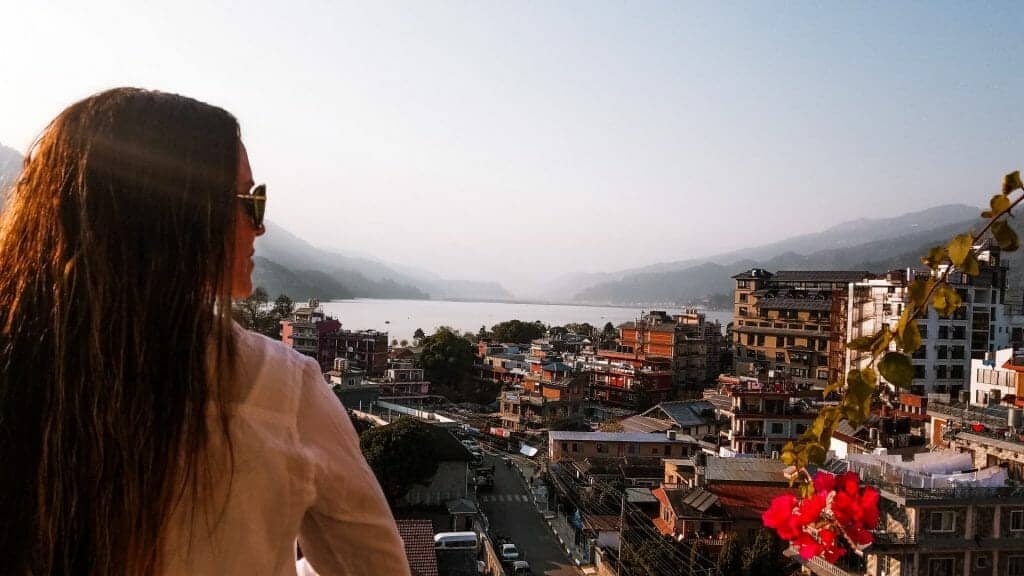
Accommodation options in the Himalayas
During your hiking in the Himalayas, you will have options of lodges or tea houses to stay. They are normally 3-4 hours apart and clustered together.
During the high season, you will need to book in advance as it gets busy and you may not find a room. They are normally very simple and offer a basic stiff mattress and warm blanket for you to spend a night during your hiking.
The accommodations are very basic, the walls are thin and the rooms don’t have heat. Typically you will have 1 outlet and 1 light bulb with 2-4 beds per room. A few rooms have bathrooms in the room and some lodges offer a gas-heated shower.
Lodges also have a main room/dining area. The main room is where people gather in the evenings to eat their meals and their share stories from the day. The main room is the warmest place to be in the evening. The lodges all offer basically the same menu (see below), and Wi-Fi is often available for a small fee.

What to Pack for a Trip in Nepal
I visited Nepal during wintertime, and it was cold in the morning and evening, with more comfortable temperatures during the day. The rule of what to pack for Nepal is layers.
Also, Nepal is a very religious and conservative country, therefore consider this when you are packing and dressing conservatively.
- Portable Battery Pack: This battery last up to 7 phone charges
- Sarong: For a multi purpose cover up
- Water Purifier Steripen: It sterilized a liter of water in 90 seconds
- Portable water bottle : Remember to bring and drink a lot of water
- Trekking Poles : If you are considering to hike in Nepal have hiking poles, as they do make hikes easier and your recovery time shorter
- First-aid kit : Remember to pack kit for Hiking in Nepal
- Day-Backpack : This is very handy for any hiking.
- Wear sturdy shoes for hiking: The most important thing is to protect your feet and avoid twisting your ankle and get injured. I recommend investing in a good hiking boots brand such as Teva , Salomon , or even Keens .
- Moisture-wicking clothing: These clothes help to pull the sweat away from your body and stay cool and dry during your hiking such as light hiking pants & long sleeves shirts .
- Warm-Layers: Early morning or late night can get cold so it is important to bring layers, a lightweight puffy jacket is a must!
- Hiking Jackets: You will wear one them a lot!
Pack Light & Smart when you Travel to Nepal
Here is one of the most important Nepal travel tips to keep in mind . I recommend packing in a backpack if you are planning to travel around Nepal. Consider that you will be traveling from point A to point B on public transportation. Or even if you fly, it is easier to just have a carry-on item with you. Pack light and smart is always my rule of thumb!
I love traveling with my Osprey Backpack , and if you are taking a backpack, I recommend rolling your clothes and using small packing cubes separated by categories (pants, tops, socks…), so you don’t need to empty the backpack every time when you are trying to reach to the items you need. Here are the best backpacks for travel that I recommend.

Nepal Weather & When to go
Nepal is a country of extremes. The low-land plains of the Terai can have tropical temperatures. The Himalayas can get to sub-zero temperatures, but the sunshine can bring some warmth during the day, even in the mountains.
- Spring (March to May): Ideal for trekking and mountaineering as the weather is mild, and the landscapes are adorned with blooming rhododendrons.
- Summer (June to August): While lush greenery prevails, heavy monsoon rain makes trekking challenging. Best for cultural exploration in lower regions. The wettest month is July with an average of 325.3mm of rain. The morning and night are cold and the days are warm when sunny. June is the hottest month in Kathmandu with an average temperature of 73°F (23°C) and the coldest is January at 49°F (9°C) with the most daily sunshine hours at 12 in April.
- Autumn (September to November): Clear skies and moderate temperatures make it the prime time for trekking and outdoor activities. Festivals add cultural vibrancy.
- Winter (December to February): Suitable for low-altitude trekking and cultural exploration with clear skies, although high-altitude regions can be cold.
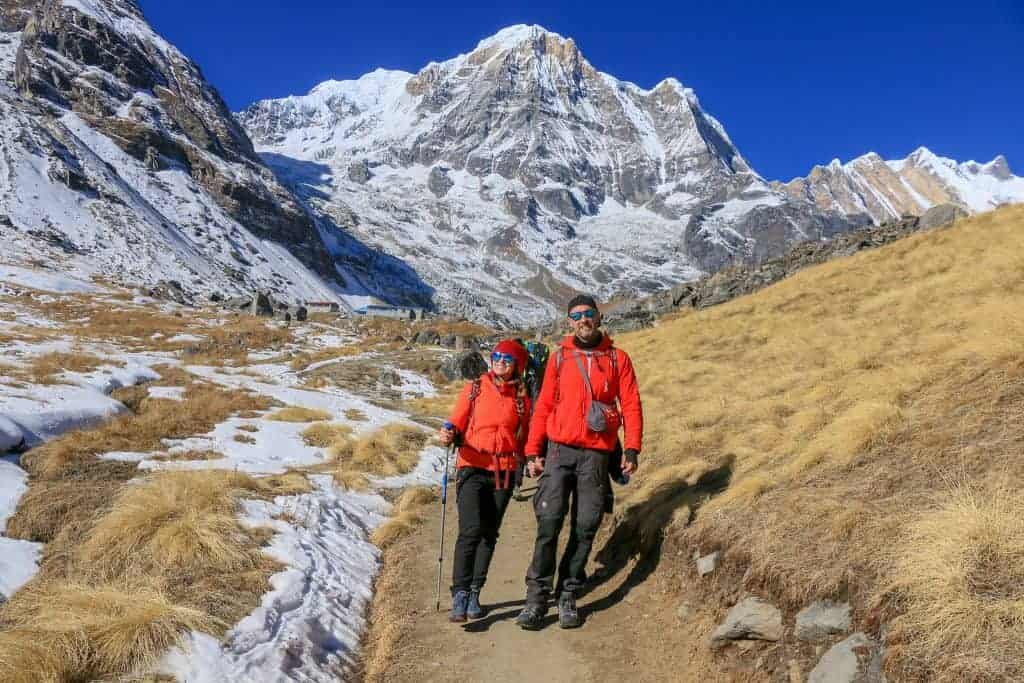
Nepal Trip Planner: Safety
I found Nepal a very safe country to visit. I didn’t see any signs of violence during the time I was visiting.
I even had an episode where I forgot my laptop at the lodge at the Annapurna Base Camp, and I just noticed the next day. My guide was able to contact the person in charge of the lodge, and my laptop got rescued by helicopter and got to the city before me.
The only annoying thing I found in Kathmandu is the guys selling drugs in the streets – not only at night time. In every country, you will see this around the tourist areas, but I found that in Kathmandu it was more than any other place. They are not aggressive and whenever you deny, they will leave you alone.
If you are wondering if you need Travel Insurance to Travel to Nepal, the answer is YES! You absolutely need travel insurance to travel to Nepal. Request a quote from this link and you will be surprised how cheap is to have your trip covered and travel safely.
I use a service called HeyMondo and can highly recommend them — they offer affordable prices, great coverage, comprehensive travel + medical insurance, an app with 24-hour medical support, and no out-of-pocket fees.
🌟 Get 5% off your policy by booking through this link. 🌟

Food in Nepal
The cities offer a great variety of restaurants and dishes. From local cuisine to Indian to Western.
The food in Nepal is very good as they use a variety of unique spices. I was also surprised by the large variety on the menu in the lodges during the hiking; I didn’t expect to have so many options.
You also have an option to try the Nepal Cooking School to learn more about the amazing flavors of Nepal
- Dal Bhat –Dal is a soup made of lentils and spices, served over boiled grain, and Bhat is boiled rice. These two ingredients are accompanied with vegetable curry and tarkari. Condiments are usually small amounts of extremely spicy pickle which can be fresh or fermented.
- Momo –is one of the most popular dishes in Nepal. Momos are usually steamed dumplings, with a filling of meat or vegetables. It becomes succulent as it produces an intensively flavored broth sealed inside the wrappers and served with a curry dipping sauce.
- Nepali pizza – Very simple, but makes a great meal especially at night after our hike. A simple homemade dough with cheese and tomato is popular in Nepal and covered with cow or yak cheese.
- Breakfast – Nepali people usually do not have breakfast, so keep in mind that if you are in a non-tourist area, you will only have coffee or tea options. But if you are in the city you can find great cafes with pastries or find a continental or American breakfast pretty much everywhere, including during the hiking at the lodges.
- What else – Indian cuisine has a huge influence in Nepal and you can find a large variety pretty much everywhere. I did miss my greens, as I am very big on salad and in Nepal you don’t have the option for fresh green salads. I also avoided eating meat, as they are not very big on red meat. I did try some dishes with chicken and fish and they were all delicious.

Nepal Trip Planner Guide
During my planning for the my Nepal Itinerary , I researched the internet and also, bought some books and maps to help me with my itinerary in advance. An excellent guidebook that I used during my itinerary preparation is the Lonely Planet Nepal Travel Guide , as it has tons of great information.
One of my top Nepal travel tips for you as that you include to visit at least one big city to get the vibe of the unstoppable lifestyle in Nepal. I booked almost everything in advance – flights, accommodations, trains, and Everest Base Camp Helicopter tour and my trip to Pokhara .
Remember that pre-planning, researching, and understanding what you are looking for will help make your travels far more successful and safe. I have spent a good amount of time researching, and spent a month traveling around Nepal, and these articles will be extremely helpful with tons of Nepal trip planner for you:
- Unique Ideas for Nepal Itinerary: from 7 days to 3 weeks
- 30 Interesting Facts about Nepal you need to read before your trip
- Perfect Kathmandu Itinerary
- Perfect Pokhara Itinerary
- 17 Best Hikes in Nepal
- 10 Best Everest Base Camp Helicopter Tours
- How to hire a porter in Nepal: Prices and Tips
- How to do a Homestay in Nepal rural village
- How to train for a high altitude hike

Photography & Electronic Equipment
There are so many amazing opportunities for photos and videos, so it is impossible not to capture the amazing moments while traveling around. Therefore, do not forget to bring your camera equipment with you:
- This is the camera I use and love – Sony Mirrorless a7III
- Bring a couple of good lenses for different pictures – I always carry this lens with me
- Extra memory cards
- I recommend bringing some filters
- Tripod to photograph the waterfalls and depending on the time of the year, the Aurora Borealis.
- If you want to capture amazing videos, I use and recommend a Gimble Smartphone Stabilizer
- I also recommend a GoPro HERO9 for some action images videos and pictures.
- You can also capture incredible Drone images in Jalapao I use DJI Mavic Air 2
- If you are looking to take photos underwater this Underwater camera (with accessories) is a great option

Nepal Trip Planner final thoughts
I hope this Nepal Trip Planner guide helps you to plan a safe and fun trip. For any trip you go, preplanning, research, and understanding what you are looking for will help make your travels far more successful and safe.
Make sure you have the places you want to visit highlighted. Nepal offers amazing things to do and explore. You can visit my Travel Planning and print the easy 10-steps to plan an international trip.
Below are the 8 ESSENTIAL STEPS for planning your trip to Nepal:
- DECIDE HOW MANY DAYS YOU HAVE AND WHAT YOU WANT TO VISIT: Depend on how many days you have to explore Nepal, you can visit the main cities of Kathmandu and Pokhara, and if you have more time you can add a trekking in the Annapurna Base Camp or Everest Base Camp.
- BUY A GUIDE BOOK: During planning your trip to Nepal, an excellent resource is to buy an Nepal Travel guidebook . They have tons of great information on main attractions, places to stay, and many curiosities about Iceland’s culture.
- CHECK VISA REQUIREMENTS : Get your Nepal visa through iVisa if you don’t want to fill out the forms yourself.
- BOOK YOUR ACCOMMODATION IN ADVANCE: Make sure you book your accommodations in advance to take advantage of the best prices and best options. I recommend Booking.com as it has a great policy of free cancelation.
- BUY TRAVEL INSURANCE: Wherever you go or do during your travels, don’t travel anywhere in the world without travel insurance; the unexpected can, and often does, happen. I strongly recommend reliable travel insurance through HeyMondo
- START PACKING: It will depend on when you go to Nepal to pack accordingly. Check my recommended packing list.
- BE A RESPONSIBLE TRAVELER: Responsible and Ethical traveling is REALLY IMPORTANT. Check my complete guide
- BOOK ANY TOUR IN ADVANCE: There are great options for group or private tours in Nepal. I recommend booking through Epic Adventures Nepal and use my discount code for 10% discount (Discount Code: PPP10)

Follow + Share
If you found this guide useful, follow me on Instagram to stay up to date with my travels & Subscribe to my YouTube Channel to keep you with my workout videos.
I would love it if you could follow me on Pinterest and share this guide on my social media.
Plan your Trip
You can plan your trip with this easy guide and have access to the best services I recommend and you can get discounted prices.

Unique Ideas Itinerary for Nepal: From 7 Days in Nepal to 3 Weeks

Kathmandu Itinerary: 25 Epic Places to Visit in Nepal in 2024

How to Hire a Porter in Nepal: Ultimate Guide for Trekking in Nepal
13 thoughts on “nepal trip planner in 2024: trip cost, what to see, know and do”.
PPP, always inspiring our travels!!!!
Yeah! I am so glad to hear it…keep on traveling!
Wow, that’s an incredibly thorough guide! I imagine that hiking is pretty tough (or would be for me…I’m not in as good of shape as you! lol), but the views look like they’re totally worth the effort.
Lots of helpful information here! I have memories fascinating temples, beautiful snow covered mountains mixed in with food poisoning & bedbugs. I would love to go back to Nepal as there was so much I missed. I love your pics! Thanks for sharing!
This brought me back to the time I went to Kathmandu and Pokhara. 2015, I think? A week after I left, the earthquake happened. It was so shocking. I would love to visit again.
That pretty much covers everything! Will definitely save it for later as Nepal is very high on my list.
Wow that’s for sharing such a detailed guide to Nepal .it’s very useful and I have saved it for when I travel to Nepal
I really hope you get to visit Nepal soon, I know you will love it.
Oh wow! I am glad you were not there anymore when the earthquake happened. I was going to Nepal that year, but I had to postpone my trip because of the earthquake
I am glad you like this guide Linda – I have great memories, and not too great memories, as I do have food poisoning and even an bacteria infection memory too. But Nepal is definitely such an unique place.
Erin, you are right. The hiking in Nepal is AMAZING! But not easy – because of the altitude, especially. But there are amazing hiking to explore in Nepal, including shorter as a day hiking.
Namaste Paula That’s a good in-depth guide, although, from 2021, I think the local SIM CARD situation may change because it is required for all the locals to register their phone’s IME number before it can be used with a SIM card. I guess more information will come as we move into 2022, and when travel opens up again.
Namaste Nima – This is great information. Thanks for letting me know and I will update the post as soon as we have more information.
Leave a Comment
This site uses Akismet to reduce spam. Learn how your comment data is processed .
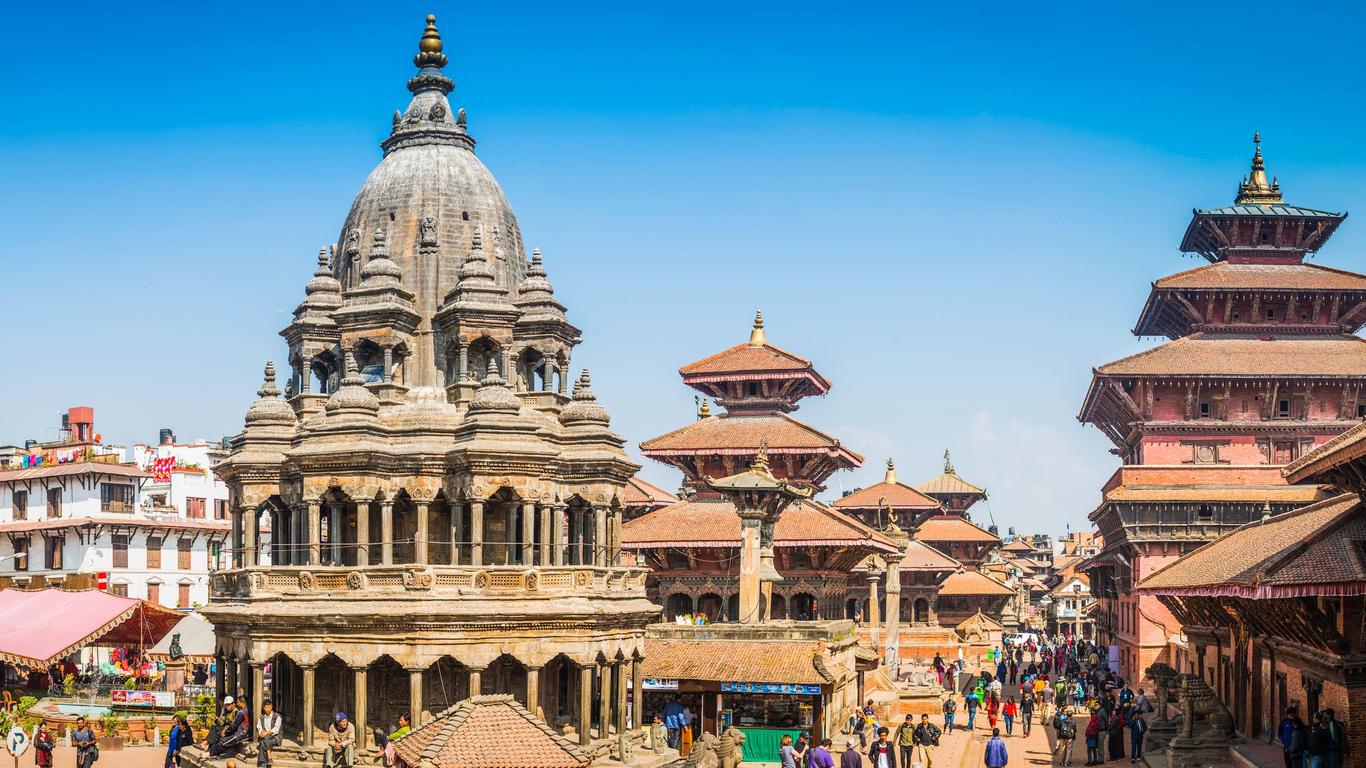
Find cheap flights to Nepal from $406
This is the cheapest one-way flight price found by a kayak user in the last 72 hours by searching for a flight from the united states to nepal departing on 6/5. fares are subject to change and may not be available on all flights or dates of travel. click the price to replicate the search for this deal., search hundreds of travel sites at once for deals on flights to nepal.
Save 22% or more Compare multiple travel sites with one search.
Track prices Not ready to book? Create a price alert for when prices drop.
Filter your deals Choose cabin class, free Wi-Fi and more.
Bundle and save Save money when you bundle your flight + hotel.
Best Nepal Flight Deals
Cheapest round-trip prices found by our users on KAYAK in the last 72 hours
Good to know
Faqs - booking nepal flights, what are the requirements for travel to nepal.
Tourists visiting Nepal require a visa upon entry according to the travel laws of Nepal. You can get the tourist visa upon arrival from the Nepali Department of Immigration or before traveling from the Nepali Embassy in the United States. The tourist visa only allows stays of no more than 150 days. You also need a passport with remaining validity of at least six months from the time of entry. The passport should also have a blank for the Nepal entry stamp.
What are the common stopover options for flights from the US to Nepal?
Currently, all the flights departing the US for Nepal have at least a single stopover en route. The stopover options for these flights vary depending on your destination city, airline, and arrival airport. Most flights from New York (JFK) to KTM have common stops in London Heathrow (LHR), Colombo (CMB), Doha (DOH), and Dubai (DXB). Flights from San Francisco (SFO) to the same destination have common layovers in Seattle (SEA), JFK, Chicago (ORD), Seoul (ICN), Delhi (DEL), DOH, and DXB depending on your airline.
Can I find public transport from popular airports in Nepal to the city center?
Yes, public transport is available from airports in Nepal like KTM and PKR. Buses are the most popular, reliable, and affordable public transportation from these airports. The buses at KTM are available from the front gate and offer frequent rides into the Kathmandu city center. Taxis also head into the Kathmandu city center and are much faster. Buses frequently operate from PKR to the Pokhara city center.
Which airlines offer flights to Nepal?
If you’re planning to fly to Nepal from the US, you will be happy to learn that several major airlines operate this route. Qatar Airways, Emirates, Air India, and Cathay Pacific offer the most one-stop flights from various US cities to Kathmandu. American Airlines, British Airways, JetBlue Airways, Delta, Kuwait Airways, Korean Air, Etihad Airways, Iberia, and Singapore Airlines offer two-stop flights from the US to Nepal.
What can I do during a layover at Tribhuvan International Airport?
US travelers with a layover at KTM will find plenty to keep them busy at the airport before their next take-off. You can grab a bite at one of the cafeterias and restaurants at the International Terminal building if you’re not a fan of flight food. The building also has a couple of duty-free stores where you can shop for gifts or souvenirs. You can also relax at the comfortable lounge areas at KTM after your 20h flight to Nepal. The lounge areas have Wi-Fi, complimentary snacks and drinks, and magazines. They are accessible either through a single-visit pass or a membership card.
Do airports in Nepal offer accessible services?
Yes. If you're a passenger with reduced mobility, you will get assistance when traveling through Tribhuwan Airport. The airport is wheelchair-accessible and offers a wide range of special needs amenities accessible restrooms, stair-free options, and wheelchair assistance services. To get a wheelchair, visit your airline’s ticket counter or use any of the airport’s courtesy phones to call them. We recommend reserving these services with your airline at least 48 hours before your flight to avoid any delays or inconveniences when traveling.
Which cities are served by popular airports in Nepal?
As Nepal’s main international airport, KTM serves Kathmandu, Muzaffarpur, Darbhanga, Gorakhpur, and Patna. Meanwhile, PKR serves Pokhara, Lekhnath, Khairenitar, Waling, and Baglung. Roads mostly connect the airports to the cities they serve, so you will have to take a bus to your final destination once your flight lands.
How can I get to Lumbini from Bhairahawa Gautam Buddha International Airport?
Bhairahawa Airport is situated 8 miles from the city center and traveling from the airport to Lumbini takes about 1 h 30 min. One of the most recommended options for getting to Lumbini from the airport is by using a bus. Sakura Green offers transportation on this route and has stops at Kotihawa, Manigram, Drivertole, Yogikuti, and Butwal before finally getting to Lumbini. The bus runs once per day.
How long is the flight to Nepal?
An average nonstop flight from the United States to Nepal takes 24h 49m, covering a distance of 7776 miles. The most popular route is New York - Kathmandu with an average flight time of 19h 55m.
What is the cheapest flight to Nepal?
The cheapest ticket to Nepal from the United States found in the last 72 hours was $676. The most popular route is New York John F Kennedy Intl to Kathmandu Tribhuvan and the cheapest round-trip airline ticket found on this route in the last 72 hours was $676.
What is the most popular destination in Nepal?
Based on KAYAK flight searches, the most popular destination is Kathmandu (100% of total searches to Nepal).
How does KAYAK’s flight Price Forecast tool help me choose the right time to buy?
KAYAK’s flight Price Forecast tool uses historical data to determine whether the price for a given destination and date is likely to change within 7 days, so travelers know whether to wait or book now.
Top tips for finding cheap flights to Nepal
- Enter your preferred departure airport and travel dates into the search form above to unlock the latest Nepal flight deals.
- All flights to Nepal from the international airports in the United States are stopover flights. They include one to three stops, with most flights to Tribhuvan International Airport (KTM) having one stopover while those to Biratnagar Airport (BIR) and Pokhara International Airport (PKR) have two.
- Kathmandu Tribhuwan International Airport (KTM) is the busiest airport in Nepal. Situated at the heart of Kathmandu and just 3.5 miles Eastside of the city, KTM serves as the gateway to Nepal. The airport receives most of the flights from the US, thus booking your flight to this airport will give you more flight options to go for.
- US travelers who wish to be close to the city center of Nepal’s capital, Kathmandu, should fly into KTM. The Kathmandu city center is approximately four miles from KTM, making it accessible from the airport.
- Bhairahawa Gautam Buddha International Airport (BWA) is a new airport in Nepal. The airport was specifically built to serve as an alternative route to Tribhuwan Airport which is about 170 miles away from Bhairahawa city. Consider flying to this airport if your destination is around Bhairahawa.
- Nursing mothers on flights to Nepal can find nursing stations at KTM. These stations are located at the Departures and Arrivals Terminals and provide you with privacy for breastfeeding.
- If you're looking to travel with your furry friend from the US to Nepal, you will be delighted to learn that Kathmandu Airport is a pet-friendly facility. You will be allowed to travel through the airport with your pet provided it remains inside a carrier while within the airport.
- Travelers looking for foreign exchange and banking facilities can find these services at KTM. You can find local and international banks, currency exchange booths, and ATMs at the International Terminal of the airport.
- KTM hosts the Executive Lounge on the Second Floor Landslide of the International Terminal. You're welcome to use this lounge to relax and unwind before or after your flight to Nepal. You can access the lounge through a prepaid lounge pass or lounge membership programs.
- Take a flight to Tribhuvan International Airport (KTM) if you plan to tour Mount Everest in Nepal. KTM is the closest international airport to Mount Everest. Once you land at KTM, you should take another flight to Lukla Airport (LUA), about 23 miles to Mount Everest.
- If you’re looking to drive yourself around Nepal, start by getting a car rental from Kathmandu Airport. The airport hosts car rental agencies at the Arrivals of both terminals.
Top 5 airlines flying to Nepal
Great to have actual hot tastey meal on a flight. Well done
I commend the flight attendants on our SFO-SIN flight who went above and beyond to provide us with extra snacks and food. This type of service makes the flight experience personal and awesome.
It was a great flight Food was great Crew was spectacular
They made me check my carry on even though there was room We un boarded in a strange way but overall it was good
In general good, but the machine seems to be long in operation and some functions were restricted as e. g. Adjusting of seats.
It seems paying premium economy does not make difference with economy. No priority boarding, not worthy paying extra$$$ for premium economy.
People were so nice! Economy seats were small and cramped feeling for me. I’m slender and 6 feet tall
The singapore airline now compared before covid, I like the service before covid. SQ was the best of all airlines but now I am going to look for different airline if I am travelling in asia.
A pc of cake or biscuit at least. The airport was like a maze need to take another bus to the main terminal to immigration.
Flying with Singapore airlines is always excelllent - the crew are lovely and the food too is great. It’s my number 1 airline
Flight got canceled without any prior information and it caused lot of trouble
No entertainment u less you pay. Wish there were some free movies
Staff were friendly, and provided great service. The food was plentiful and delicious. Food could have been hotter.
I was traveling business purposes and I only had one carry on and a personal computer back pack . My carry on was 8.5 kg little more than allowable. At jfk airport check in they did not let me carry it . I was little disappointed.
More leg room and comfortable seats at least for long flights
The entertainment selections are amazing. But the live TV is sometimes spotty. If you’re going to have it, then have it. If you can’t make it consistent, then, perhaps it’s better not to have it. The crew are always cordial when approached, but they seem to do the minimum and sit around, talking to each other in the back of the plane during the flight. I realize that delays are not always predictable, but I missed my flight in Dubai because we left 90 minutes late from Washington. I will say that Emirates took very good care of me in Dubai. But I would rather not be delayed.
Probably the best flight I’ve ever been on. Emirates first class is leagues beyond British airways and Lufthansa’s.
Great flight. Comfortable seats, courteous service, and excellent selection for entertainment.
Serving food took so long . Almost time close to lend. Plus during landing air pressure in cabin cuss ear blocked took long time to unblock.
Emirates is usually on time, but not this trip. Also, during the flight the attendants disappear unless called upon. Very strange. I have watched the quality of Emirates service diminish over the last five years.
Operated by American Airlines. Very chaotic and the crew was bit rough responding any enquiries. Restricted leg space.. Qatar would have been better
Qatar airways from Doha to guangzhau was excellent big bird Boeing 777 more room and smoothly flight, I Love it
It was good no problems made it on time for the next flight overseas!
The made us waiting and held our passports and boarding pass making us miss our flights
Not impressed. Only allowed one carry on on such a long flight.
The flight was good but my neighbor had the vent open full power for the whole flight and because the air was blowing from the side instead of from the top and I got very cold and ended up with a sore throat.
Bad experience with the delay n long wait time for connecting flight after missing the connection flight from Doha.
Wore experience due to delay and took me 3 days to reach my destination.
All over with Qatar airlines my experience was really bad due to delays and then putting me on different airlines and after 8 hours of wait I had to listen to their is no plane to fly for another 24 hours. Wore experience ever.
Excellent will be flying again in May with Qatar. to Botswana.
Excellent service and comfort from the moment you check in. Flight crew is hyper focused on making passengers comfortable and at ease. It’s like a flying hotel!
Only chicken as a meat dish through out the flight
Nothing really was great as such. Seen other no name airlines perform better.
Quality of service on board was very inconsistent. FA service primarily seemed robotic and they barely engaged with passengers
I’m unclear why I had to pay extra for assigned seats as Turkish airlines did not honor the seating. We were placed across the aisle from each other on TK 34, and were seated behind one another on TK 694. Because my name was misspelled on e-ticket (Klawiter, instead of Klawitter) I could not log onto website to get the connection gate number in Istanbul. The monitors in the airport were a jumbled mess 1/2 Arabic and 1/2 English.
On line check in needs a lot of improvement. I tried and gave up.
Food not good, flight attendants not the best, not accommodating very ruff
the female flight attendant was racist towards me. I could tell she treated the two other passengers next to me with more softness.
Oh my god! For an13 hour flight they serve you food just one time. Also don’t be thirsty they give you a little small cup of soda to drink. They seem like their goal is to feed you one so they don’t have to be bothered with you. It quite surprise for such a long flight there are several times to eat at least three and the food was well lackluster. The food and lack of offering drinks which were always hot no ice provided.
We were traveling first class. Checkin counter lady and her manager, both were in bad mood and did not treat us well about checking in the handbag. The gate agent took care of it right away. I travel Turkish twice a year in first class. No one has ever refused to check in the hand bag. Not sure, why this agent and her manager refused. Everything else was excellent.
Communication was terrible. Flight was delayed for 4-5 hours in DC (on the front end, and also after we boarded, we had to get off - some issue with fueling the old plane correctly). There was little to no information on timing or what was happening. Once we reach Delhi airspace, apparently there was weather that caused us not to land - we were actually near the ground, saw the run way, and lifted back up to the sky after being sooo close. Then we circled for about 30 minutes, and they decided to go to Jaipur to land until the weather cleared and to refuel. Again, once we landed in Jaipur (wrong city), there was little to no information on timing or what was happening. Then we heard that the crew was reaching their 24 hours. We sat on the place, on the tarmac for another 3 HOURS, with no food and not enough water for everyone on the flight. Then, they kicked us off the plane with no plan, in the wrong city. We went thru customs, got our bags (thank goodness), and had to ask a bunch of staff what was happening and what to do. Eventually, their soltuion was to bus people back to Delhi (like 6 hours we were told) but not everyone would fit on the bus, and unknown timing on when it would leave. At this point it was 9PM (we were scheduled to arrive in Delhi at 11AM...). My husband and I decided to risk it and take a cab that we had to pay ourselves (about $200 US dollars) to get to Delhi (about 5 hour drive). We both had terrible trips back to the US as well - almost missed connecting flight, forced to pay for carry-on luggage (a small back pack!) and duty-free goods by the Air India staff last minute. Just terrible experience all around. Never again with AI! The ONLY good thing was the air hostesses were kind and patient - example: they made sure people with food allergies got their correct.
It would have been perfect if there was onboard entertainment.
Food was unfit even for prisoners. larger front seats are terribly uncomfortable, which is ironic. Thorough need to upgrade aircraft on such a long route.
Food could be better they need a better caterer in DC flight from India always has better food
Everything! To start with, seats, food tray table, entertainment console all are broken! Imposing duty free baggage fees for $250 as a surprise penalty cannot be appreciated! Airlines should be responsible for transferring the checked baggages to the connecting flight. Having customer go through the transfer is painful considering the travel tiredness! No soft drinks served on flight is another crumble!
Old creaky plane, poor entertainment, USB port did not work. Food was ok.
Old fittings. Went business class. Staff not very considerate regards comfort.
Very old plane. Broken tray tables n seats. Entertainment system super slow to operate and very little content.
Service was good, crew response was prompt. The baked fish and Malay fish as well as the sauces with them were bland.
Screen are not working. Windows not clean. Staff is very good. Food is okay. Experience is good. I hope the up coming is more then betters for others airlines thank you.
Book Cheap Nepal Plane Tickets
Recent round-trip flight deals, search by stops, search by airline, search by price, recent one-way flight deals, last minute flights to nepal, last minute flight, train and bus deals, flights to nepal, return flight deals:.
Nepal - United States
Cabin classes:
Browse origins:.
- Flights »
- United States
Browse destinations:
- Worldwide »

2 Weeks in Nepal: 3 Itineraries
DISCLAIMER: This post might have links to travel services and products that we enjoy. We might make a commission from it at no extra cost to you.
Nepal is one of the most popular destinations located in the Himalayas mountain range . A chance to get close enough to the ceiling of the world. The home of the highest mountain, unique animals, and the home birth of Buddha and Gurkha elite fighters.
Being a landlocked country, Nepal’s tourism is driven by trekkers of Everest Mountain . Today, almost 80% of foreign visitors to Nepal come for the mountain. However, if you only have 14 days, can you even go on a trek? Is there something else worth seeing here?
This 2 weeks in Nepal itinerary will answer exactly that. This guide includes travel itineraries for Nepal, covering both trekkers and non-trekkers. I also listed below everything you need to know before you plan and book your trip to Nepal.
CHECK OUT: 2 weeks in India itinerary
THINGS TO KNOW BEFORE VISITING NEPAL
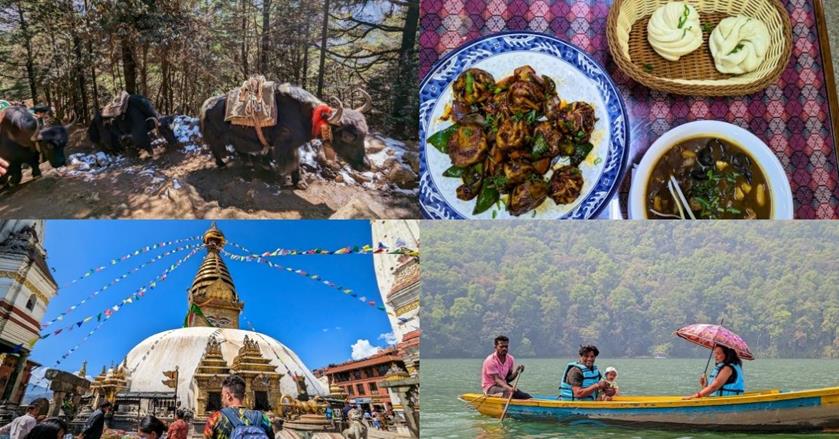
You don’t want to travel halfway across the world just to find out you’re visiting at the wrong time or planning a trip that’s too cramped. Below are answers to basic things you should remember about spending a vacation in Nepal.
When is the best time to go to Nepal
The best time to visit Nepal, particularly for the Everest Base Camp Trek, is during the pre-monsoon season (March to May) or post-monsoon season (late September to November). During these periods, the weather is usually clear, providing stunning views of the Himalayas, and temperatures are moderate, making it ideal for trekking.
It is advisable to avoid the monsoon season (June to early September) when heavy rainfall occurs. Additionally, Nepal doesn’t experience typhoons but the monsoon season brings heavy rain and potential landslides, which is not ideal for outdoor activities.
March to May is also the Everest Base Camp summit season , meaning the window time for people who want to climb Everest Mountain to come to Nepal. During this time, it’s very busy, and many teahouses in the Khumbu region are fully booked. Hence, planning is necessary.
If you plan to trek other trails, you should also know when the best season for that. For example, the summit season for the beautiful Ama Dablam is between October and November, but that’s not the right season to summit Everest Mountain.
Keep in mind that it is very cold in many areas of Nepal during the winter season. Not many hotels in Kathmandu or Pokhara have central heating.
Are 2 weeks enough for Nepal
Well, that depends on what you plan to do. For trekking at Everest Base Camp (EBC) or Annapurna Base Camp (AB), that’s definitely enough, but that’s all you can do. This means that If you plan to go to Chitwan or Pokhara after the EBC trek, that’s impossible.
But if you plan to trek ABC, which is only 7 days, you will have extra time to go to Chitwan and other parts of Nepal.
How to get around
Getting around Nepal can be tricky. Due to being a hilly country in general, flying always comes with a challenge, and it’s not the most affordable. On the other hand, taking the bus is long and very uncomfortable.
Nepal is a developing country, like literally. Many roads are under construction, making road travel super bumpy and taking longer. For example, our bus from Kathmandu to Pokhara was supposed to take 6-7 hours, but because the road was not finished, it took 10-12 hours.
Around the cities, you should install ridesharing and ride-hailing travel apps similar to Uber and Grab. The most popular transportation app in Nepal is Pathao, but you can also try Sahara.
You can pay in cash with these apps. However, it mostly works in Kathmandu only, although it won’t take too long until it’s available for Pokhara and other parts of the country.
Language and currency
Nepali (Nepalese) is the main language in Nepal. However, a large population of the country speaks English well. Around tourist areas such as Kathmandu and Pokhara, you wouldn’t have a hard time communicating with the locals.
The currency here is Nepalese Rupees (NPR). Most transactions are done in cash, but you can pay with your card at tour agencies, hotels, restaurants, and major stores. But it’s vital that you carry cash with you at all times.
There are many ATMs around the country, but most will only allow you to withdraw $70 to $100 (10,000 to 15,000 NPR). Go to the ATM of Nabil Bank, which allows you to withdraw up to 30,000 to 40,000 NPR ($230 to $300) per transaction. This will save you in ATM withdrawal fees.
Nepal has a very easy tourist visa. It’s one of the very few countries that allow almost all nationalities to enter and travel around Nepal for up to 90 days at a time. However, it’s not free unless you hold a passport from India.
The rest of the world must apply for an evisa before you arrive or get a visa on arrival. You can choose between 15, 30, and 90 days, which costs between $30 to $125. You can extend your visa for a minimum of 15 days for $45, and $3 for additional days after that.
I recommend you get the visa arranged in advance , meaning apply online versus getting it upon arrival.
This is because if you plan to get the visa on arrival, you will have to wait in a queue to use the “visa machine” where you fill in your information and usually, there are only 2-3 machines, which takes a long time.
If you already have one from the online application, you just proceed to the payment booth and be done. Make sure to bring:
- printed or digital copy of your evisa (printed might be better)
- cash in USD, GBP, or Euro (your change will be in NPR)
- no credit card payment
- a passport photo
What is the average cost for 2 weeks in Nepal
A great budget for 14 days in Nepal is around $1000 for a single person . Accommodation and food is cheap. Transportation could cost a bit more than its neighbouring country, but still good range.
If you plan to stay in hostels, you can save even further and bring the budget down to $800 for backpackers . For those planning to stay in high-end hotels, around $2,000 is a good idea for a luxury trip .
Keep in mind that this doesn’t cover your flights to and from Nepal, travel and medical insurance (which is required for treks 5,000 m and above). If you’re booking a trek, best to budget it at $100 per day just to be sure.
Other basic travel tips
Whenever you’re ready to plan your trip , below is a list of great sites to book your hotels, flights, and even insurance. I recommend that you book the hotels in advance. There are lots of accommodations, but the good ones get fully booked early and the mid-range hotels can be at a mediocre level.
PINNED MAP OF TOP THINGS TO SEE IN NEPAL
Click the icon on the top right to enlarge the map. Credit: map data: Google
2 WEEKS IN NEPAL ITINERARY
Nepal offers natural beauty and a rich culture. The country boasts eight of the world’s fourteen 8,000-meter peaks, including Mount Everest, making it a paradise for trekkers and mountaineers.
Temples, stupas, and ancient palaces abound, and festivals colour the streets year-round. The warmth and hospitality of the Nepali people add to the unforgettable experience. Below are the travel itineraries for Nepal, see which one suits you best.
When I decided to take a trip to Nepal, my main objective was to hike the famous Everest Base camp trek. That idea came to me before the pandemic, and I was not able to fulfil that goal until after the international borders had opened.
And once I got there, it was so much better than I imagined. The Nepalese people are super friendly and welcoming, the accommodation is affordable, and there are loads of things to do.
I started my trip in Kathmandu just like everyone else. In this list of itineraries for 2 weeks in Nepal, you can choose between including hiking or without hiking on your travel plan.
Itinerary #1: Trekking the EBC
This itinerary is suitable for those who plan to trek the famous Everest Base Camp. The actual trek actually takes only 11 days, but the 3 extra days are for preparing in Kathmandu at the beginning, a day for getting from Lukla (Khumbu region) back to Kathmandu, and an extra day to prepare for your departure from Kathmandu back home.
We have an in-depth guide for 14 days Everest Base Camp trek which will give you everything you need to know. This includes when to go, what to pack, doing a tour vs not, policies, what to expect, day-to-day expectations, how much to spend, and so much more.

Kathmandu before the trek
Spend a day in Kathmandu after you arrive to gather everything you need. Most people go to rental shops to rent sleeping bags and down jackets. Some people would buy hats, gloves, a duffle bag, and snow pants for the hike.
If you booked a tour, this is also the time you want to say hi to the tour company, get briefed on what time you’re leaving the next day for your flight to Lukla, and discuss what the trek will be like.
You’ll also meet your trekking guide , and if the tour company is generous enough, they will also give you a duffle bag for you to keep. You will meet your porters once you arrive in the Khumbu region (Lukla).
Porters prefer to carry a duffel bag over a hiking backpack. So, if your tour company is not providing one, it’s better to get a duffle bag. It will cost between $15 to $20. Spend this day to get cash as well. Plan around $30 a day if food and lodging are covered on the tour.
If not, it’s best to budget $100 which will cover your accommodation, food, drinks, and snacks. Not to mention payment for your independent tour guide and porter.
Leaving Lukla
Now that your trek is finished, your last day in the Khumbu region is about flying from Lukla and back to Kathmandu. Keep in mind that if you’re travelling during summit season, you might be flying to Manthali/Ramachep instead of Kathmandu due to busy air traffic.
If that’s the case, from Manthali, there’s another 6-hour drive from there to Kathmandu. If you’re on a booked tour, this will be arranged. If not, it’s very important that you arrange this beforehand because Manthali can be a rural area and arranging this last minute can be costly.
Kathmandu after the trek
Spend your last day in Nepal by returning your rented items and buying some souvenirs. This is also the time to arrange how you plan to get to the airport and get debriefed by the tour company.
If you have a few days extra, you should look into walking tours and/or day trips that you can book to maximise your time.
Itinerary #2: Trekking and More (Kathmandu, Chitwan, Pokhara, Annapurna)
This next 2 weeks in Nepal itinerary is perfect for people who want to do some trekking on the stunning Himalayas and also explore other parts of Nepal . For this trek, you will be conquering Anapurna Base Camp, also known as ABC.
Then, you will also get to spend time in Kathmandu, Chitwan National Park, and Pokhara. This itinerary is tight, but with good planning, it can definitely be done.
I also recommend you consider skipping Pokhara, you will be there to get to Annapurna, but expect that you might not have enough time to explore it.

Kathmandu for 2 days
Two days in Kathmandu is not a lot, but don’t worry, you’ll have an extra day at the end of this trip. For the first 2 days, plan to do a walking tour which will maximise your time here by visiting all the must-see spots in the capital city.
Chitwan for 2 days
After Kathmandu, it’s time to head to the famous Chitwan National Park where you can see wild animals such as elephants, Bengal tigers, and rhinoceros. Remember that you must go on a guided tour to Chitwan for your and the animal’s safety.
Avoid riding elephants in Chitwan. This is a common practice, but you have the power to not fuel this activity. Nepal’s neighbouring countries in Southeast Asia have started banning this tourist activity. There is more than one way to enjoy South Asian elephants without being cruel to them.
There are plenty of accommodations outside the national park and getting there from Kathmandu is not a problem. There are lots of buses that will take you, and the travel time is around 5-6 hours or even more if the roads are under construction, and the cost is $6 to $7 (600 to 800 NPR).
Pokhara for 3 days
Pokhara is a great place covered in trees, centred by a lake, and accented by the Himalayan mountains. The only downside here is the smog. During the spring season, the air and humidity in Pokhara can be unbearable. You can’t see the mountains and feel like the air quality is questionable.
This is because the city sits on a valley . Before the typhoon season, the wind blows towards Pokhara. But then due to its location, the wind and pollution from other parts of the country get trapped above Pokhara creating thick smog.
During my visit to Pokhara, the air wasn’t good and I couldn’t see the Annapurna mountain range (but it was hike-able), but I still had a great time. I booked walking tours, went to the lake to rent a row boat, and did whitewater rafting.
You can reach Pokhara from Chitwan via bus . The travel time is around 5-6 hours and the ticket is about 1,000 to 2,000 NPR ($10-$20).
Annapurna Trek for 7 days
Your adventure for Annapurna starts in Pokhara. If you’re going with a tour company, they will be briefing you a day before and arrange the time to pick you up the next day. The trek is for 7 days and there will be multiple ways to get to the Base Camp, which you and your tour guide will be discussing in advance.
Spend a day shopping for other things that you need for the hike such as a sleeping bag, snacks, a pair of gloves, and water tabs.
Depending on your arrangement with the tour company, they will either transport you back to Pokhara or Kathmandu at the end of the trek.
Itinerary #3: No Trek (Kathmandu, Chitwan, Gorkha, Pokhara)
You can surely travel and spend 2 weeks in Nepal without doing any treks . There is more than one way to explore this country and its beauty.
There are lots of people I met in Kathmandu and Pokhara who weren’t doing any hikes and planned their trip around learning about the culture, and people, and admiring the natural beauty.

Kathmandu for 4 days
Travel slowly through the capital city and make sure that you see and explore all the top attractions. Visiting Kathmandu is a melting pot of history and modernity, which means you can learn and experience both the old and new world.
There are lots of ancient ruins and temples that you can visit, but also see how far it has come to modernisation.
The city’s ancient temples and stupas, such as Swayambhunath and Boudhanath, offer spiritual experiences and insights into Buddhism and Hinduism. The lively streets of Thamel are perfect for shopping and savouring local cuisine.
I found this restaurant in the heart of Thamel called Spize (Karnali Organic Thali) , which offers traditional Tibetan dishes. I think I ate here so many times during my visit and can’t recommend it enough. My favourite dishes were momo, Mustang chicken, and the lassi.
Chitwan for 3 days
One thing I want you to avoid is riding an elephant. You’ll see that many posters for tourists going to Nepal are of people riding elephants.
Not only are you supporting an unethical and cruel treatment of elephants , but you are also wasting your time. You can still appreciate this anima’s beauty in so many ways when you visit Chitwan.
Visiting Chitwan National Park in Nepal offers an exhilarating escape into the wilderness. As a UNESCO World Heritage Site, it’s renowned for its biodiversity including the endangered one-horned rhinoceros and Bengal tigers.
There is a jungle safari via jeep where you can spot elephants, Bengali tigers, and monkeys.
Gorkha for 3 days
Visiting the Gorkha region in Nepal is an adventure that takes you to the historical roots of the Nepali kingdom. It is famously known as the birthplace of Prithvi Narayan Shah, who unified Nepal.
The iconic Gorkha Durbar is a fortress palace situated on a hilltop, offering panoramic views of the snow-capped Himalayas.
The region is also a gateway to the Manaslu Circuit Trek, but that takes 14 to 18 days. Gorkha is a destination that offers a blend of culture and adventure. Don’t forget to visit the Gorkha Museum as well to learn about Nepal and the Gorkha region.
Gorkha is directly north of Chitwan. There are buses, but they can be limited, so planning in advance is crucial. The driving time is around 3-4 hours and the ticket will cost 500 to 700 NPR ($5 to $7).
Pokhara for 4 days
Pokhara is known for many things including yoga retreats. But if you’re looking for a thrilling activity , don’t miss white water rafting, paragliding with a Himalayas backdrop, hot-air balloon riding, and ATV drives, to name a few.
Don’t miss out on boating around Phewa Lake, which is surrounded by the Annapurna range. It is a nice experience, and you can enjoy the lake and its serene atmosphere. There are plenty of boat rental places all around the lake, and they all have the same price since they’re regulated by the local government.
You can also visit the Peace Pagoda for panoramic views, or explore the mystical Gupteshwor Cave. Pokhara’s laid-back ambience is a perfect contrast to Kathmandu’s hustle.
THINGS TO SEE AND DO IN (per city)
There are so much to do all around Nepal including hiking, city exploration, yoga retreats, and wild animal safaris. There is honestly something for everyone – including cooking classes. I wish I could stay longer, but perhaps that more reason to come back.
Here is a list of things to do during your 2 weeks in Nepal and tours that you can book to make the trip more convinient:
- Explore Kathmandu – do the UNESCO World Heritage Sites tour or a full-day Kathmandu tour
- Kathmandu Durbar Square
- Narayanhiti Palace Museum
- Do a whole day massage and spa with lunch
- Garden of Dreams
- Pashupatinath Temple and Bodnath Stupa – guided tour
- Shankhadhar Park
- Go white water rafting – read the tour reviews
- Dharahara Tower
- Discover Nepalese cuisine by joining a cooking class in Thamel or sign up to a walking street food tour or a walking food tour at local eateries
- Boudha Stupa
- Pashupatinath Temple
- Sunrise hike to Nagarkot – see the tour details
- Swayambhunath Temple
- Day trip to Nagarkot and Bhaktapur – book your spot
- Bhaktapur Durbar Square
- Half-day tour to Chandragiri to ride the Cable Car – look at the tour price first
- Patan Durbar Square
- Go on a helicopter tour to Everest Base Camp from Kathmandu – either over the air only or including a landing at the base camp
- Amitabha Monastery Hike
- Kakani Hike (viewpoint at Kakani View Tower)
- Phulchowki Temple Hike
- Nagarkot Trail Hike – see the sunrise tour details
- Sundarijal Waterfall
- Shivpuri Nagarjun National Park
- Go paragliding – read the reviews
- Mahendra Cave
- Go Bungee jumping – see the tour price or fly over Sarangkot
- International Mountain Museum
- Davis Falls
- Zip lining – experience the world’s steepest zip-line
- Seti River Gorge
- Explore Nepalese cuisine – join a cooking class
- Pokhara Canyoning
- Visit Tibetan Settlements – either book a full-day or a half-day tour
- Muldhai Viewpoint
- Annapurna – do a day hike to the Australian camp or the Annapurna and Upper Mustang trail
- Poon Hill Sunrise Viewpoint – book a 5-day hike for Poon Hill and Ghandruk
- Dhampus View Tower
- Ghorepani Poonhill
- Panchase Hilltop Heliport
- Sarangkot View Tower
Everest Base Camp Trek
- EBC hike 14 days (with food)
- EBC hike 14 days (w/o food)
- EBC helicopter tour (with landing)
- EBC helicopter tour (no landing)
Annapurna Base Camp Trek
- Annapurna base hike 14 days
- Annapurna foothill hike 8 days
MUST-TRY NEPALI DISHES, DRINKS, AND SNACKS

Nepali cuisine is one of the best foods I’ve ever had in Asia. The best way for me to describe it is to compare South Asia with East Asia. You got the curries and also dumplings, it’s all rich in flavour, taste, and colour.
Make sure to try at least 3-4 foods. If you’re hiking, I’m sure you won’t be able to avoid Dal Bhat. Here’s a list of recommended dishes from Nepal:
- Dal Bhat – a staple Nepali meal consisting of lentil soup (dal), rice (bhat), and usually served with vegetable curries and pickles
- Momo – Tibetan-style dumplings filled with meat or vegetables, often served with a spicy dipping sauce
- Gundruk – fermented leafy greens, often served as a soup or a side dish
- Chatamari – a Newari dish, often referred to as Nepali pizza, made from rice flour with meat toppings
- Sekuwa – grilled meat skewers, usually marinated with spices and herbs
- Thukpa – a hearty noodle soup with meat and vegetables, influenced by Tibetan cuisine
- Panipuri /Golgappa/Puchka – a popular street food snack consists of a round, hollow deep-fried crisp bread, which is filled with a mixture of smashed tamarind chutney, chilli, chaat masala, potato, onion, chickpeas or white peas
- Sel Roti – a traditional, sweet, ring-shaped rice bread, common during festivals
- Juju Dhau – A famous creamy yoghurt from Bhaktapur, known as the “King of Yogurts”. It has a rich, creamy texture and a slightly sweet flavour
- Yomari – A Newari dessert made from rice flour dough shaped like a fig and filled with a mixture of molasses and sesame seeds
- Sikarni – a yoghurt-based dessert, mixed with dried fruits, sugar, and spices like cinnamon and cardamom
- Chiya (Nepali tea)
- Lassi – a yoghurt-based drink which can be either sweet or salty
- Tongba (Hot Millet Beer) – A traditional alcoholic beverage made by fermenting millet
- Sherpa Beer
ACCOMMODATIONS
To help you even more with planning your trip, here’s a list of my recommended places to stay in Nepal. There are options depending on your budget and arranged by city.
- Affordable: Flock Hostel or Shantipur Kathmandu
- Mid-range: Kumari Boutique Hotel or Hotel Jampa
- Luxury: Arushi Boutique Hotel or Hotel Blue Horizon
- Affordable: Chital Lodge or Kasara Resort or Hotel Tree Tops
- Mid-range: Shanta Ghar or Hotel National Park
- Luxury: Hotel Siraichuli or Tiger Tops Tharu Lodge
- Affordable to Mid-range: Universal Hotel & Lodge or Gorkha Garden Hotel
- Affordable: Hotel Cherry Garden or Pokhara Backpackers Hostel
- Mid-range: Bodhi Suites Boutique Hotel & Spa or Hotel Middle Path & Spa
- Luxury: Hotel Portland or Bar Preepal Resort
SUMMARY OF 2 WEEKS IN NEPAL ITINERARY
Spending 14 days in Nepal is an enriching experience that offers so much. From the lofty peaks of the Himalayas to the lush jungles of the Chitwan, the diversity in landscapes is awe-inspiring.
The warm smiles and the hospitality of the Nepali people stay with you long after you leave. Whether it’s the challenge of a trek, the tranquillity of a spiritual retreat, or the thrill of adventure sports, Nepal offers something for every traveller.
I hope that this list of itineraries for 2 weeks in Nepal has been helpful in planning your trip and visualising what to expect.
TO SAVE THIS ITINERARY, PIN THIS IMAGE BELOW:

No recent searches!
Luxury Trekking in Nepal
- Luxury Everest Base Camp Heli Trek - 9 Days
- Luxury Everest View Trek
- Luxury Everest Base Camp Trek
- Luxury Nepal Tour with Dhampus Sarangkot Trek
- Annapurna in Luxury – 11 Days
- Upper Mustang Heli Trek with Luxury Accommodations in Kathmandu and Pokhara
- VVIP Everest Base Camp Luxury Trek
- Ghorepani Poon Hill Luxury Trekking with optional Chitwan safari
- Everest Base Camp and Gokyo Lakes Luxury Helicopter Trek
- Luxury Everest Base Camp Trek - 14 Days
- Luxury Trekking in Nepal with Pokhara and Dhulikhel
Everest Region Trekking
- Everest Base Camp Trek
- Everest Base Camp Heli Trek with Kala Pathher Fly Over
- Everest Base Camp Trek with Helicopter flight from Kalapathar to Lukla
- Gokyo Lakes and Everest Base Camp Trek
- Gokyo Lakes and Gokyo Ri Trek
Annapurna Region Trekking
- Annapurna Base Camp Trek
- Annapurna Base Camp Trek - 10 Days
- Ghorepani Poon Hill Trek
- Mardi Himal Trek
- Kathmandu and Pokhara Luxury Tour with Dhampus Sarangkot Trek
- Ghorepani Poon Hill Sunrise Trek with Chitwan Jungle Safari
- Annapurna Circuit Trek
- Luxury Nepal Tour with Trek, Safari and Rafting
Luxury Trekking in the Everest Region
- Everest View Luxury Heli Trek
- Everest Base Camp Short Heli Trek 5 Days
- Everest Base Camp Helicopter Trek - All flight by Heli
- Premium Everest Base Camp Heli Trek
Everest Base Camp Trek with Helicopter Return
Manaslu region trekking.
- Manaslu Circuit Trek
- Tsum Valley Manaslu Circuit Trek
- Manaslu Circuit Helicopter Return Trek
Langtang Region Trekking
- Langtang Valley Trek
- Langtang Valley Heli Trek
Luxury Tours in Nepal
- Luxury Nepal Tour with Everest Scenic Flight
- Luxury Tour in Nepal: A 9-Day Journey through Kathmandu, Lumbini, Pokhara, and Chitwan
- Everest Base Camp Helicopter with Kathmandu and Pokhara Luxury Tour
- Everest Helicopter with Luxury Nepal Tour
- Everest Heli with Luxury Kathmandu, Pokhara and birthplace of Buddha
- Kathmandu and Chitwan Luxury Tour with Dhulikhel
- Family Tour in Nepal
- Honeymoon in Nepal
- Destination Wedding in Nepal - All Inclusive
- Luxury Nepal Tour with Everest Scenic flight - 6 Days
Best Selling Nepal Tours
- Luxury Nepal Tour with optional Chitwan, Pokhara and Lumbini
- Golden Triangle Nepal Tour (Kathmandu, Chitwan and Pokhara)
- Luxury Nepal Tour with Everest Landing Helicopter tour
- A adventure sports tour in Nepal
- A adventure sports tour in Nepal with Rafting, Jungle Safari and Mountain Flight
- 2 Days Nepal Tour with Nagarkot
- 3 Days Nepal Tour with Nagarkot
- 4 days Nepal tour with Pokhara
- 5 days Nepal tour with Pokhara and Chitwan Safari
Nepal's Most Popular Tours
- Discover the Splendor of Nepal: An Unforgettable 7-Day Luxury Journey
- The Ultimate 5 Nights 6 Days Luxury Nepal - Discover the Splendor of the Himalayas
- Discover the Heart of Nepal: 4 Nights 5 Days Nepal Luxury Tour Package
- Nepal Luxury Escape
- 9 Days Nepal tour with Pokhara, Lumbini and Safari
- 8 Days Nepal tour with Pokhara, Rafting and Safari
- 7 days Nepal Tour with rafting and safari
- 6 days Nepal tour with Pokhara and Safari
Cultural and Historical Tours
- Kathmandu Luxury Tour with the sunrise view from Nagarkot - 5 Days
- Nepal and Tibet cultural sightseeing Tour
- Nepal Family Tour
6000 M Peaks
- Mt Ama Dablam Expedition (6,812 m)
- Island Peak Expedition (6,160 m)
- Mera Peak Climbing (6,476 m)
- Chulu West Peak Climbing (6,419 m)
- Pisang Peak Climbing (6,091 m)
- Singu Chuli Peak Climbing (6,501 m)
- Island Peak Climbing with Everest Base Camp Trek
- Lobuche Peak Climbing with Everest Base Camp
8000 M Peaks
- Makalu Expedition (8,463m)
- Mt Everest Expedition (8848.86 m)
- Manaslu Expedition (8,163 m)
- Dhaulagiri Expedition (8,167 m)
- Kanchenjunga Expedition (8,586 m)
- Lhotse Expedition (8,516 m)
7000 M Peaks
- Gangapurna Expedition (7,455 m)
- Pumori Expedition (7,145 m)
- Tilicho Peak Expedition (7,134 m)
- Annapurna South Expedition (7,219 m)
- Annapurna Base camp Helicopter landing tour
- Kathmandu Sightseeing tour by Helicopter
- Langtang Helicopter tour
- Upper Mustang Helicopter Tour
- Mardi Himal Helicopter Tour from Pokhara
- Gosaikunda Helicopter Tour
- Everest Base Camp and Gokyo Landing Helicopter Tour
- Everest View Helicopter Tour from Hotel Everest View
- Everest Helicopter Landing Tour with Breakfast - All Inclusive
- Everest Scenic Flight by Plane with Hotel Pickup
- Everest Base Camp Helicopter tour with landing from Kathmandu
- Seven World Heritage Day Tour of Kathmandu Valley
- Private Tour Nagarkot Sunrise View and Day Hiking from Kathmandu
- Private Kathmandu Sightseeing Tour - UNESCO 4 World Heritage Sites
- Private Full-Day Tour With Nagarkot Sunrise and Bhaktapur From Kathmandu
- Chandragiri Cable Car Tour in Kathmandu - Private Half Day Tour
- Best Bhutan Tour 4 Days
- A Seven Day Majestic Bhutan Tour
- Majestic Bhutan: A Seven Day Luxury Bhutan Tour
- Bhutan Magical Tour - 5 Days
- Golden Triangle Bhutan Tour - 6 Days
- Dagala Thousand Lakes Trek - 6 Days
- 2 Nights 3 Days Bhutan Tour: A Glimpse into the Last Shangri-La
- Golden Triangle India Tour with Holy city Varanasi
- Golden Triangle India Tour of Delhi, Jaipur and Agra
- Luxury Dubai Tour with Burj Al Arab
- Best of Dubai Tour - 7 Days
- Tibet Cultural Tour - 8 Days
- Nepal - Bhutan
- Nepal - Tibet
- Nepal - India
- Nepal - Bhutan - Tibet
- Nepal - Bhutan - India
- Everest Base Camp Helicopter Tour & Kathmandu Cultural Tour - 4 Days
- Luxury Nepal Tour with Bardiya National Park Safari
- Make a Payment
- LHN & Responsible Tourism
- Core Values
- Fleets of LHN
- Refund & Cancellation policy
- Terms & Conditions
- Why Luxury Holidays?
- Best low price guaranteed
- Legal Documents
- How to Book a Trip
- Work with us

- Cost required to visit Nepal

- Jul 25th 2023
- Travel Informations
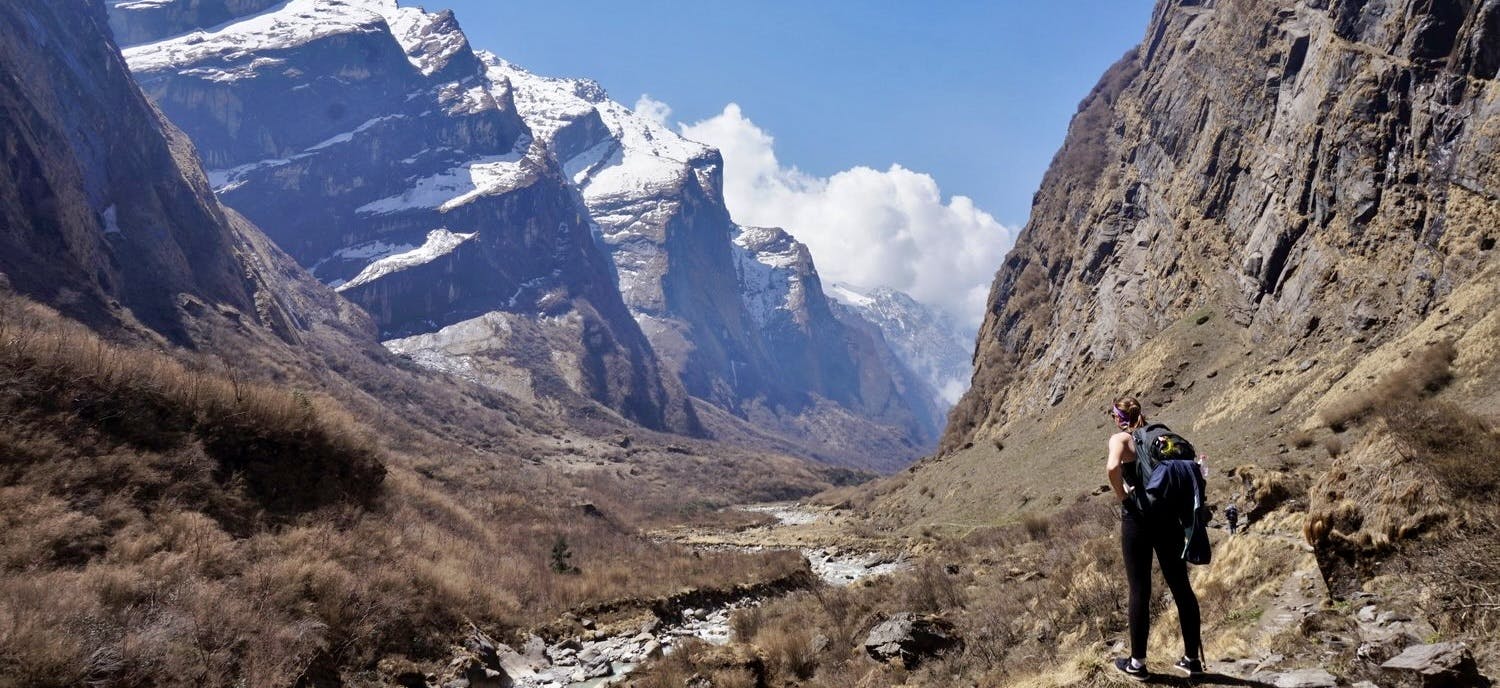
Nestled amidst the towering peaks of the Himalayas, Nepal has long been a coveted destination for travelers from across the globe. Famous for its picturesque landscapes, diverse culture, ancient heritage, and thrilling Everest expedition, Nepal offers experiences that are unmatched and unforgettable. However, one common question lingers in the minds of those planning a visit: "How much does it cost to visit Nepal?" The budget of your Nepalese adventure can vary significantly based on factors such as your lifestyle, preferences, and the activities you want to indulge in. In this comprehensive guide, we aim to break down the various costs you'll need to account for when planning your journey, from accommodations and meals to transportation and sightseeing. Whether you're a backpacker looking for a cost-effective trip or a luxury traveler ready to indulge, we've got you covered. Let's delve into the exciting yet economical world of exploring Nepal.
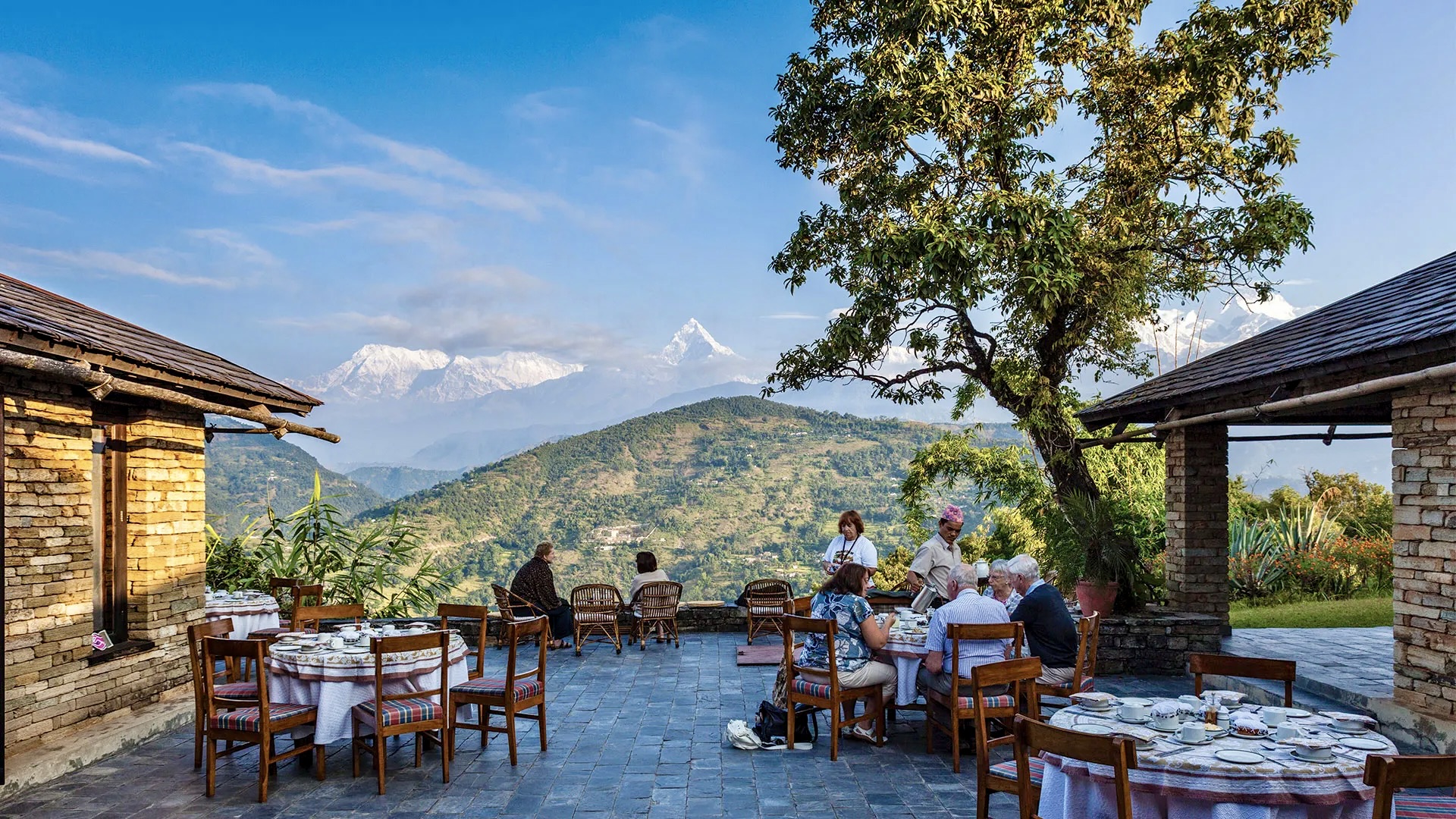
Currency and General Living Costs in Nepal
The official currency of Nepal is the Nepalese Rupee (NPR) , and at the time of writing in 2023, the exchange rate is approximately 120 NPR to 1 USD. However, exchange rates are subject to fluctuation, so it's always a good idea to check for the most current rate before your trip.
When it comes to general living costs, Nepal offers a highly cost-effective experience compared to many Western countries. Daily expenses such as meals, local transportation, and groceries are quite affordable, making Nepal an excellent choice for travelers on a budget. Here's a closer look at the breakdown:
Groceries: Local markets in Nepal are a great place to save money. A week's worth of groceries can range between 2,000-3,000 NPR ($16-$25) depending on your dietary needs.
Eating Out: A meal at an inexpensive restaurant can cost between 250-500 NPR ($2-$4), while a three-course meal at a mid-range restaurant might set you back about 1,000-2,000 NPR ($8-$17).
Local Transport: Public transportation is incredibly cheap. A one-way local bus ticket costs about 20-30 NPR ($0.17-$0.25), while a short taxi ride within the city might range from 200-500 NPR ($1.5-$4).
Utilities: If you plan to stay for a longer period, utilities like water, electricity, and internet for a month can cost about 3,000-6,000 NPR ($25-$50).
Leisure Activities: Gym memberships, movie tickets, and similar leisure activities are also quite affordable, usually ranging from 500-1,500 NPR ($4-$12.5).
Clothing and Personal Items: Clothing and personal items are relatively cheap. A pair of jeans can be found for 2,000-4,000 NPR ($16-$33), and a good pair of running shoes will cost about 3,000-6,000 NPR ($25-$50).
Of course, your mileage may vary depending on your lifestyle and spending habits, but generally speaking, living costs in Nepal are low, especially when compared to Western standards. The affordability of day-to-day life in Nepal makes it an ideal destination for budget travelers, while those with a higher budget will find they can live very comfortably.
Accommodation in Nepal
Accommodation in Nepal caters to a wide range of budgets, from the cost-conscious backpacker to the luxury-seeking traveler. The type, location, and level of service of the accommodation largely determine the price, with options ranging from shared dormitory-style rooms to lavish 5-star hotels.
Hostels: For budget travelers, hostels are a cost-effective option, offering an opportunity to meet fellow travelers while saving money. You can expect to pay anywhere between 700-1,200 NPR ($6-$10) per night for a bed in a shared dormitory in cities like Kathmandu and Pokhara. Some hostels also offer private rooms at a slightly higher cost.
Budget Hotels: These hotels offer private rooms with basic amenities such as Wi-Fi, and en-suite bathrooms, and often include breakfast. Prices usually range from 1,500-3,000 NPR ($12.5-$25) per night.
Mid-range Hotels: If you're looking for a bit more comfort and service, mid-range hotels might be your go-to choice. They often provide more spacious rooms, air conditioning, and better customer service. Expect to pay around 3,000-6,000 NPR ($25-$50) per night.
Luxury Hotels and Resorts: These are the most expensive options but offer high-quality service, comfort, and typically, stunning views. Luxury accommodation often features amenities such as spas, gyms, and high-end restaurants. Prices usually start at 15,000 NPR ($125) per night and can go much higher depending on the hotel and room type.
Homestays and Guesthouses: Particularly in rural areas and along popular trekking routes, homestays and guesthouses can provide a more authentic and personal experience. Prices range from 1,000-3,000 NPR ($8-$25) per night, often including meals.
Airbnb: If you prefer a home-like setting, Airbnb rentals are also available across Nepal. Prices can vary greatly depending on the property, but you can find options starting from around 1,500 NPR ($12.5) per night.
Remember, prices can fluctuate based on the season, with costs often increasing during the peak tourist seasons (March-May and September-November). Booking in advance can secure better prices and ensure availability, especially during these busy periods.
Food and Drink in Nepal
Part of the charm of visiting Nepal lies in sampling its delectable cuisine, which is as diverse as the country's landscapes. The cost of food and drink in Nepal can vary, but it is generally quite affordable.
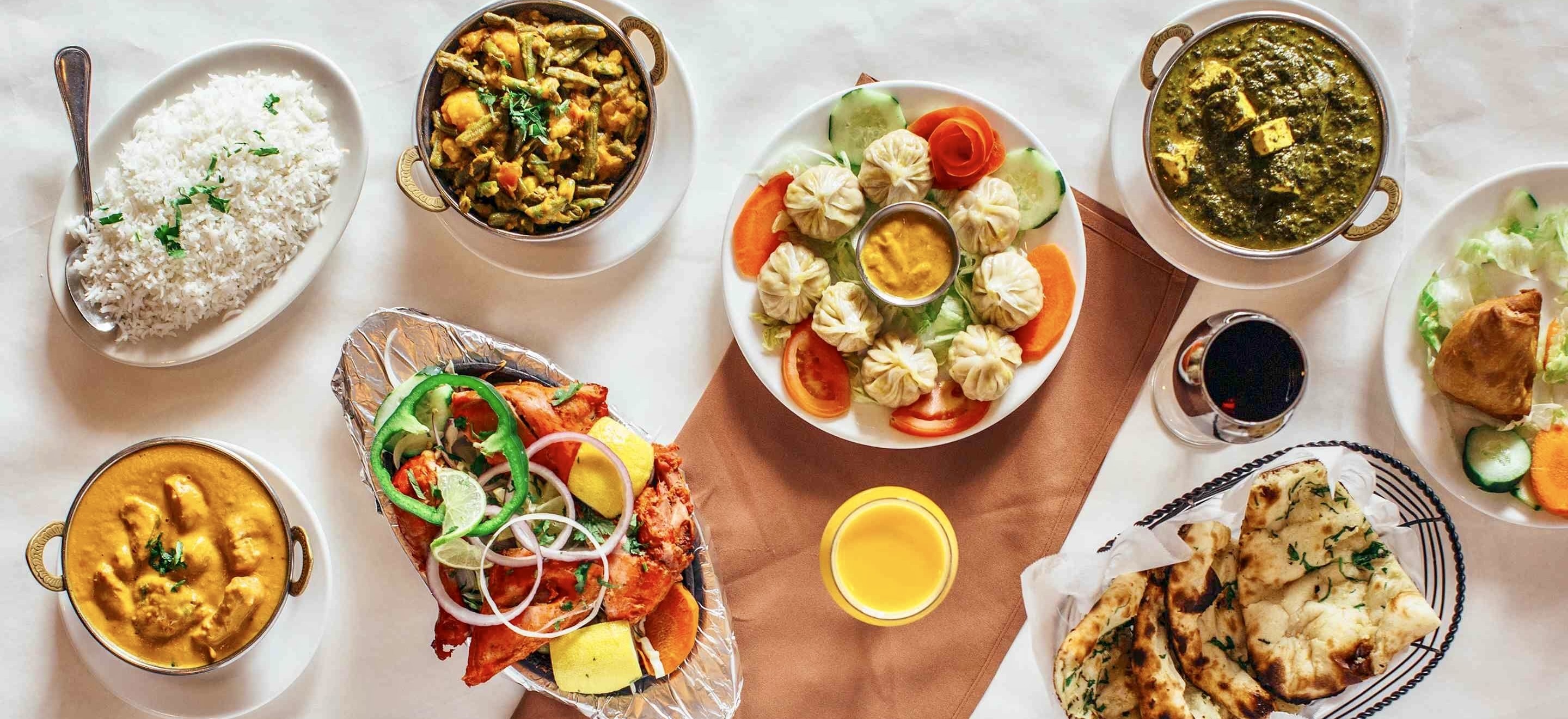
Here's a quick guide to what you can expect:
Street Food: Street food in Nepal is not just a budget-friendly choice, but it also offers an authentic taste of local flavors. Popular street foods such as momos (Nepali dumplings), samosas, or a hearty plate of dal bhat (a traditional meal of lentils, rice, and vegetables) can cost anywhere between 200-400 NPR ($1.5-$3.5).
Casual Dining: A meal at a local restaurant will cost around 500-1,000 NPR ($4-$8). Here, you can enjoy a variety of dishes, including different regional thalis (set meals), curries, or Tibetan-influenced dishes like thukpa (noodle soup).
Mid-Range Restaurants: For those seeking a more formal dining experience, a meal at a mid-range restaurant will cost approximately 1,000-2,000 NPR ($8-$17) per person. These establishments typically offer a blend of Nepalese, Indian, and often, Western cuisines.
High-End Restaurants: High-end restaurants, particularly those in upscale hotels, can charge up to 3,000-5,000 NPR ($25-$42) or more per person. These restaurants provide a range of international cuisines and are perfect for special occasions or if you want to treat yourself.
Drinks: Prices for drinks will depend on what you order. A cup of local tea (chiya) might cost around 20-50 NPR ($0.17-$0.42), while a local beer (like Gorkha or Everest) can be 300-500 NPR ($2.5-$4) in a restaurant. A bottle of water usually costs around 20-30 NPR ($0.17-$0.25), but it's a more sustainable choice to treat tap water or refill a reusable bottle at one of the many water refill stations.
Snacks: Nepalese snacks such as sel roti (rice doughnut), chatamari (rice crepe), or sweets are not only delicious but also easy on the pocket. Expect to pay around 50-100 NPR ($0.42-$0.83) per snack.
Eating and drinking in Nepal can be quite affordable, especially if you opt for local foods and eateries. That said, travelers should always prioritize food safety – stick to places that look clean, and always ensure your food is piping hot to avoid any potential stomach upsets.
Transportation in Nepal
Getting around in Nepal is relatively cheap, with several options available to suit different budgets and comfort levels. Here's what you can expect when it comes to transportation costs in Nepal:
Local Buses: Local buses are the cheapest mode of transportation within cities like Kathmandu and Pokhara. A one-way trip typically costs around 20-50 NPR ($0.16-$0.42). However, they can be crowded and might not offer the most comfortable ride.
Taxis: Taxis are more comfortable and faster than buses. Short taxi rides within cities generally cost around 200-500 NPR ($1.5-$4), but prices can be negotiated. It's best to agree on a fare with the driver before the ride to avoid overcharging.
Long-Distance Buses: For intercity travel, long-distance buses are the most cost-effective option. A bus ride from Kathmandu to Pokhara, for example, can cost between 500-1,200 NPR ($4-$10), depending on the level of comfort you choose. Deluxe buses with air conditioning, ample legroom, and sometimes even WiFi are available at the higher end of this price range.
Domestic Flights: If you want to save time, domestic flights are available, but they are significantly more expensive. A one-way flight from Kathmandu to Pokhara might cost around 8,000-12,000 NPR ($66-$100). Flying is also the only practical way to reach more remote regions like Lukla, the gateway to Everest Base Camp.
Car Rentals: Renting a car can be a convenient option, especially if you're traveling in a group. Car rentals start around 5,000 NPR ($42) per day but keep in mind that you will also need to budget for fuel, which costs about 100-110 NPR ($0.83-$0.92) per liter.
Rideshares: In major cities, ride-hailing services like Pathao and Tootle offer an alternative to traditional taxis. These rides are often cheaper and can be booked and paid for through a smartphone app.
Bicycles and Motorbikes: Renting a bicycle for a day costs around 500-800 NPR ($4-$7). For longer distances, a motorbike might be a better option, with daily rentals starting at around 700-1,000 NPR ($6-$8) per day, excluding fuel.
Remember, traffic in Nepal, particularly in Kathmandu, can be chaotic, and the condition of rural roads can be poor, particularly during the monsoon season. Whether you're taking a taxi or renting a vehicle, always prioritize safety over cost.
Trekking Expenses in Nepal
Nepal is a paradise for trekkers, offering a variety of treks suitable for all fitness levels. From the world-famous Everest Base Camp trek to the less-trodden trails of the Annapurna Circuit, trekking in Nepal is an experience of a lifetime. However, these adventures do come with associated costs.
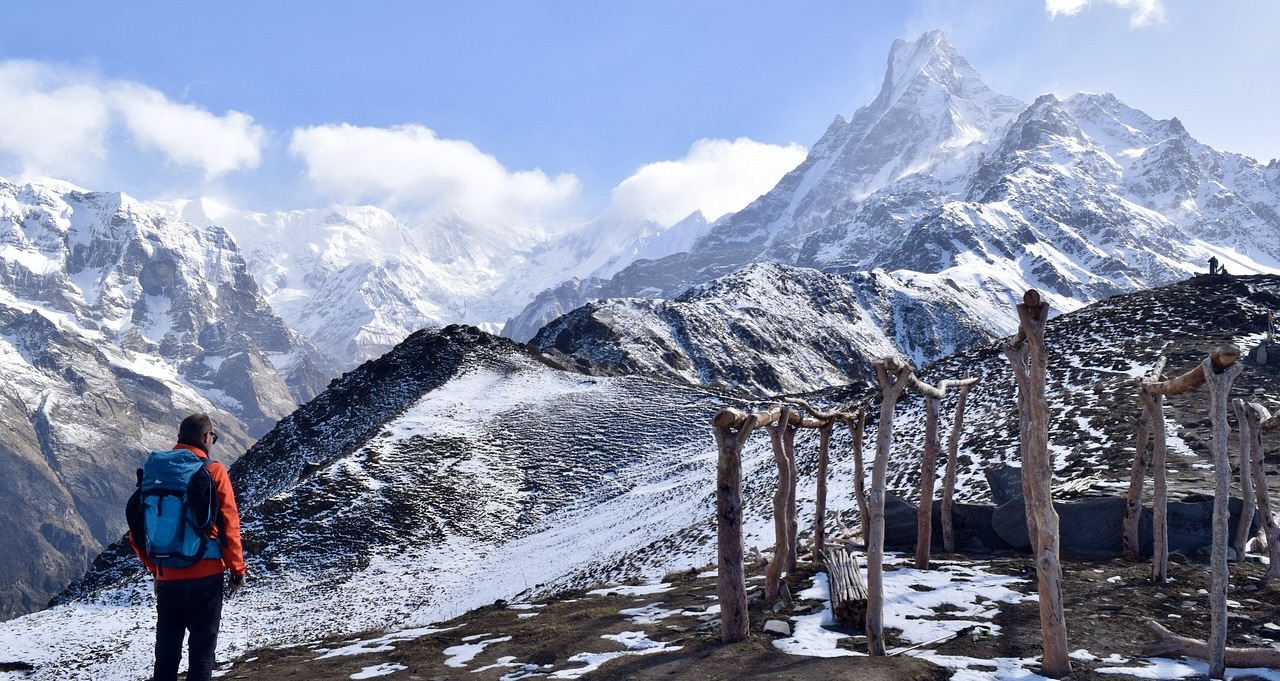
Here's what you can expect:
Trekking Permits: Most treks in Nepal require permits, the cost of which varies depending on the trek. For instance, the TIMS (Trekkers' Information Management System) card, which is mandatory for most treks, costs 2,000 NPR ($16.67) for individual trekkers and 1,000 NPR ($8.33) for those in groups. The Annapurna Conservation Area Permit (ACAP) and the Sagarmatha National Park Entry Permit (for the Everest region) each cost 3,000 NPR ($25). Always check which permits are required for your chosen trek.
Guides and Porters: While many treks can be done independently, hiring a guide or a porter can make your trek safer and more enjoyable. A guide can cost around 2,500-4,000 NPR ($20-$33) per day, while a porter (who carries your heavy gear) will cost about 2,000-2,500 NPR ($16-$20) per day.
Accommodation and Meals: Most trekking routes offer teahouse accommodation, which are basic lodges providing meals and a bed. Prices depend on the altitude and popularity of the route but generally range from 500-1,500 NPR ($4-$12.5) per night. Meals on the trek cost around 500-1,000 NPR ($4-$8), but this can rise with the altitude as goods become harder to transport.
Gear: If you don't already have trekking gear, you will need to factor this into your budget. Essential items include hiking boots, warm clothing, a backpack, a sleeping bag, and a water purification system. Many of these can be rented or bought in Kathmandu or Pokhara. Costs vary greatly, but for a basic set of new gear, expect to pay upwards of 20,000 NPR ($166).
Travel Insurance: Never trek without travel insurance that covers emergency evacuation. Costs vary based on your home country, age, and the length of your trip, but typically you should budget at least $100 for a month's coverage.
Miscellaneous Expenses: These include costs for snacks, drinks, charging electronic devices, hot showers, and Wi-Fi, which are usually extra in teahouses. Set aside around 1,000 NPR ($8) per day for these.
Remember, trekking in Nepal isn't about luxury—it's about the incredible landscapes, the sense of adventure, and the friendly local culture. It's also essential to ensure you're adequately prepared and equipped for the challenge, so always factor in all potential costs when planning your trek.
Sightseeing and Activities in Nepal
From exploring World Heritage Sites to engaging in adrenaline-pumping activities, Nepal offers a plethora of options for sightseeing and entertainment. The costs of these activities vary depending on the nature of the activity, location, and service providers.
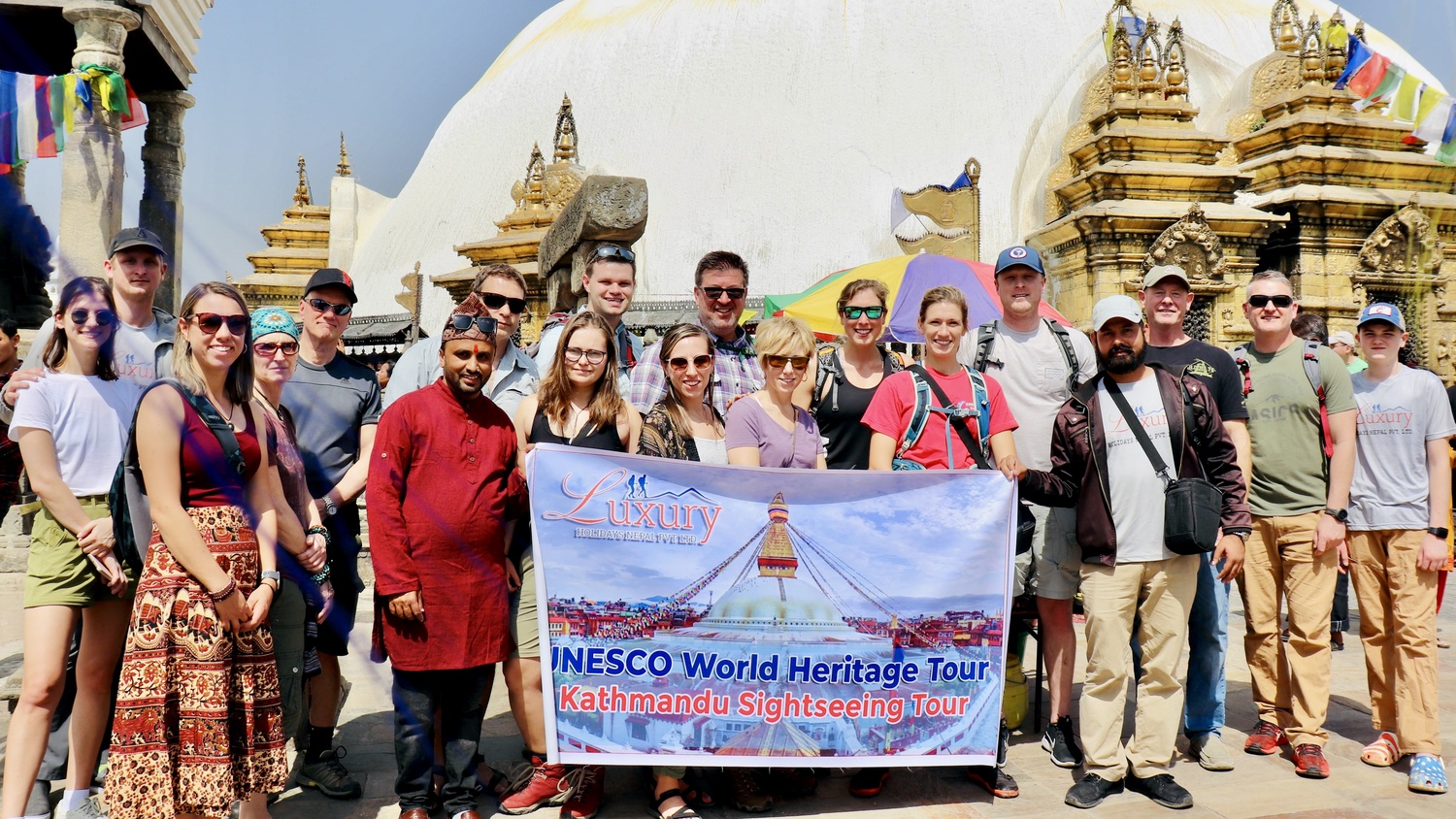
Here's a quick overview:
Cultural Sites: Nepal is home to numerous UNESCO World Heritage Sites, most notably the Kathmandu Durbar Square, Patan Durbar Square, Bhaktapur Durbar Square, and the sacred Boudhanath Stupa. Entrance fees range from 500-1,500 NPR ($4-$12.5) per site.
Museums: Museums like the National Museum of Nepal, The Taragaon Museum, or the Patan Museum charge an entrance fee ranging between 100-1,000 NPR ($0.83-$8.33).
Adventure Activities: Nepal is famous for its adventure activities like white-water rafting, bungee jumping, paragliding, and zip-lining. These activities cost anywhere from 5,000 to 15,000 NPR ($42-$125), including transportation and safety equipment.
Wildlife Safari: A visit to Chitwan National Park or Bardia National Park for a wildlife safari can be a memorable experience. A safari package typically costs between 10,000-25,000 NPR ($83-$208) for a few days, including accommodation, meals, and various jungle activities.
Yoga and Meditation Retreats: Nepal, particularly Pokhara and Kathmandu, offers a wide range of yoga and meditation retreats. A week-long retreat can cost anywhere from 30,000-70,000 NPR ($250-$583), including accommodation, meals, and classes.
Cooking Classes: Participating in a Nepalese cooking class can be a fun and immersive cultural experience. Classes usually cost around 2,500-4,000 NPR ($20-$33) and include the meal you've helped prepare.
Remember, the cost of these activities can often be negotiated, and discounts may be available for students or groups. Make sure to check the most up-to-date prices, as these can vary from year to year.
Whatever your interests, it's likely you'll find activities in Nepal that will provide you with rich experiences and incredible memories without breaking the bank.
Total Estimated Costs for a Trip to Nepal
Calculating the total cost of a trip to Nepal can be quite variable, depending on your travel style, the duration of your stay, and the activities you wish to do. However, here's a rough breakdown of costs for a two-week trip:
Flights: A round-trip flight to Nepal will depend largely on where you're flying from and the time of year you're visiting. On average, you might expect to pay between $500-$1,200.
Accommodation: For a two-week stay, a budget traveler staying in hostels could expect to pay between 9,800-16,800 NPR ($82-$140). Mid-range accommodation could cost 42,000-84,000 NPR ($350-$700), while luxury hotels could reach 210,000 NPR ($1,750) or more.
Food and Drink: If you eat at local restaurants or street food stalls, you can expect to pay around 14,000-28,000 NPR ($116-$233) for two weeks. If you opt for more mid-range or high-end restaurants, this could increase to between 28,000-70,000 NPR ($233-$583).
Transportation: For local and intercity travel over two weeks, budget around 2,000-5,000 NPR ($16-$42) for local buses and taxis. If you plan on renting a car or taking domestic flights, this could rise to 10,000-60,000 NPR ($83-$500).
Trekking Expenses: A typical 12-day Everest Base Camp Trek can cost between 30,000-60,000 NPR ($250-$500) for permits, guides, porters, accommodation, and meals.
Sightseeing and Activities: Depending on your interests, allocate between 5,000-40,000 NPR ($42-$333) for entrance fees to cultural sites, adventure activities, or experiences like cooking classes and yoga retreats.
Miscellaneous: An additional 10-15% of your budget should be set aside for miscellaneous expenses like souvenirs, tips, and unexpected costs.
In total, a budget traveler could expect to spend around 60,800-140,800 NPR ($507-$1,173) for two weeks in Nepal, not including flights. A mid-range traveler might spend between 135,000-310,000 NPR ($1,125-$2,583), while a luxury trip could cost 300,000 NPR ($2,500) or more, excluding flights.
These are rough estimates and actual costs can vary. It's always advisable to do thorough research and planning in advance to ensure your budget aligns with your travel preferences and needs.
Visiting Nepal is a truly remarkable experience that offers a rich blend of natural beauty, ancient culture, and adventure. While the cost of a trip can vary greatly depending on personal preferences and activities, it's possible to have a fulfilling journey on nearly any budget. From budget-conscious backpackers to those seeking luxury, there are options to suit everyone.
Remember, the true value of a trip to Nepal is not in the money spent but in the experiences gained. From trekking through the breathtaking Himalayas, exploring age-old temples and stupas, and tasting delicious local cuisine, to meeting the warm and welcoming Nepalese people, the memories you'll make in Nepal are truly priceless.
Despite its affordability, it's important to remember that tourism plays a significant role in Nepal's economy. When planning your budget, consider how you can travel responsibly and support local businesses to contribute positively to the communities you visit. With careful planning and a spirit of adventure, a trip to Nepal can be both affordable and profoundly rewarding.
Frequently Asked Questions for Visiting Nepal
Q: is nepal an expensive country to visit.
A: No, compared to many tourist destinations around the world, Nepal is relatively inexpensive. The cost of living in Nepal is low, which translates to cheaper food, accommodations, and transportation for tourists.
Q: How much does a meal cost in Nepal?
A: A meal in a local restaurant can cost around 200-500 NPR ($1.67-$4.17). Western-style meals in tourist areas are more expensive but still affordable, ranging from 500-1,000 NPR ($4.17-$8.33).
Q: What is the average cost of a hotel in Nepal?
A: Budget guesthouses and hostels can cost as low as 700-1,200 NPR ($5.83-$10) per night, while mid-range hotels usually charge 3,000-,000 NPR ($25-$50) per night. Luxury hotels and resorts can cost over 15,000 NPR ($125) per night.
Q: How much money should I budget for trekking in Nepal?
A: Trekking costs depend on several factors like the length of the trek, hiring a guide or porter, and the trek's popularity. Generally, a budget between 30,000-60,000 NPR ($250-$500) for a typical 12-day Everest Base Camp Trek.
Q: Do I need travel insurance for Nepal?
A: Yes, it is highly recommended to have travel insurance that covers medical evacuation and high-altitude trekking if you plan to do so. The cost varies based on your home country, age, and length of coverage.
Q: What is the best time to visit Nepal?
A: The best time to visit Nepal is in the spring (March-May) and the fall (September-November) when the weather is most favorable. The skies are generally clear, offering stunning views of the mountains.
Q: Can I use credit cards in Nepal?
A: Credit cards are accepted in most hotels, restaurants, and shops in larger cities like Kathmandu and Pokhara. However, cash is king in many places, especially in more rural areas and during treks.
Q: Is it safe to travel to Nepal?
A: Nepal is generally safe for travelers. However, like anywhere else, tourists should take regular precautions against theft and be aware of their surroundings. For trekkers, it is advised to stay updated on weather conditions and avoid risky paths.
Q: Are ATMs easily accessible in Nepal?
A: ATMs are common in larger cities like Kathmandu and Pokhara, but they may be harder to find in more remote or rural areas. Always have enough cash on hand to cover your needs when leaving urban areas.
If you need any further information, please contact us by email: at [email protected] , Phone: at +977- 985 100 5129 ( WhatsApp )
- Nepal travel budget
- Nepal travel costs
- Accommodation prices in Nepal
- Trekking expenses in Nepal
- Budget travel in Nepal
- Nepal visa fees
- Hidden Waterfalls around Kathmandu
- 10 Best Everest Region Trek Packages
Drop us a message

Mr. Shishir Banjara
Shishir Banjara is the founder of Luxury Holidays Nepal Pvt Ltd, a renowned luxury travel company, and also a highly esteemed professional blogger with a deep passion for exploring and promoting the beauty of Nepal. Having embarked on countless journeys throughout the country, Shishir has gained a wealth of firsthand knowledge and experiences that have shaped his understanding of Nepal's diverse landscapes, cultural heritage, and hidden gems. His extensive travels have taken him to remote villages, vibrant cities, majestic mountains, and tranquil valleys, allowing him to develop a profound insight into the intricacies and charms of Nepal. Through his blog, he shares captivating stories, insider tips, and breathtaking photographs, inspiring fellow adventurers and curious travelers to embark on their own remarkable journeys and discover the wonders that Nepal has to offer.
Blog by Categories
- Travel Informations 168
- Health & Fitness
- Gold & Silver Price in Nepal
- Preeti to Unicode Converter
- Unicode to Preeti Converter
- Nepali Rashifal Horoscope 2080 / 2023
- Nepali Calendar 2080
- Nepali Panchang Patro With Tithi
- Nepali To English Date Converter – BS to AD – Age – Date of Birth
- English To Nepali Date – AD to BS | Age | Date of Birth
- Forex Exchange

Budget Travel in Nepal: How to Plan an Affordable trip
Nepal, often the fabled paradise for backpackers and travellers, is among Asia’s most budget-friendly countries to explore nature spree and culture. One can participate in many activities without worrying too much about the dent it will leave in your pocket.
Offering a wide range of inexpensive accommodations, public transport and low international standards entrée fees, Nepal is a sound budget destination with a perfectly knitted system offering fairly priced activities and experiences.
With its ties and tranquil relationship with international courtships, one can quickly receive a visa on arrival and travel in this dirt-cheap country without any objections or obstruction.
Revered as the country of mountains, Nepal offers one of the most incredible adventures with numerous activities, including Rafting, Trekking, mountaineering, wildlife, meditation retreats and cultural amalgamation, indeed to induce a dopamine rush.
Cost of Travelling in Nepal
Hey! Are you planning a trip to Nepal but are wondering how much money you will require? Well, the actual cost of travel to Nepal, like any other nation, depends upon the length of stay, choice and preferences and the level of comfort you desire.
However, planning a budget-friendly trip to Nepal might be surprising as you uncover the price and cost of essential elements in Nepal.
According to statistical data, an average tourist spends around NPR1000 (7.55 USD) for a day’s meal and around NPR 1,200 ($12 USD) on transportation. The basic accommodation charge for a couple in Nepal is around NPR 3,000 ($22.67 USD). To summarise, a two-person trip to Nepal for a week will cost about NPR60,000 ($ 500 USD).
A realistic day budget for a backpacker in Nepal lies around $25 per person if you travel by public transport, eat at local restaurants and sleep in guesthouses/teahouses. If you are going for a hike or trek, packing light and independent venture is the best option in saving up costs excluding guide and porter charges.
Budget Travel Planning
Planning a budget-friendly trip to Nepal can seem daunting, but with the right approach, it’s possible to have an incredible adventure without breaking the bank. Here are some essential steps to follow when planning your affordable trip to Nepal:
Step 1: Destination Research
The first step in planning a trip is to research your destination thoroughly. Start by learning about Nepal’s history, culture, and attractions. Some of Nepal’s top places to visit include Kathmandu, Pokhara, and Chitwan national park.
Researching online travel guides, blogs, and forums can serve a good idea of what to expect and help you narrow down the options.
Step 2: Itinerary Planning
Once you have an idea of what you want to see and do in Nepal, it’s time to start planning your itinerary. Consider the length of your trip and the logistics of getting from place to place.
You might want to consider taking public transportation or hiring a driver to save money on transportation costs. It’s also good to plan your itinerary around the off-season to save money on accommodations and activities.
Step 3: Budgeting
Budgeting is essential to any travel planning process, especially when planning a budget-friendly trip. Start by creating a list of all your expenses, including transportation, accommodation, food and activities.
Consider setting a daily spending limit and sticking to it to ensure you don’t overspend. It’s also a good idea to research ways to save money, such as using local transportation or eating at local restaurants.
Practical Tips for discovering Affordable flights and Accommodation in Nepal
Finding affordable flights and accommodation is vital to planning a budget-friendly trip in Nepal. With the right strategies and initiatives, you can save significant money without sacrificing comfort or quality. Here are some practical tips to help your budget-friendly trip to Nepal.
1. Be flexible with your travel dates
Flexibility is the key to finding the cheapest flights and accommodations. Try to avoid travelling during peak season or holidays when prices are at their highest.
Instead, consider travelling during the off-season or shoulder season when prices are lower. Use flexible date search tools on flight booking websites to find the cheapest options for your trip.
2. Use flight comparison websites
Flight comparison websites like Skyscanner and Kayak can help you find the cheapest flights for your trip. These websites allow you to compare prices across different airlines and find the best deals. Sign up for email alerts or use their price alert feature to stay updated on any price drops or deals.
3. Book accommodation in advance
Booking your accommodation in advance can help you save money and ensure that you have a comfortable place to stay.
Look for accommodation options that offer free cancellation in case your plans change. Websites like Booking.com and Agoda offer a wide range of accommodation options and often have special deals and discounts.
4. Consider hostels, homestays, and guesthouses
Hostels, homestays, and guesthouses are affordable accommodation options that can help you save money while experiencing local culture. Hostels are a popular choice for backpackers and solo travellers, offering shared dormitory rooms or private rooms at a lower cost.
Homestays and guesthouses allow you to stay with local families or in local homes, providing a unique cultural experience.
5. Use loyalty programs and travel credit cards
Loyalty programs and travel credit cards can help you save money on flights and accommodations. Sign up for airline loyalty programs and accumulate points or miles that can be redeemed for free flights or upgrades. Travel credit cards often offer sign-up bonuses, reward points, and discounts on travel-related expenses.
Budget-Friendly Activities
Nepal is a country rich in culture, history, and natural beauty. While it’s easy to spend a lot of money on activities and tours, there are also plenty of affordable and free things to do in Nepal. Here are some budget-friendly activities to consider on your trip to Nepal:

Nepal is home to some of the world’s most spectacular hiking trails, including the famous Everest Base Camp Trek. While these treks can be expensive, plenty of shorter and less crowded hikes are more affordable.
For example, the Shivapuri Nagarjun National Park near Kathmandu offers several hiking trails that provide stunning views of the city and surrounding mountains.
2.Visiting Temples and historical sites
Nepal is home to many temples and historical sites that offer a glimpse into the country’s rich culture and history. Many of these sites are free to visit, while others charge a small entrance fee.
Some famous temples and historical sites to visit include Swayambhunath Stupa (also known as the Monkey Temple), Pashupatinath Temple, and the Durbar Squares in Kathmandu, Bhaktapur and Patan.
3.Experiencing Local culture
One of the best things about Nepal is its vibrant and welcoming culture. There are many ways to experience local culture on a budget, such as attending a traditional dance performance, visiting a local market, or trying local street food.
You can also see a local monastery or meditation centre to learn more about Buddhism and mindfulness practices.
4.Exploring Nature
Nepal is a homage to natural beauty, and there are many ways to explore nature on a budget. For example, you can visit the Garden of Dreams in Kathmandu, which is a peaceful oasis in the middle of the city. You can also take a walk along the Bagmati River or visit the Phewa Lake in Pokhara.
5.Volunteer work
Volunteering is a great way to give back to the community and immerse yourself in local culture. Many volunteer opportunities are available in Nepal, such as teaching English, working in a community centre, or volunteering with a conservation project.
How to Find Affordable Adventure Activities in Nepal
The land is renowned for its stunning natural beauty and adventurous activities, such as trekking and rafting. However, these activities can be expensive, making it challenging for budget travellers to enjoy them. But fear not, here are some suggestions for finding affordable adventure activities in Nepal:
1. Research local tour companies
Do some research on local tour companies that offer adventure activities in Nepal. Look for companies that have good reviews and offer competitive prices. Be sure to check the company’s safety record and credentials before booking any activities.
2. Join a group tour
Joining a group tour can be a more affordable way to enjoy adventure activities in Nepal. Group tours often offer discounts on activities, and you’ll also have the opportunity to meet other travellers and share the cost of transportation and accommodations.
3. Book activities in advance
Booking adventure activities in advance can often result in lower prices. Research and compare prices from different tour companies and book early to take advantage of early bird discounts.
4. Travel during the off-season
Travelling during the off-season can also result in lower prices for adventure activities. The off-season in Nepal is from June to September and December to February. During this time, tour companies often offer discounts to attract visitors.
5. Consider Budget-friendly alternatives
If trekking and rafting are beyond your budget, consider budget-friendly alternatives.
For example, hiking in the surrounding hills and exploring local villages can be a great way to experience Nepal’s natural beauty and culture without worrying too much about the financial spectrum.
Safety Considerations
Travelling on a budget in Nepal can be an exciting and rewarding experience. However, it’s essential to be aware of the potential health risks and safety concerns that come along with budget travel. Here are a couple of safety recommendations to keep in mind when travelling on a budget in Nepal:
1. Health Risks
Nepal is known for its high altitude, which can pose health risks to travellers who are not used to it. Altitude sickness is a common problem, and it’s essential to acclimatize slowly and seek medical attention if you experience symptoms such as headache, nausea, or dizziness.
Additionally, food and water-borne illness can also be a concern in Nepal. Be sure to drink bottled water or water that has been treated with purification tablets. Avoid street food and stick to restaurants that have good reviews and appear clean.
2. Safety Precautions
While Nepal is generally a safe country for travellers, there are still some safety concerns to remember. Petty theft and scams can be a problem, especially in tourist areas.
Be aware of your surroundings and keep your belongings close to you. Avoid carrying large sums of cash or valuables with you.
It’s also important to be aware of the political situation in Nepal. Protests and strikes can occur, and it’s essential to avoid these areas and follow local news to stay informed.
3. Trekking Safety
Trekking is a prominent activity in Nepal, but it comes with a set of safety concerns. Be sure to hire a licensed guide and porter, who are knowledgeable about the terrain and can help in case of an emergency. Carry appropriate gear, including warm clothing, good hiking shoes, and a first-aid kit.
Finally, it’s important to respect local customs and traditions. Dress modestly, especially on religious sites, and ask for permission before taking photos of people or their homes.
Cultural Immersion on a Budget
Nepal offers unique cultural experiences as it is backed by a rich cultural heritage soundly appetizing travellers’ hunger. From exploring ancient temples to trying local cuisine, there is a plethora of immersions in Nepali culture, even on a budget.
Here are some look-outs on how to experience the cultural abundance and activities on a budget:
1. Visit Ancient Temples
Home to numerous ancient temples registered as UNESCO World Heritage sites , with a minimum donation or free entry, you can check out some aesthetically appealing environments and hereditary areas in Nepal.
Once you land in Kathmandu, home of temples , you will be welcomed by renowned Hindu and Buddhist temples such as Swayambhunath, Bouddha and Pashupatinath, carrying a unique charm of peace and peace harmony to your storming mind.
2. Attend Festivals and Celebrations
Nepal celebrates numerous festivals throughout the year, and attending these events is a great way to experience the local culture.
Most festivals are free to attend, and you can participate in dances, watch parades, and try traditional foods. Some popular Festivals include Dashain, Tihar, and Holi.
3. Try Local Cuisine
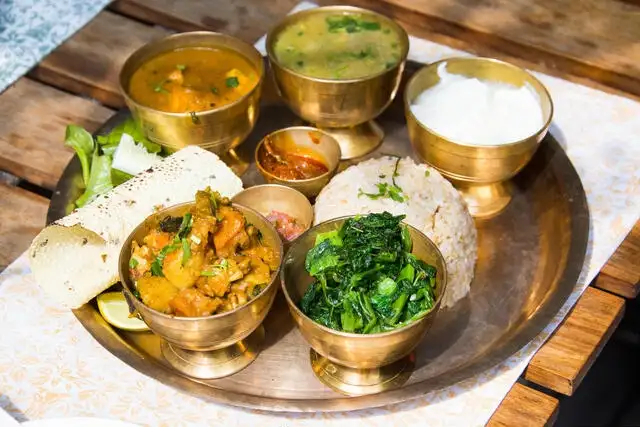
Nepal’s unique cuisine evolved with a blend of Indian, Tibetan and Chinese flavours. You can try out local street food, such as momos (dumplings), chatamari (rice flour crepes), and samosas, which are cheap. Alternatively, you can visit local restaurants that offer traditional Nepali meals for an affordable price.
4. Explore Local Villages
Exploring local villages is a great way to experience Nepal’s traditional way of life. You can visit traditional houses, observe daily activities, and learn about local customs and traditions. You can hire a local guide or visit a homestay to learn more about the culture and everyday life of Nepali people.
5. Learn Traditional Crafts
Nepal is known for its traditional crafts, such as pottery, weaving, and painting. You can visit local workshops and learn about these crafts from local artisans, who are happy to share their knowledge with visitors. You can also purchase handmade souvenirs at a reasonable price.
A Guide for Budget Travelers to Nepal
Nepal welcomes a massive number of backpacking tourists as it is a popular destination among adventure lovers.
Home to Mount Everest, the tallest mountain in the world, Nepal is a landlocked nation neighbouring India, China, Bhutan and Bangladesh, offering a blend of social, cultural and traditional influences.
In this article, we aim to assist you with tips for cutting your expenses when travelling around Nepal on a Budget.
1. Travel via India

There are only a few numbered direct flights to Nepal, as the only functioning international airport is Tribhuvan International in Kathmandu. The route to reach this land will have you take transits in the middle east or Asia.
Considering your budget preferences, these flights can be costly, so the cheapest option to fly is via a connecting flight after reaching Delhi.
If you are looking for even greater savings, taking an overland trip from India via express buses is the best available option for your tight budget.
2. Bargain and Negotiate for Discount
In Nepal, it is common for people to negotiate and haggle on the price and options in the market. You will find an incredible selection of budget accommodation options from hostels, homestays, lodges and bare-bone budget hotels.
As the room rates are predestined to fluctuate throughout various seasons, it is worth negotiating sizable discounts for extended stays, especially during the off-season period.
A friendly reminder; the mid-range and high-end places disincline the 23% service charges and taxes levied by the government. So these often dis-regarded factors can make a collusive difference in the reality and expectation of your budget plan.
3. Eat at Local Restaurants and Cafes
The major destination hubs such as Pokhara and Kathmandu are crawling with restaurants serving food to people worldwide. However, the prices are typically higher in these areas compared to crowded local regions.
Your cost of living will increase exponentially if you are on a tight budget, so we advise you to check out the local Bhojanalayas- simple joints that serve Nepali clientele.
Nepal significantly boasts of its exquisite and economical street food like momos, Thukpa, samosa, tea and Dal bhat (the staple food of Nepal).
4. Travelling to Nepal on Off Season
The peak season for an increase in Nepal’s flight, accommodation and tour costs lies in October – November , the best time for trekking in Nepal. Travel during the slightly lower season, mainly in March-April, is beneficial to your pocket, as the sky is clear and beautiful for wildlife viewing and trekking.
In addition, although under-rated, exploring the warmer lowland areas in the winter season can be a prolific way of saving even more money. Some of the fascinating places to visit during winter travel are Nagarkot, Annapurna Circuit, Poon Hill, Kakani, Bandipur, Kalinchowk and Mustang.
5. Public buses are the most economy-friendly way to travel.
Transportation and accessibility are important tourism elements as they involve people in reaching their destination. The most inexpensive and cost-cutting medium of travelling in Nepal is via public buses that run almost to all the corners and ends of Nepal.
With a well-implemented road infrastructure, you can save a substantial amount by taking a bus to reach your desired place. Although long journeys by bus can be tiresome and less comfortable compared to private vehicles or domestic flights, public buses are Nepal’s cheapest means of transport.
Cost cutting Tips in Nepal
Travelling in Nepal is quite budget -friendly when you are cautious and mindful of your expenses. The actual cost of journeying in Nepal entirely depends on the types and preferences you decide to head towards. Additionally, there are a few pointers you can direct in cutting some costs as you progress in your venture.
It is ingenious to tag alongside a friend since doubling up on accommodation is the best way to save some money. This way is also beneficial for family-run guesthouses and old lodges as it helps their business. Another clever way to save up some dough is buying a 5-gallon water jug instead of a 1-litre bottle, which is comparatively cheaper.
The ultimate way to travel and save some money is by buying Guidebooks to Nepal. Purchasing a guidebook is wise as you will get more insight into the area and tips for saving money at such a tiny investment.
Some books you should consider reading for a better outlook and introspection into Nepal are listed below.
Guide Books to Read About Nepal
- Nepal Guidebook – David Ways (2021)
- Lonely Planet Nepal 11 – Bradley Mayhew, Lindsay Brown and Paul Stiles (2018)
- Nepal Travel Guide – Patrick Gill (2018)
- A Trekking Guide to the Nepal Himalaya – Sian Pritchard-Jones and Bob Gibbons (2020)
- The Rough Guide to Nepal – Rough Guides (2018)
- Everest, The Hard Way – Christ Bonington (1977)
- A Trekking Guide to West Nepal – Sian Pritchard-Jones and Bob Gibbons (April 14, 2021)
- The Snow Leopard – Peter Matthiessen (2008)
- While the Gods Were Sleeping: A Journey through Love and Rebellion in Nepal – Elizabeth Enslin (2014)
- Tiger for Breakfast – Michel Peissel (1996)
- Kathmandu – Thomas Bell (2016)
- House of Snow – Ranulph Fiennes and Ed Douglas (2017)
In summary, there are several planning techniques and benefits of budget travel in Nepal. These include researching destinations, planning an itinerary, budgeting, finding affordable flights and accommodations, taking advantage of off-season discounts and local deals, and participating in budget-friendly cultural and adventure activities.
By travelling on a budget, you can save money without compromising the quality of your trip. You’ll have the opportunity to immerse yourself in Nepali culture and explore the country’s natural beauty while experiencing unique adventures.
However, it’s essential to remember responsible and sustainable tourism practices while travelling on a budget in Nepal. This includes respecting the local culture and environment, supporting local businesses, and minimizing your impact on the environment.
In conclusion, budget travel in Nepal can be an enriching experience. Planning your trip carefully and responsibly allows you to make the most of your budget while enjoying all these beautiful country offers. So, pack your bags, take the plunge and embark on a budget-friendly adventure of a lifetime.
- Budget Travel Nepal
Rastriya Parichaya Patra/National Identity Card Registration in Nepal
Nearby resorts in kathmandu, education consultancy in nepal for australia study, leave a reply cancel reply.
Log in to leave a comment
LATEST POST
Anubhav regmi-biography, age, father, height, school, mother, net worth, movies, deeya maskey-biography, age, birthday, husband, movie, tv show, height, sister, net worth, best hair salons in bhaktapur: a guide to hair salons in bhaktapur, nepal, for ladies and gents , top 10 best movies of nepal: a cinematic journey.
The best destination for your diverse searches on Nepal. Be it Technology, Traveling, History, Culture, or any other major queries, feel free to explore our blog section for exciting and latest information.
Contact us: [email protected]
© Copyright 2024 - Source Nepal
- DMCA Policy
- Advertisement
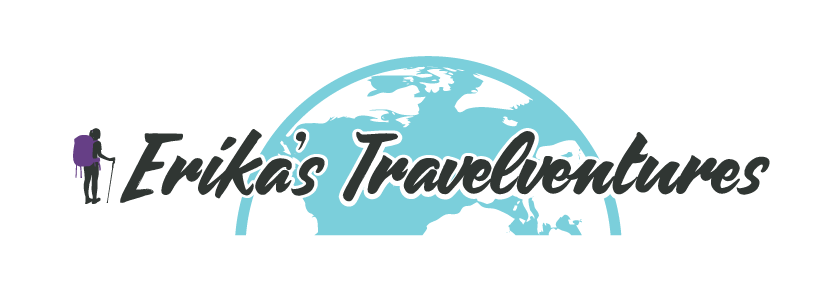
Nepal Backpacking Budget
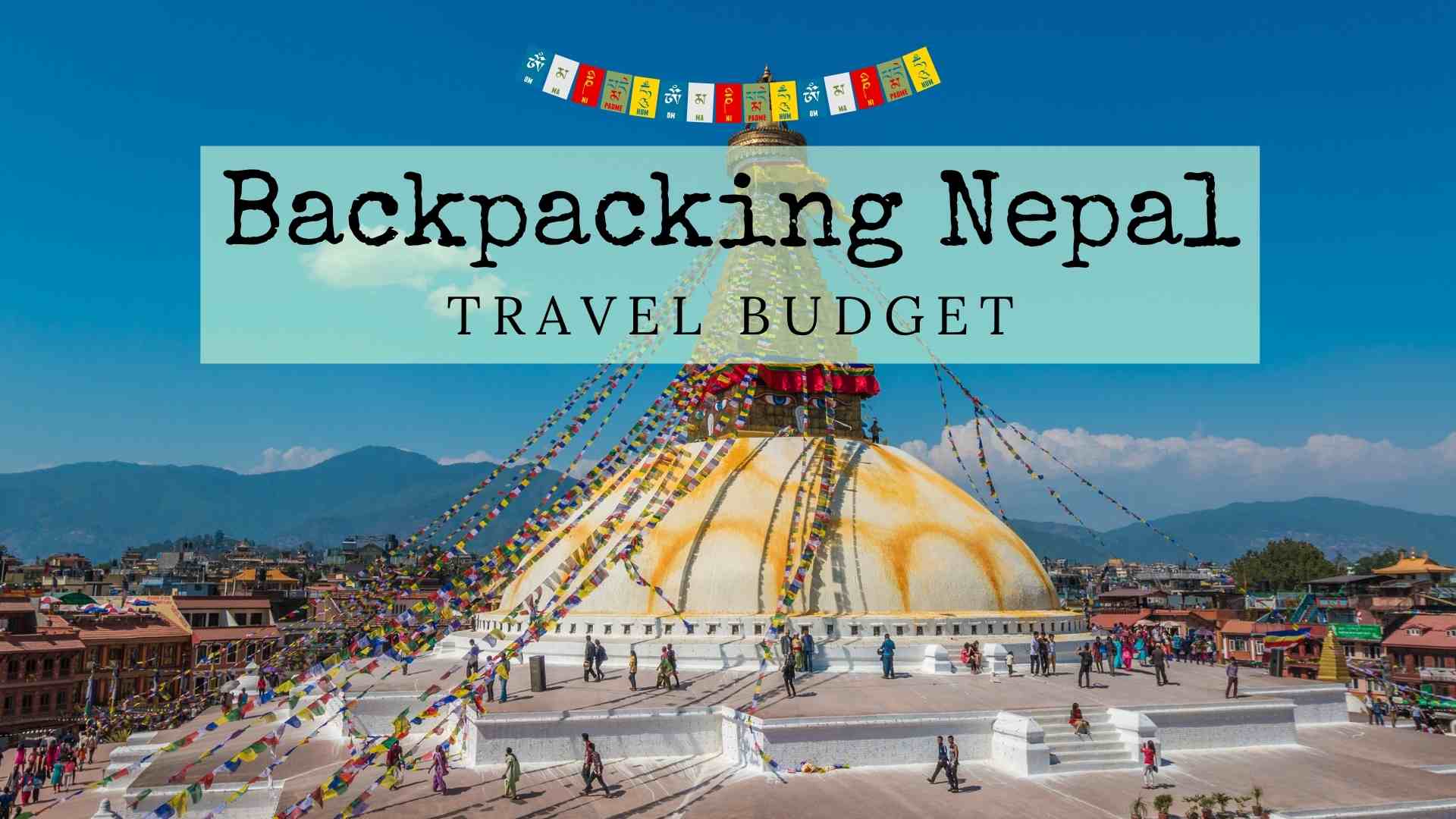
Budget travelers will rejoice at the cost of backpacking Nepal . You don’t even need to be on a shoestring budget to save some major coin while traveling this beautiful country. Out of the dozens of countries I’ve travelled to, the cost per day to backpack in Nepal was easily one of the lowest.
So how expensive is Nepal? About as cheap as it can get if you’re traveling on a budget. In this post I’ll outline a range of Nepal travel budgets , and breakdown the cost of travel in Nepal for backpackers.
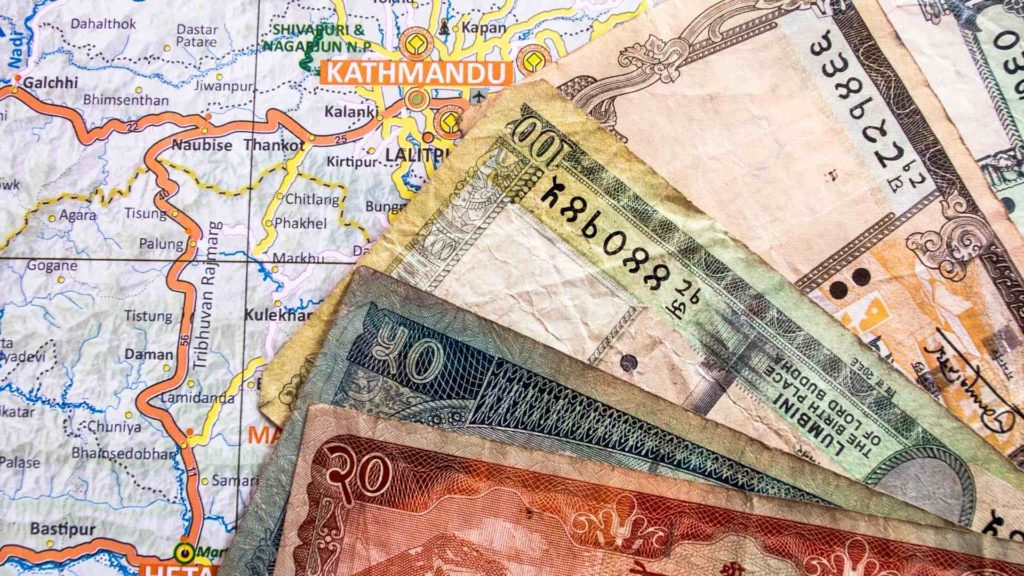
Here’s a quick example of a Nepal backpacking budget breakdown:
- Dorm room at Shantipur hostel (my favorite rooftop in Kathmandu!) – $2 USD per night ($5 for a private room)
- One Western-style breakfast at Shantipur’s in-house restaurant – $3 USD
- Two meals at hole-in-the-wall local Nepali restaurants (momo dumplings, anyone?) – $1 each, $2 USD total
- Exploring Thamel on foot, enjoying rooftop views of Kathmandu, charging electronics at the hostel – free!
Your daily Nepal backpacking budget for the above scenario is a whopping $7 USD per day ! Spending three weeks chilling in Kathmandu? That’s a budget of $147 USD for three weeks. Even rounding up the cost to $200 USD to include local sightseeing and transportation costs (maybe a few beers) shows just how inexpensive the cost of travel in Nepal really is.
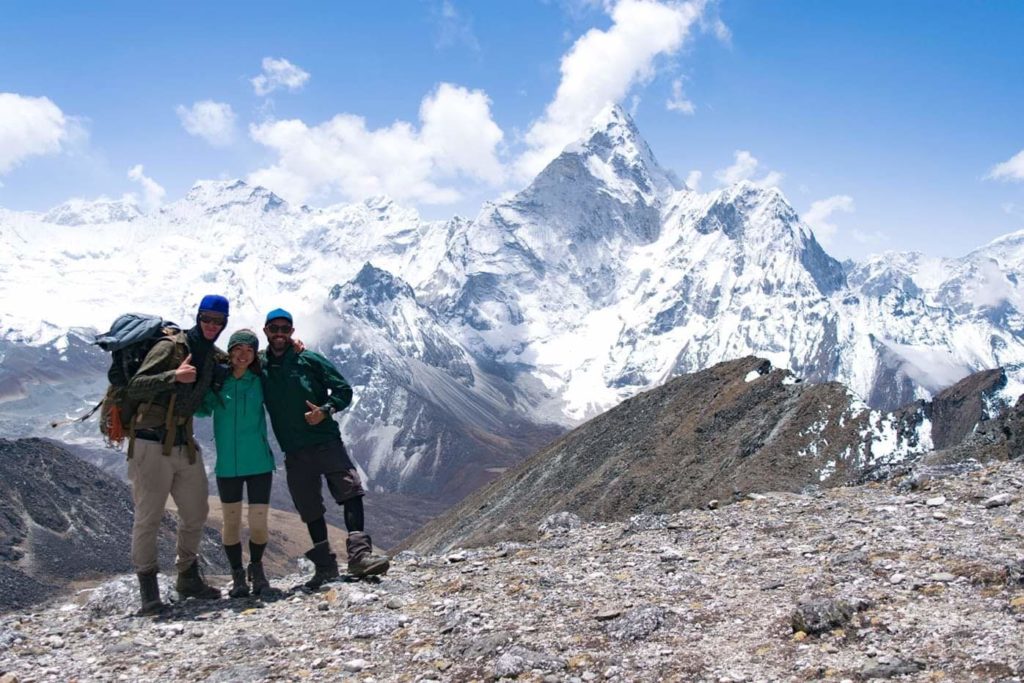
In the sections below I breakdown a range of backpacking budgets for Nepal, to help travelers create their own Nepal travel budget . If a shoestring budget is not your travel style, take into account the higher end of the Nepal travel expenses I’ve listed.
Where possible, I’ve listed the costs of my personal experience while backpacking Nepal on a budget. No matter your style, the cost of travel in Nepal is very backpacker-friendly!
Interested in the cost of trekking in Nepal ?
I kept that breakdown separate from this Nepal backpacking budget. See a breakdown of trekking budgets in my Ultimate Guide to the Annapurna Circuit and my guide to Everest Base Camp and the Three Passes Trek .
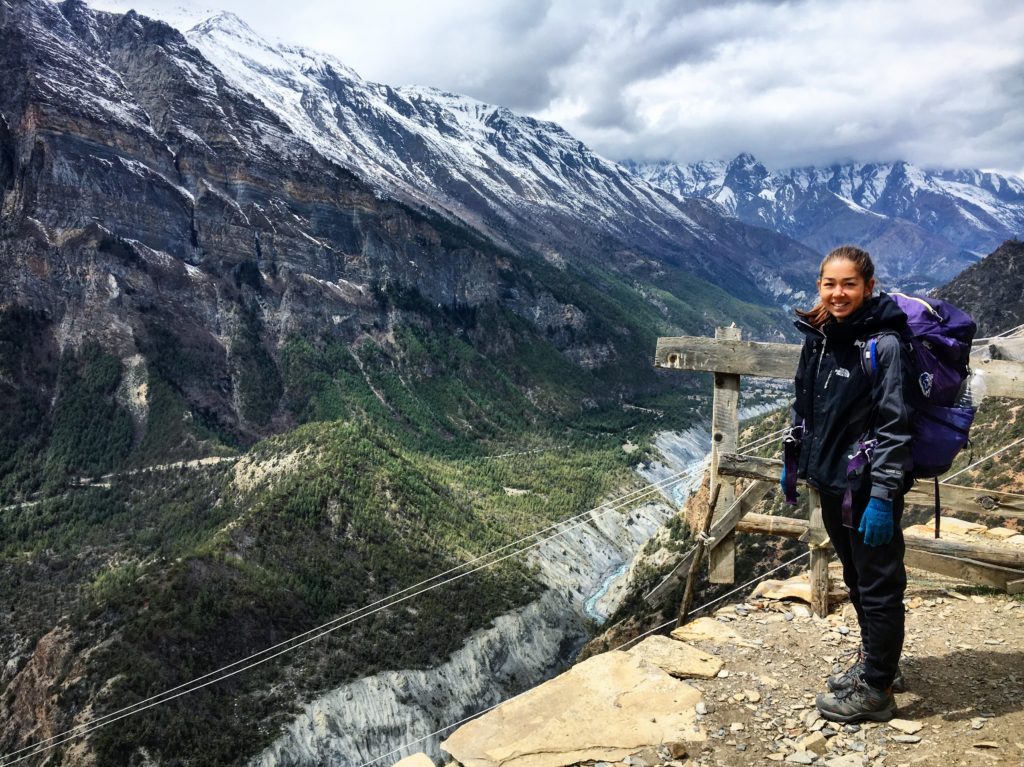
Skip to Nepal backpacking budget section:
Accommodation, food & drink, transportation, tours & activities, other expenses (sim card, trekking permits, trekking clothes).
Before you travel, be sure to check out the relevant COVID-19 restrictions in place in Nepal. The U.S. Embassy in Nepal website outlines testing requirements and quarantine requirements (for non-vaccinated travelers), and Nepal’s Department of Immigration website posts the latest travel notices.
Cost of Visas to Nepal
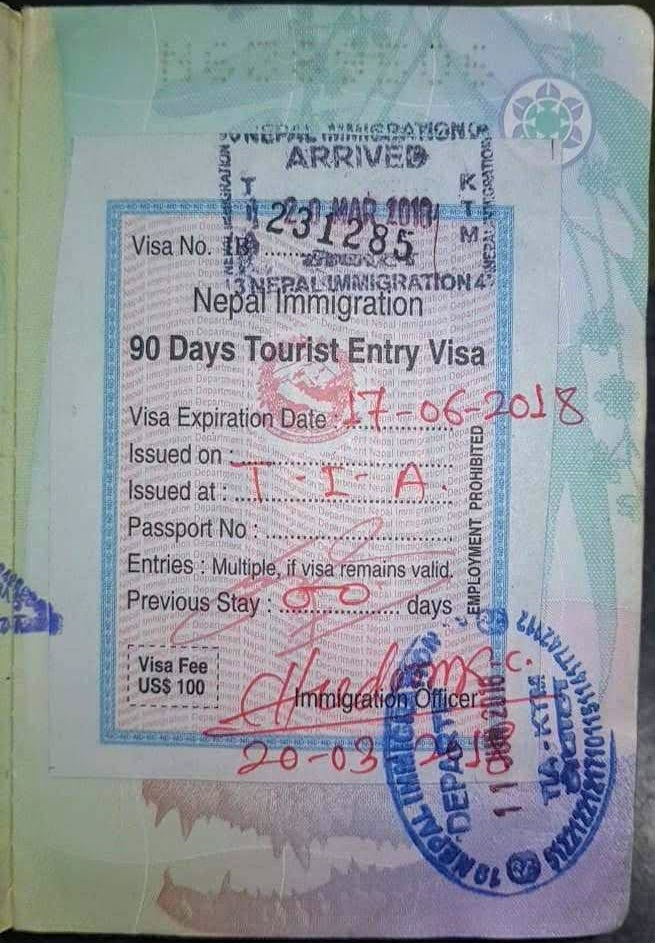
Before arriving in Nepal, check the latest visa and entry requirements for the country on the Nepali Department of Immigration website .
There are three different tourist visas on arrival that you can purchase in Kathmandu:
- 15 days for $30 USD
- 30 days for $50 USD
- 90 days for $125 USD
Visas can be purchased in your home country ahead of arrival in Nepal, or purchased at Kathmandu’s Tribhuvan International Airport. If you choose the latter, be sure to bring exact change!
Check out my backpacker’s guide to Kathmandu to read about what to expect at the Kathmandu airport.
Visa requirements for Nepal can be found for all countries at iVisa .
Accommodation Costs in Nepal
Stay ing in cheap backpacker hostels is a great way to keep your Nepal backpacking budget low. Both Kathmandu and Pokhara, the two main backpacker hubs in Nepal, have some amazing, cheap accommodation options.
Backpackers in Nepal can expect to pay from $2-$6 USD per night for a bed in a dorm room, and about double that for private rooms.
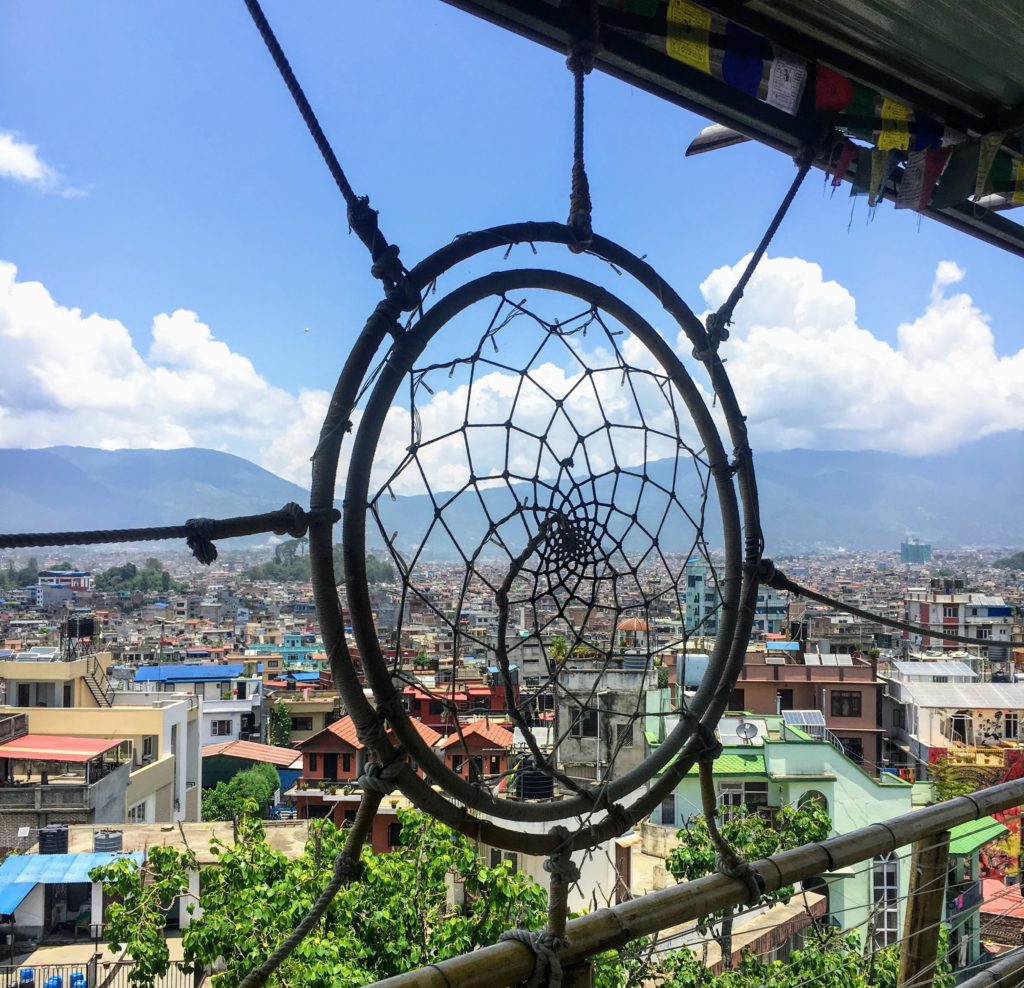
Here are my favorite backpacker hostels in Kathmandu, perfect for meeting other budget backpackers and finding trekking buddies too!
- Shantipur Hostel – Dorms from $2, Privates from $5 per night. Shantipur has an amazing rooftop overlooking Thamel, Kathmandu. Their restaurant on-site has delicious Nepali and Western food options.
- Alobar1000 – Dorms from $4, Privates for $14 per night. Alobar has a social atmosphere with a large rooftop seating area, with a great value restaurant on-site.
- Zostel – Dorms from $7, Privates from $20 per night. Zostel is a popular backpacker hostel chain from India. It’s slightly more expensive but with great facilities and top-notch reviews.
- Rest Up Kathmandu Hostel – Dorms from $3, Privates from $12 per night. Rest Up is another social hostel with a great rooftop and views over the Kathmandu valley.
Staying in a luxurious hotel in Nepal doesn’t have to break your travel budget either. Check out these luxurious hotel options in Thamel and treat-yo-self after a long Himalayan hike with a bit of budget-friendly luxury:
- Oasis Kathmandu – Plush private rooms with private bathrooms from $24 per night. Breakfast included!
- Himalayan Ghar – This aparthotel has super spacious rooms with kitchenettes and TV’s from $34 per night.
- Apsara Boutique Hotel – This boutique hotel has a spacious garden despite being centrally located in Thamel. Rooms with mountain or city views from $36 per night.
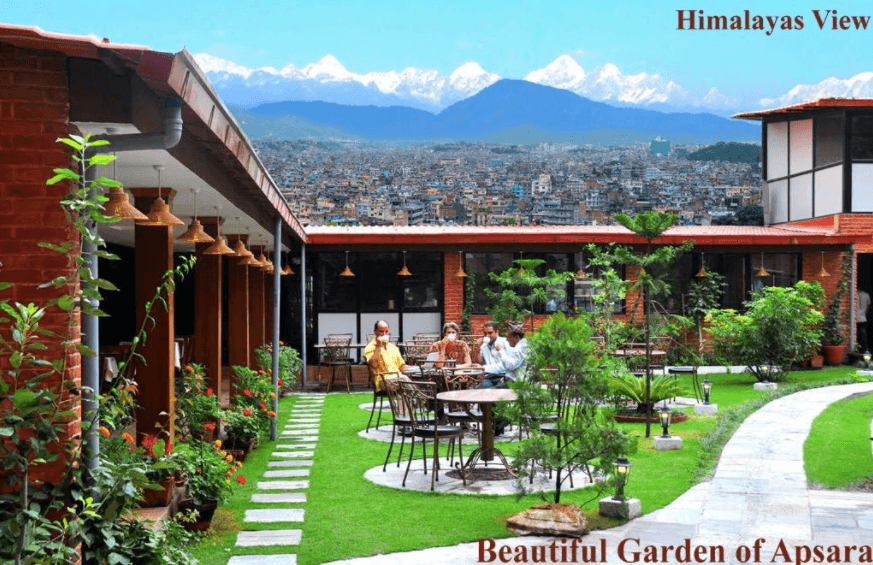
Food & Drink budget for Nepal
Eating like a local in Nepal is another way to reduce your cost of backpacking in Nepal.
Local restaurants all over Kathmandu and Pokhara serve Nepali classic meals for 100 rupees or $1 USD per plate. The most common meals for $1 USD are fried noodles, fried rice, thukpa (sherpa soup) or momo dumplings. Dal baht, one of my favorite vegetarian dishes from around the world , is a Nepali staple dish served with unlimited refills. It can cost anywhere from $1.50-$3 USD per plate but will leave you full for the rest of the day.
Restaurants serving Westernized food such as popular Israeli OR2K , or crepe cafes in Pokhara could cost you $3-$5 for a large meal. The staple Thamel pizza restaurants like Fire and Ice Pizzeria may set you back $5-$8 for a meal.
Standard drinks like tea and coffee won’t cost you more than $1-$2 USD in restaurants in Nepal. If going out for beers and cocktails though, expect to pay $4-$7 USD per drink.
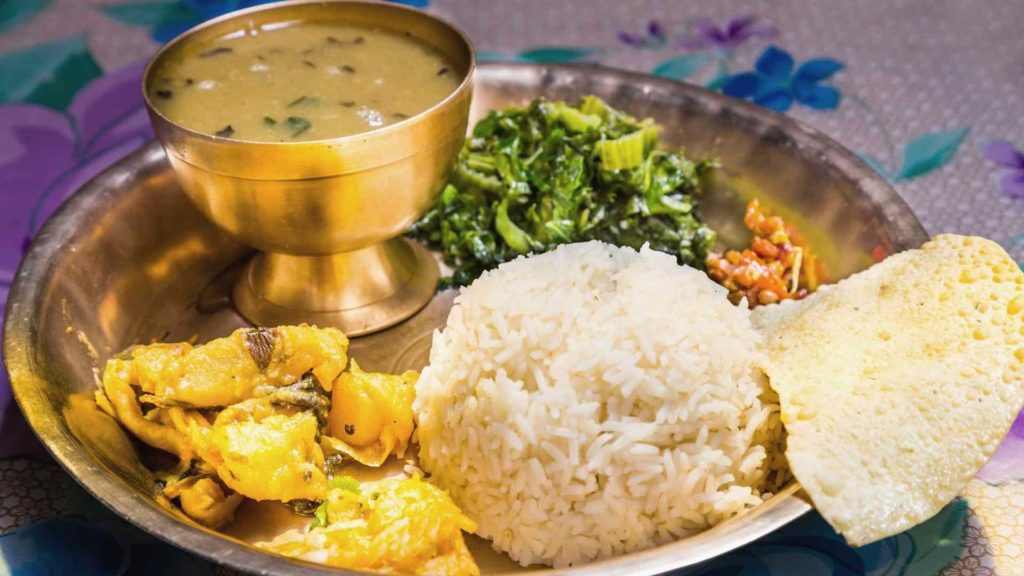
Transportation costs in Nepal
The most common way to get around Nepal is to take local busses and minivans. Local Nepalis and tourists alike take busses that criss-cross Nepal, connecting villages to the big cities. Within the cities, you can also take minivans or private taxis to different transport hubs.
- Bus/Minivan : A 1-4 hour bus or minivan ride can cost $2-$5 USD, and overnight busses may cost $10-$15 USD.
- Jeep : To get to trekking starting points from Kathmandu such as Besisahar (for the Annapurna Circuit), or Salleri (for Everest Base Camp), a seat in a jeep can cost $20 USD.
- Scooter Rental : In Pokhara, you can rent a scooter for 500-600 rupees, or $5-$6 USD per day
- Taxi : Taxi rides around Kathmandu usually cost around $2-$5 USD per ride. A taxi from the airport to Thamel, Kathmandu costs a standard 750 rupees ($7.50 USD). At night, drivers may charge $1-$2 extra.
- Flights : If you’re trekking in the Everest region, many backpackers opt to take a flight from Kathmandu to Lukla, which costs about $150 USD each way. If traveling Nepal on a tighter budget, consider taking a jeep to Salleri or bus to Jiri and hiking a few extra days to reach Lukla. More about that in my 20 Things To Know Before Hiking To Everest Base Camp .
Traveling slow using busses and local minivans instead of paying for private transport and flights will reduce your Nepal travel expenses. I recommend budgeting $10-$15 per week for transport while in Nepal, if trying to backpack Nepal on a budget. If you plan to take taxis and private transport often, budget about $20 per week.
If flying to Lukla to start Nepal’s Everest Base Camp hike, that’s another $300 USD to add to your Nepal travel budget.
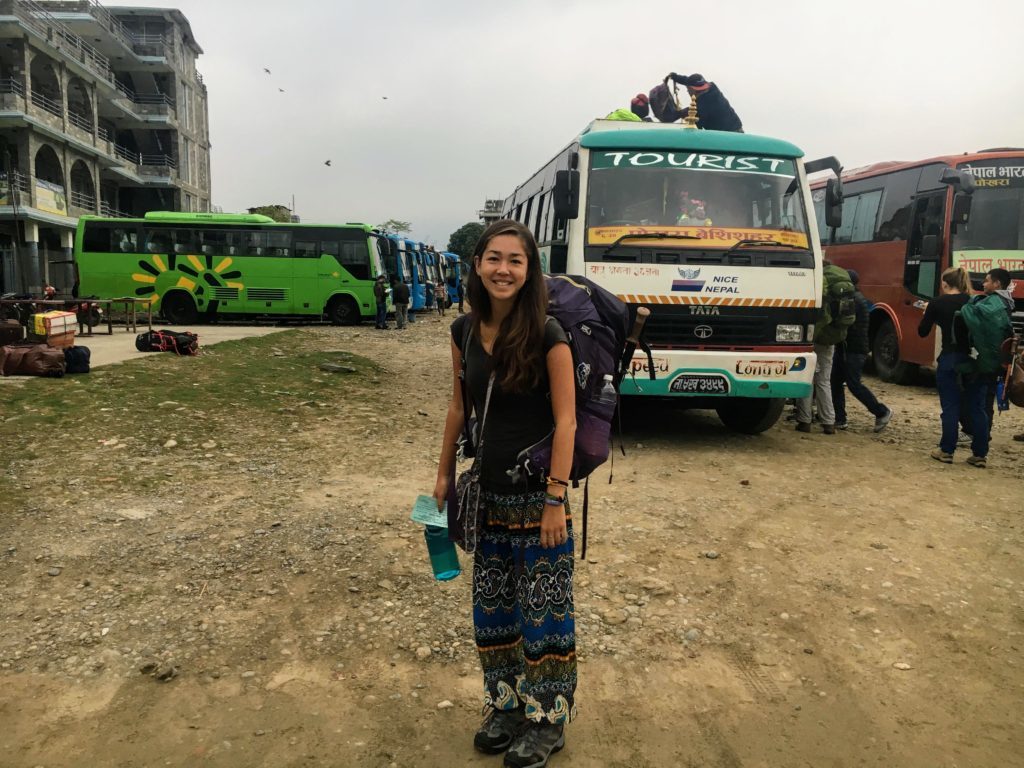
Tours & Activities costs in Nepal
The best way to spend your time backpacking in Nepal is to TREK! For budget breakdowns of trekking the Annapurna Circuit or the Three Passes Trek + Everest Base Camp, check out my other blog posts about Nepal.
- Annapurna Circuit Trek & Itinerary – 10-20 days, $25 USD per day + $40 for permits
- Three Passes Trek/Everest Base Camp – 12-25 days, $35 USD per day + $50 for permits
- Poon Hill Trek – 3-4 days, $20 per day + $40 for permits
The budgets above are for trekking unguided. If you prefer to join a group to embark on a Nepali trek, they’re easy to book online ahead of time.
Check out this tour on sale for $790 from Klook headed to Everest Base Camp, or the Annapurna Circuit on sale for $435!
Options from GetYourGuide start at $1000 USD per person for a 14-day trek to EBC.
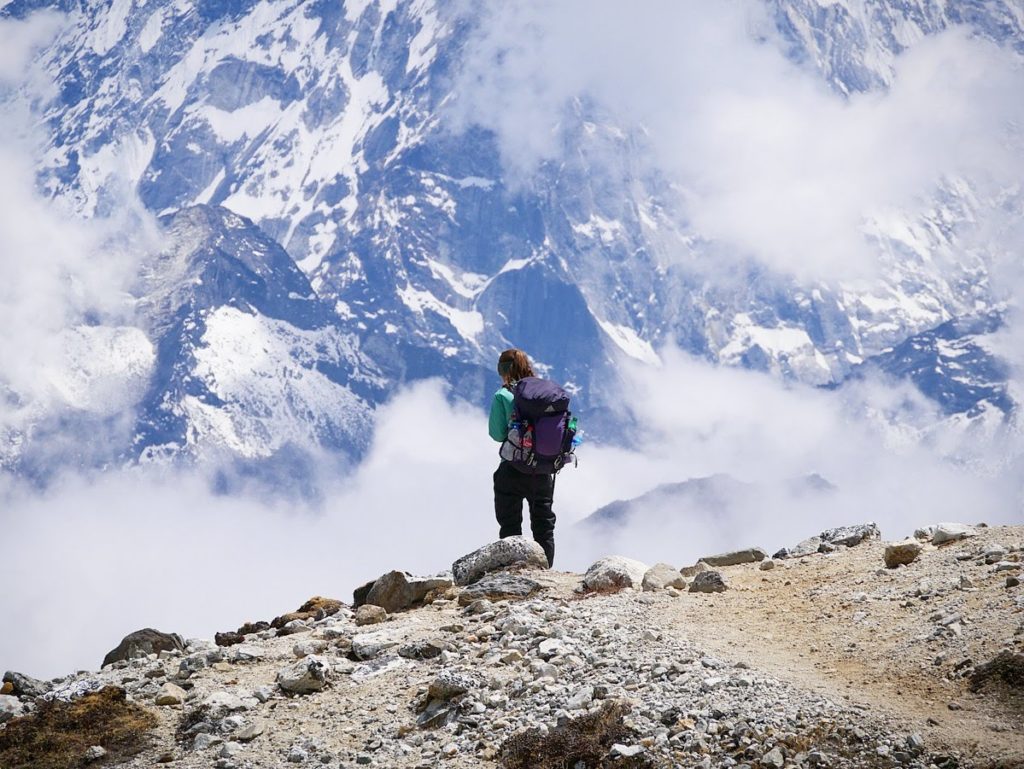
Other tours & activities that should be accounted for in your Nepal travel budget are:
- Monkey Temple in Kathmandu – 200 rupees, ($2 USD)
- Durbar Square – ~$15 USD entry fee
- Bhaktapur day-trip – $30 USD tour or DIY for ~$10 USD transport plus $15 USD entry fee
Most hostels will help backpackers book these activities at their in-house tour desk.
If you have room in your Nepal travel budget for some more epic adventures, check out these popular activities for backpackers:
- Paragliding in Pokhara – $85 USD per person
- Panoramic Everest flight (1 hour) – $180 USD per person
- Bungee jumping with a view of the Himalayas – $80 USD per person
- Whitewater rafting through the Nepali jungle – $45 USD per person
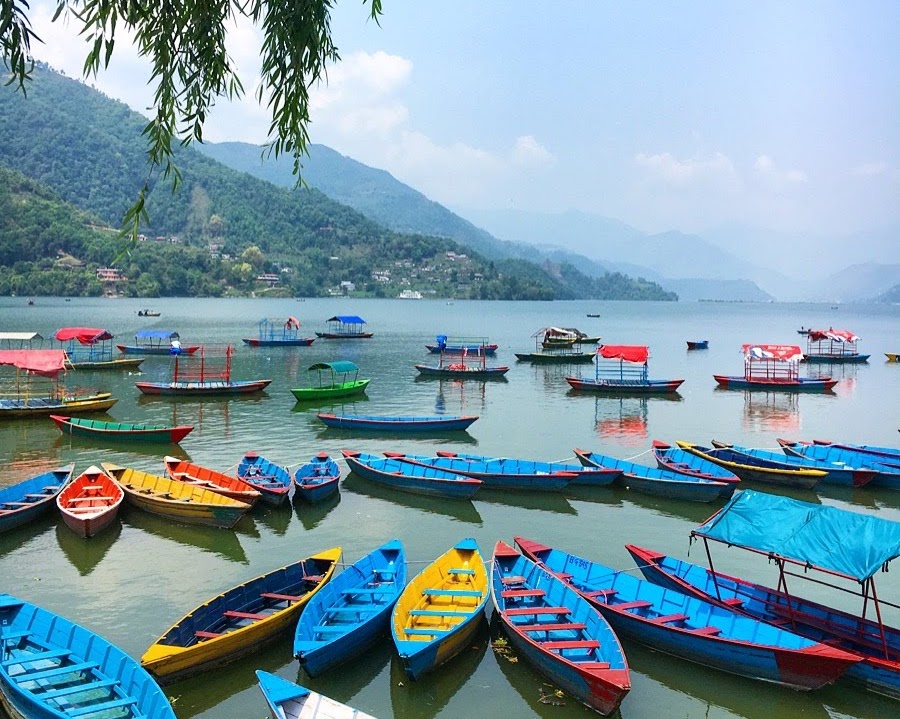
OTHER Nepal travel expenses
SIM card: I purchased a SIM card upon arrival in Nepal from NCell, which I found useful to have especially for navigation. Updated costs depending on duration and GB size can be found on Klook (for example, a 30-day SIM for 16 GB costs only $20 USD . Nothing that will break the bank!)
Trekking permits: The cost of trekking in Nepal includes purchasing trekking permits, which can range from $40-$50 USD.
Trekking clothes: Purchasing necessary trekking gear in Nepal could set you back $100 USD or more depending on what you need. Kathmandu has endless hiking gear stores though, so it could be cheaper to purchase cold weather gear, boots, and hiking poles after arriving in Nepal.
Gift shopping: The Thamel neighborhood in Kathmandu has plenty of gift shops to satisfy any souvenir shopping needs. A budget of $2-$3 USD for each person you need to gift shop for is plenty, considering you can haggle prices down when buying things like prayer flags, meditation bowls, jewelry, or incense.
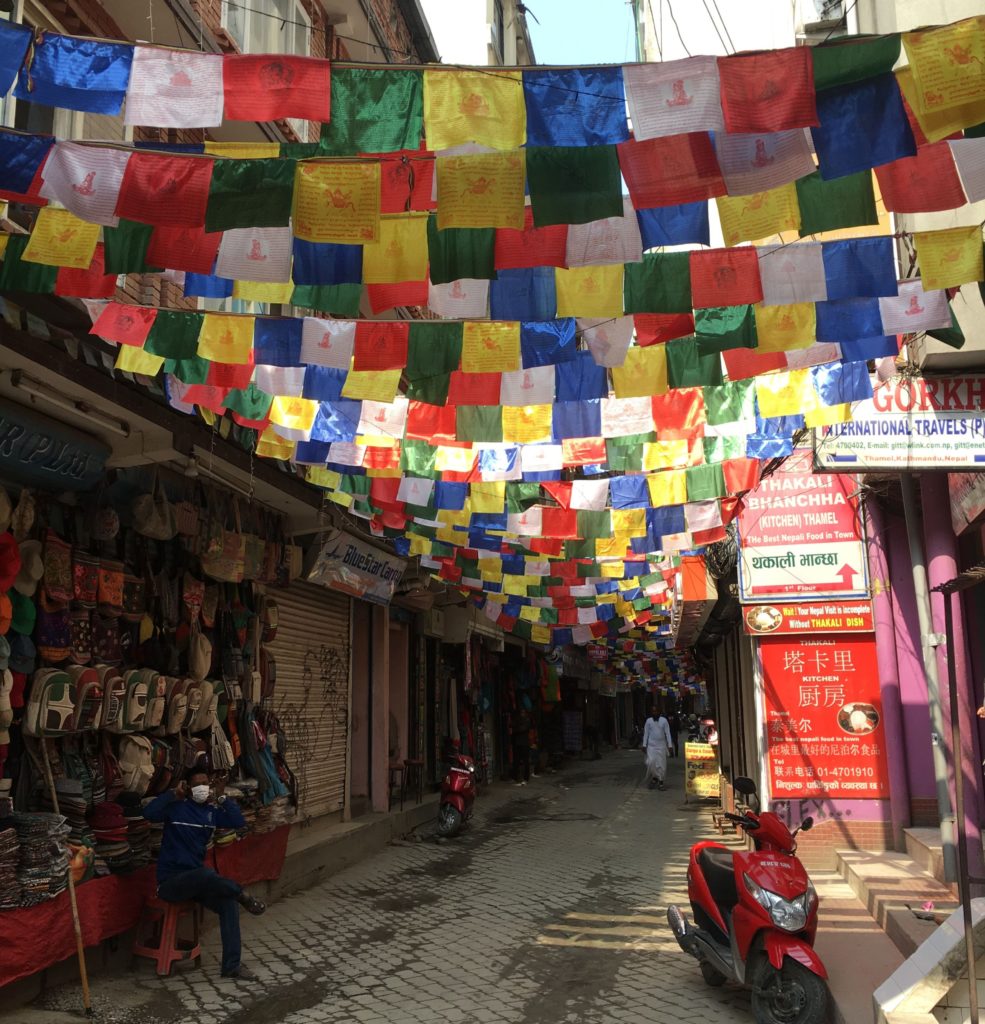
Summary - Total Cost of Backpacking Nepal
Excluding trekking costs, below is a breakdown of my Nepal travel budget for backpackers (in USD):
- Visas – $30, $50, or $120 USD depending on duration of stay
- Accommodation – $15-$20 per week
- Food & Drink – $25-$50 per week
- Transportation – $10-$15 per week, excluding flights to Lukla
- Tours & Activities – $25 per week
- Other expenses – $20 for SIM card (optional), $20 for shopping
Ranges of daily budgets for backpacking in Nepal
For different types of backpackers here’s a summary of my Nepal backpacking budget (in USD)
- Shoestring budget: $7-$10 per day, $70 per week
- Standard backpacking budget: $15-$20 per day, $140 per week
- Flashpacker budget (including some luxuries): $25-$35 per day, $245 per week
Remember to add to your Nepal backpacking budget the one-time costs of visas , trekking permits (if needed), key tourist activities , and a SIM card .
For more Nepal travel inspiration and more Nepal travel budget information, check out my other posts about Nepal!
- Decide for yourself which epic trek to embark on – Annapurna Circuit vs Everest Base Camp, which should you trek?
- Pack your bags before you go – The Ultimate Nepal Trekking Packing List
- Be prepared for trekking in Nepal (including the cost of trekking) – 20 Things to Know Before Hiking Everest Base Camp and 20 Things to Know Before Hiking the Annapurna Circuit
- Learn more about Kathmandu and Namche Bazaar
Save this Nepal Travel Budget - Pin this post!

You might also like:

Permaculture Course at Navadarshanam, India
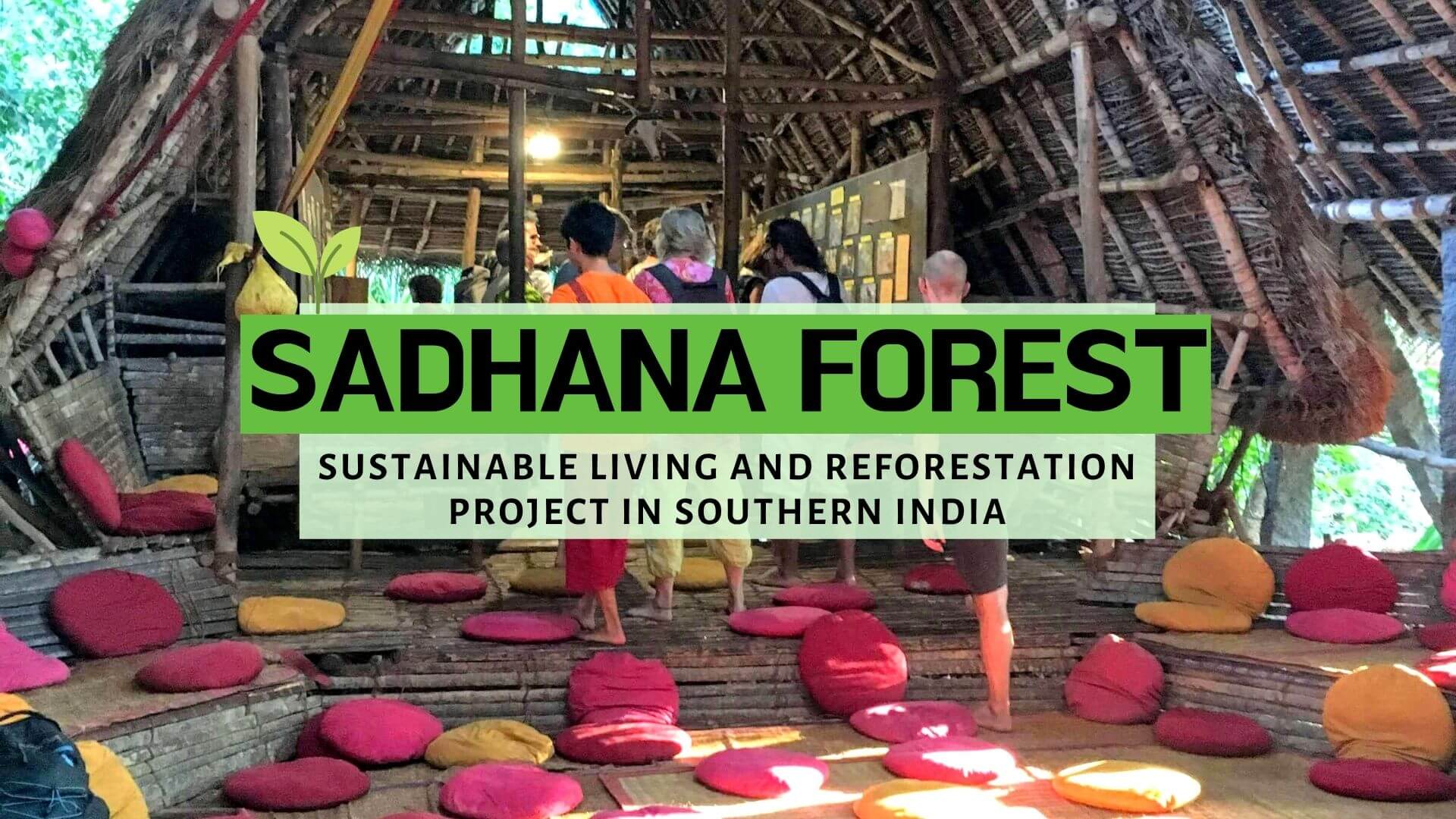
Visiting Sadhana Forest in Auroville
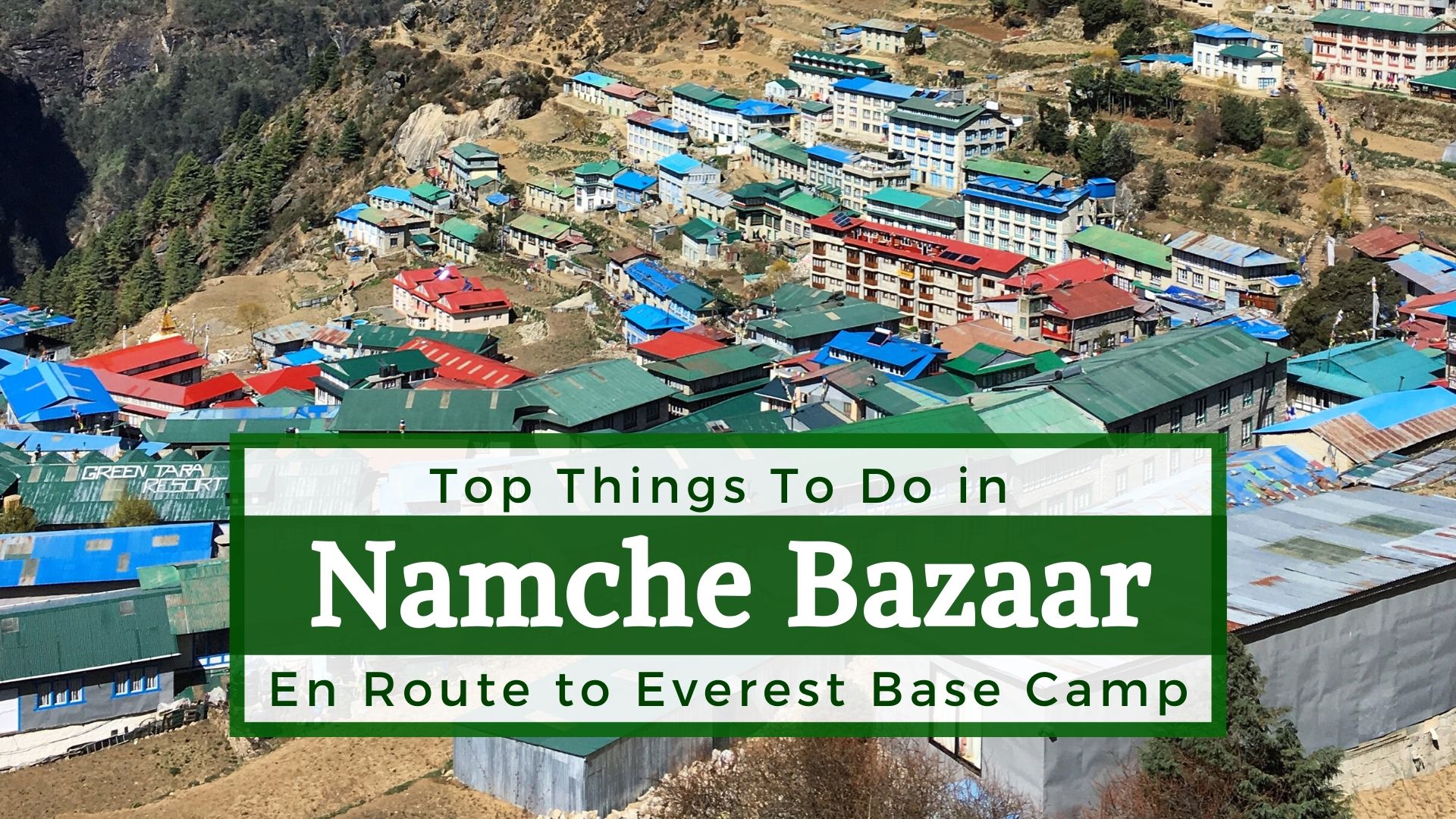
Best Things To Do In Namche Bazaar, Nepal
Leave a reply cancel reply.
Your email address will not be published. Required fields are marked *

COMMENTS
While meal prices in Nepal can vary, the average cost of food in Nepal is $8.47 (NP₨1,127) per day. Based on the spending habits of previous travelers, when dining out an average meal in Nepal should cost around $3.39 (NP₨451) per person. Breakfast prices are usually a little cheaper than lunch or dinner.
Travel Costs for Nepal. For travelers from Europe and America, Nepal is the most affordable destination in South Asia. General speaking, if you are looking for a comfortable trip (mid-range hotels) in the top destinations in Nepal, it will cost between 10,000 and 12,500 Nepal rupees (US$80-100) per day per person. ...
Average Solo Traveler. The average cost for one person to visit Nepal for a week is $788-$2,183 ($113-$312 per day) Food, Travel, and Sightseeing: $22 to $45 per day for one person's daily expenses. Flights: $448 to $1,574 for economy. Lodging: $35 to $49 per night for one 2 or 3-star hotel room. or $31 to $38 per night for a 1-bed vacation ...
Asia / Nepal /. For a trip to Nepal, you should plan for daily costs anywhere between $14 to $126. If there's two of you traveling, your daily expenses could range from $28 to $253. These price ranges are based on the average daily spending of $40 (NP₨5,296) per person which comes from the travel expenses of other visitors.
During my two weeks in Nepal, I spent a total of 5 days in the Kathmandu area, 3 days in Pokhara, 2 days getting between those two cities, and 4 days trekking. Here's the budget breakdown for two weeks in Nepal: Total: 38,331 NPR, or ~$369.45 USD based on the conversion rates at the time. That's about $26 USD a day!
Read the country information page for additional information on travel to Nepal. ... Average PCR test costs are $10-15, with expedited results offered for an additional fee. Most results are available within 48 hours. Expedited results may be available in as little as 6 hours. Results are typically sent via email and/or text message with a link ...
Here is the approximate travel cost of popular tourist routes in Nepal (including the day of arrival and departure) 4 days and 3 nights in Kathmandu (1 city): $200 - 300 per person 7 days and 6 nights in Kathmandu and Pokhara/Chitwan/Lumbini (2 cities): $450 - 650 per person
Nepal is one of the cheapest countries in Asia for travelers but costs can add up once you factor in activities. Try our tips for budget travel in Nepal. Read article. Best Road Trips. Nepal is famous for its trekking trails, but the roads offer plenty of adventures at less dizzying altitudes. Here's a guide to Nepal's best road trips.
Besides this, trained guides and porters are cheap by Western standards; about $10-$15 per day for a guide or $5-$10 for a porter (someone who can carry your luggage on the trek). It may seem a bit decadent to hire porters or a guide, but this service provides a valuable source of income to Nepal.
Safety. Nepal is a relatively safe place to travel, with a low violent crime rate of 2.1 per 100k inhabitants (69% lower than the global average). Crime is very rare on the popular trekking routes in the Himalayas. The biggest safety risks in Nepal are probably motorbike and auto accidents in big cities like Kathmandu.
Here are some tips for cutting your costs when traveling around Nepal on a budget. Avoid the high season. Flight, accommodation and tour costs peak during Nepal's October-November high season, which coincides with the best weather for trekking. For slightly lower prices, visit in the March-April shoulder season, which still sees good weather ...
How Much Does Nepal Travel Cost? Nepal is very budget-friendly and cheap to travel. Hiking and trekking will add some expenses, but even those are reasonable. A solo traveler can anticipate rock-bottom budget of $15 per day if traveling around. If you're volunteering some daily rates are in the $10-15 per day range to cover food and board.
But if you are going to rely on buses in Nepal, be prepared to take a long time even for short distances. Kathamandu is only 125 miles (200 km) apart, but the bus ride takes at least around 5-6 hours. The same journey takes around 35 minutes by plane, and the prices are very affordable. 🚖 Taxis in Nepal.
The cost of renting or buying an apartment in Nepal varies according to its location. On average, renting an apartment with one bedroom and a living room outside the city center costs approximately 15340 NPR (114 USD) per month, while the same type of apartment in the city center can cost around 24261 NPR (181 USD) per month.
Being a tourist in Nepal can be cheap, but cost of trekking and mountaineering in Nepal can be quite high depending on the type of the trek you choose and what comfort level you want. Trekking permits come at a high cost in Nepal. The typical cost of travelling in Nepal is given: Accommodation: Dorms in a hostel with shared bathroom: NPR 500-800
On average, the cost of living in Nepal in 2024 is 58% less than in the United States (USA). The graphic below shows the percentage of variation between prices United States in in the United States (USA) and United States by types of expenses: % Price variation between Nepal and United States in 2024 Restaurant Hotel Food Transport Leisure ...
Is Nepal expensive? Average travel costs. Paying for things and using credit cards. Safety. Other useful things to know. Where to go in Nepal. Nepal itineraries - from 7 days to 2 weeks. Plan your Nepal trip in just 60 minutes! Connect with one of our Nepal-based locals experts for a 60-minute travel consultation!
Asia ». Nepal. $787. Flights to Kathmandu, Nepal. Find flights to Nepal from $409. Fly from the United States on Air India, Cathay Pacific, Singapore Airlines and more. Search for Nepal flights on KAYAK now to find the best deal.
A great budget for 14 days in Nepal is around $1000 for a single person. Accommodation and food is cheap. Transportation could cost a bit more than its neighbouring country, but still good range. If you plan to stay in hostels, you can save even further and bring the budget down to $800 for backpackers.
In total, a budget traveler could expect to spend around 60,800-140,800 NPR ($507-$1,173) for two weeks in Nepal, not including flights. A mid-range traveler might spend between 135,000-310,000 NPR ($1,125-$2,583), while a luxury trip could cost 300,000 NPR ($2,500) or more, excluding flights.
However, planning a budget-friendly trip to Nepal might be surprising as you uncover the price and cost of essential elements in Nepal. According to statistical data, an average tourist spends around NPR1000 (7.55 USD) for a day's meal and around NPR 1,200 ($12 USD) on transportation.
How expensive are accommodations in Nepal: 19.2% of the total budget in Nepal. Total expenditures: NPR 40.595/ €319,29/ $351,77 Amount of nights: 29 Average price for overnight stay 2 persons): NPR 1.399/ €11,01/ $12,13 Hotels, guesthouses and tea houses are relatively very cheap in Nepal.
For different types of backpackers here's a summary of my Nepal backpacking budget (in USD) Shoestring budget: $7-$10 per day, $70 per week. Standard backpacking budget: $15-$20 per day, $140 per week. Flashpacker budget (including some luxuries): $25-$35 per day, $245 per week. Remember to add to your Nepal backpacking budget the one-time ...